100 tips, tricks and hacks from travel insiders
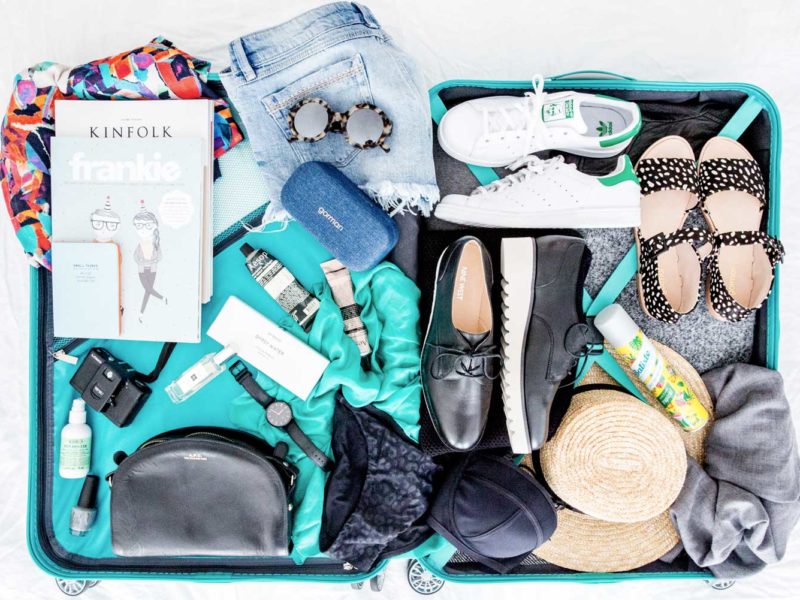
Last updated . 30 January 2020
When it come to travel, packing and flying can be some of the trickiest parts. It pays to have a few hacks up your sleeve…
We speak to some of the world’s most seasoned travellers to discover what you need to know when it comes to travelling the world without issues. Bookmark this and read up before you travel anywhere…

1. Invest in a good suitcase
Top packing hacks to help you master the art of a perfectly packed suitcase, by travel blogger and photographer Edwina Hart
Nothing will make the task of packing easier than finding a suitcase with all the right features. Pick something:
• Lightweight, as a case weighing a few extra kilos might mean that you won’t be able to pack your favourite shoes or even result in an expensive ‘oversized baggage’ fine.
• With wheels. It’s so effortless to zip around without having to locate an airport trolley.
• That has a protective casing made from polycarbonate, a must as there is nothing worse than finding your toiletries have exploded all over your clothes and electronics.
• With useful zip compartments to separate items and keep your suitcase neat throughout the journey.
• That’s brightly coloured so you can identify it immediately on the carousel among the ubiquitous black luggage.
• With an in-built lock to keep your items safe and secure.

Keep an eye on the time
Everyone knows packing last minute is the surest way to over-pack. By writing a list in advance you will cut back on unnecessary items.
Take a small bag for important items
You need one safe place to keep your phone, passport, credit cards, cash and boarding passes on your person, a secure over-the-shoulder bag that is easy for you to access and keeps your arms free to focus on other tasks.
Roll with it
Rolling your clothes instead of folding them makes your clothing items more compact and will save room in your case. Plus, it prevents them from creasing. Also, try rolling precious items inside your clothes as a great way of keeping them safe.
Choose your shoes wisely
No more than three pairs, please. One pair for comfortable walking (i.e. your trusty Converse), one for everyday chic and one pair for looking your best. A simple trick is to wear the heaviest pair on the plane to save luggage weight.
Travel-size items
Have a special travel makeup kit pre-packed at the ready so you can just grab and go. Essentials include travel-size items like roll-on perfume, moisturisers and hydrating lip balm to battle in-flight dryness, classic mascara, bb cream for easy coverage, lip gloss and dry hair shampoo. These beauty essentials will keep you looking glamorous wherever you are.
Pack a scarf
I could go on forever about the virtues of travelling with a scarf. Packing a few colourful scarves is a lightweight solution to completely change the look of an outfit. They’re also useful for using as a shawl if you’re cold on the flight, bunching up to create makeshift pillows on trains, as a nifty blindfold if you need to sleep on the road and a necessity if you’re travelling to places that require a certain level of modesty.
Hold onto your hat
In the summer a hat keeps the sun off your face, in the winter it keeps you warm, and it will jazz up any outfit too. Best of all, after a long-haul flight, when holidaying in extreme humidity or after a few days on the road without a good shower – you can cover up that terrible mess your hair has become.
Invest in a good travel camera
It should be lightweight, compact and give you all the creative control you need.
Always leave a bit of space in the bag
You never know what treasures you’ll find on your travels. Make sure that you leave enough room in your case so that you don’t have to part with that beautiful, once-in-a-lifetime object that will forever remind you of your amazing holiday.
2. Seize the day
I’m Not sure it’s unique to me but ‘don’t wait’ would be my recommendation. If the feeling takes you, book a holiday and get out and explore. Doesn’t need to be an adventure overseas; it can be as simple as a night staying in an AirBnb a few hours from home. Travel resets the senses, allows you to look at the world through a new lens and always makes memories to treasure – even those epic travel fails turn into humorous stories when enough time passes! Kristen Angus, marketing communications manager Australia, VisitBritain
3. Go plastic-free
I’ve created my own plastic-free travel kit that I can throw in anytime I’m packing for a trip: reusable coffee cup, water bottle, metal straw and a carry bag that folds up to the size of a business card. And while some air hostesses still seem annoyed to fill up my bottle rather than hand over a small plastic water bottle, I feel I’m at least doing what I can to help reduce single-use plastic waste during transit. Celeste Mitchell, travel journalist
4. High and dry
Packing well is all about items that can do double duty. I always take a waterproof ‘dry bag’ as my toiletry bag – it’s easy to throw stuff in quickly on hotel check-out and it can be packed in my luggage loose or rolled up. Once on a trip, I’ve used it to protect my camera on boats and in monsoonal rain; as a back-up sick bag (a godsend to have in the car with a carsick child); even as a rainwater collector on a Vanuatu beach for the freshest of refreshments! I like the Scrubba bag, an Aussie invention, which also has little washboard-style corrugations so I can use it as a washing machine when it’s not doing all that other stuff!
Jac Taylor, travel, food and lifestyle media specialist
5. Travel enhancers, for free
There are these amazing little travel enhancers that will cost you nothing, says travel writer Elspeth Callender
SPEAKING A FEW WORDS AND PHRASES in the local lingo of a destination will say a lot to the people whose country you’re visiting. It’ll communicate that you know where you are (not every tourist does). It sets you apart from the last traveller they encountered (who didn’t even try). It suggests you give a hoot about the place you’re in beyond what you can take from it; that you believe in cultural exchange.
I USED TO GET DESPONDENT and self-conscious about being a monolingual moron but now I try to work with what I have: a decent memory and a reasonable ability to parrot pronunciation, at least enough to be understood. I’ve also lost the fear of making a fool of myself and, rather than mumbling my foreign words, I speak them with a boldness incongruous with my linguistic inabilities.
BEFORE I GET ON A PLANE I make sure I have, at the very least, hello and thank you. For languages that come more naturally or if I’m going to be somewhere for an extended period I aim for good morning, good evening, thank you, you’re welcome, please, excuse me, one, two, three, four, five, coffee, milk, sugar, sausage, goodbye, fantastic, delicious, of course and maybe.
REPETITIVE LISTENING LODGES NEW WORDS and the right intonation in my brain, and there is a world of aspiring teachers on YouTube to help do that, so find your favourite. Write things down, have them on your phone, keep listening and asking while travelling, whatever works for you. Return journeys can really build on your vocabulary especially for buying food and speaking slang.
IN TOURISTY PLACES, WHERE PEOPLE ARE BUSY and tired of outsiders, trying to use your local words beyond simple greetings isn’t always appreciated unless you’re fluent. But where there’s little or no English spoken or you’ve veered off the beaten path you’ll really notice the effects of your attempts. Technology now allows us to converse with each other even if we don’t share a language at all, and those apps have their place in breaking down barriers, but I never want to stop looking strangers right in the eye and saying: “Buongiorno, un caffè per favore”.
6. Have kids, will travel
It sounds obvious and super-boring, but identifying potential ‘d’oh’ moments before your trip really helps with long flights. For example, there’s nothing worse than rummaging around your bag in an economy class seat or a tiny plane toilet for nappy supplies, so when our son was a baby we packed a nappy and plenty of wet wipes into individual disposable nappy bags for quick, easy access. Keep dummies, special toys and comforters in side pockets; and pack extra small bags to stash any dirty clothes for washing once you reach your destination. Also, pack a bag of colourful balloons in your hand luggage: they’re cheap, tiny to carry, and provide immediate boredom relief in case of emergency.
Nikki Wallman, travel and lifestyle writer
7. Stay well oiled
I travel a lot and planes are unfortunately a singer’s worst nightmare when it comes to germs, recycled air and getting sick. Lavender oil is a must for me, it’s antibacterial and so damn relaxing. Aromatherapy works on me quickly and no one next to me has ever complained if I’m dousing the stuff here and there! Also, I use paw paw ointment for dry lips and even nostrils, as dryness leads to cracking and anything cracked or dry will let the germs in quicker. Have a hydralyte or any other kind of super-hydrating tablet or drink on hand, so you can keep your insides hydrated as well. All sports people do it, I hear, and hey – we musos are kind of like athletes too!
Ella Hooper, musician, Killing Heidi
8. A few travel essentials
Sophie Miura is a senior editor at MyDomaine . An Australian in New York, she flew for more than 200 hours last year on assignment, and shares her travel essentials here
Make the most of disposable hotel shower caps by using them to cover shoes when packing. They’re the perfect size to fit around one pair of shoes and shield the contents of your bag from dirty soles.
I follow a simple sleep routine on long-haul flights and it works every time. First, I put earplugs in to muffle engine noise, then I wear over-ear headphones and play storm sounds via the free Rain Rain Sleep Sounds app. It’s so soothing.
DOCUMENTING TRIPS
Rather than keep a travel journal – something I never have time to do, no matter how well intentioned I am – I buy one postcard in each destination and write bullet points on the back about my favourite memories. It’s not a laundry list of attractions; rather, I try to write about smells, sounds, and fleeting interactions that I’d otherwise forget.
9. Bag it up
One for the ladies: when flying, I never take a handbag. I travel through security with a backpack and a folded-up soft fabric bag inside, which acts as my handbag while travelling. On board, my backpack goes overhead, and the soft bag, now filled with all my in-flight essentials, under the seat in front.
Lisa Perkovic, travel expert, Expedia
10. Sleep well
I am a big believer in melatonin: a great natural way to ease the effects of jet lag, especially useful when flying between Hong Kong and Miami and dealing with the 12-hour time difference.
Toby Smith, managing director, SWIRE Hotels
On the ground
11. get the lay of the land.
If I am arriving in a foreign city on my own and have the luxury of time I will search for a hop-on hop-off tour bus as my first port of call. This is a great way to become oriented with the layout of the city and to work out what I would like to visit. I will then walk the city areas that I want to see. I will always visit the local markets as this is a great way to get an insight into the people and products available. Many markets also offer a place to eat local food and it is always cheap. A great way to become accustomed to the value of the local currency is to walk through a supermarket or corner store, taking mental note of the prices. This immediately gives you a reference point for the value of the currency and helps you to become accustomed to converting the currency in your head.
Marika Martinez, founder and director, Women’s Own Adventure
12. Download maps
Maps.me and Avenza Maps are among my favourite travel companions. Both use satellite, thereby avoiding the need for internet – and costly data. The catch is that maps for both need to be downloaded before travel when you do have good wi-fi. Like Google Maps, Maps.me is free and shows your location on the map. You can save locations – your hotel for example, which helps when you’re returning on a bus from a different direction later. It also shows walking tracks, so you can be confident you’re on the right path. Avenza Maps is the topographical version. It charges per map downloaded and the app is a little clunky – but it’s invaluable when you’re in a remote mountainous area.
Michele Eckersley, public relations manager, World Expeditions
13. Just buy it
One of my favourite reasons for travelling is not only gaining inspiration for my design practice, but also bringing home the spoils! Weaving in objects and art from diverse cultures has become a signature of my work. My travel trip would be to travel as light as possible to leave ample room in your suitcase for new finds. And be sure to travel with your FedEx account number! Beautiful objects, craft and art are everywhere. If you see something you love – buy it! It is these unique pieces that tell your personal story and add the layers to your house. Also, be sure to seek out the shops at local museums and art galleries, as they are always a great trove of design and perfect for gifts.
Thomas Hamel, interior designer
14. Don’t forget to bring cash
While we live in a cashless world, it is essential to carry some currency for the local markets, cab fares and in most regions, tips (which go a long way to receiving good service).
Mike Smith, public relations and marketing general manager, World Trade Travel
15. Stay residential
When I travel, I like to experience the place like a local, so where possible, I will pick a hotel that is located in or near a residential area. It’s eye-opening to experience a country from a local perspective and see how their habits differ or are the same from place to place. It’s hard to feel the authenticity of a place and its people when staying in city centres or touristy areas, but as soon as you step out a little bit, everything changes. Often, you will find that people are friendlier, in less of a rush, more relaxed and genuine, and things are cheaper!
Florence Pasquier, sales director, Rail Europe
16. Go with local guides
Don’t be afraid to travel on your own as part of a group tour – you could end up meeting the love of your life like I did in South America! Or perhaps if love is not in your sights, new friendships or just the company, security and peace of mind of exploring with other people. Secondly, there is no greater investment when travelling than paying for a local guide. They have first-hand local knowledge of their city, town, culture and traditions. If you truly want to learn and experience your destination of choice, then pay for a guide rather than just taking yourself around the local sights. You will hear enriching stories of their life, and they know all the best places to eat, grab a cold beer and access experiences you may not have ever heard about.
Emma Prineas, acting head of marketing, Wendy Wu
17. Be curious
Ask questions of anyone and everyone you meet when you travel. From your taxi driver to your waiter to the front desk clerk and the guy next to you in line at the store. Find out what they love about where they live and any unique spots that you should visit. Everyone enjoys sharing what’s special about their hometown and you’ll learn something new every time. And who knows, you might even make a new friend. Jennifer Vandekreeke, vice president Australia, Carnival Cruise Line
18. Only human
I find, both as a hotelier who oversees thousands of staff and as a regular traveller on the other end of that equation, that it’s always helpful to remember that people are, at the end of the day, human. The human element is what always takes a great hotel up into that top level, and equally, all people are by nature, sometimes fallible. It’s good to remind oneself when something goes a bit wrong that most people at a hotel are usually genuinely trying to please. I’m by nature very exacting and impatient, so I find that reminding myself of this has helped me relax and roll with the situation. As a perspective shift, it’s priceless because it can be the difference between a ruined day of your holiday and a salvaged one. Guy Heywood, COO, Alila Hotels and Resorts
19. Keep it charged
Bring a power board with you as well as a plug adapter so you can charge multiple electronic devices at once – cameras, mobile phones, laptops and toothbrushes etc.
Ryan Bennett, brand leader, Bentours & Hurtigruten
20. Be safe as a solo female traveller
Journalist, author and commentator Dilvin Yasa’s guide to conquering the world deftly and safely as a solo female traveller
Connect with other females
Sign up with networks that work to connect female travellers from around the globe, such as Wanderful and Pink Pangea. Through these sites, you can get recommendations from like-minded women, seek advice from locals on various customs and, if the solo thing gets a bit too lonely at times, you can even organise to meet up during your travels.
Nominate a contact
You already know to register your travel details with smartraveller.gov.au and to leave an itinerary with someone back home, but also be sure to set up a daily point of contact with someone you’re close to at home. It could be something as simple as a daily 5pm WhatsApp message to let them know you’re safe and thriving.
Pack sensibly
You’ve packed your toothbrush, deodorant and a pair of hiking boots. Now throw in a rubber doorstop to wedge under hotel room doors, a whistle to carry in your pocket and perhaps even a cheap wedding band which can be a simple and effective way to keep unwanted admirers away and out of your hair.
Investigate broadly
Conducting research on hotel/hostel reviews is essential, but just as important is seeking reviews on the neighbourhood the property is located in so you can see whether it’s safe or not. Sites such as Oyster, TripAdvisor and Hotelz will often allow you to search both.
Talk to hotel rooms
Never admit you’re travelling alone. If anyone asks, your boyfriend Bazza is back at the hotel aggressively pacing the room wondering where the hell you are. To make this story seem more authentic to neighbouring hotel guests, always be sure to yell out a quick, “Okay baby, see you shortly!” as you head out the door.
Salute the sun
Always plan to get to your destination well before dark, but should you find you haven’t quite made it and need to walk a distance, walk out on the road where you can. This reduces the risk of being pulled into dark alleys, doorways and parked cars unseen.
Start simple
Not sue if you’re ready to brave the streets of Mexico City by yourself just yet? Consider earning your solo traveller wings first by joining a tour group such as On The Go Tours (onthegotours.com). Within each group, 40 per cent are solo travellers, and there is no compulsory single supplement on group tours. Fancy a walking or biking trip instead? Butterfield & Robinson (butterfield.com) has a range of great trips for solo women including Italian Lakes Walking, and Vietnam and Cambodia Biking.
Back yourself
Sure, we could tell you to remain sober at all times and to dress conservatively (important tips to note regardless), but ultimately everything comes down to your flight or fight response, honed over millions of years of evolution. If your gut is telling you something doesn’t feel right, listen to it and seek safety. As much as we want to shrug things off as paranoia, your first instinct is usually correct.
Check out more of the best 100 tips, tricks and hacks from travel insiders by category
Europe | Beaches and islands | Classics | Hacks | Food and wine | No place like home | More for less | Off the beaten track | Asia
LEAVE YOUR COMMENT
Cancel reply.
Save my name, email, and website in this browser for the next time I comment.
You might also like

The best travel gadgets for your next adventure
If you spend a lot of time travelling, firstly, you’ve come to the right place. And secondly, you will be well aware of the advantages travel gadge...

What to do when it rains in Wellington
Hold onto your hats in ‘Windy Wellington’, as some like to call it. This compact city is full to the brim. Colourful houses perched on the surrou...

The best travel experiences to have in your 50s
If 50 is the new 40 then it follows that the destination birthday celebration now belongs to the quinquagenarian too. Here, a few suggestions on wher...
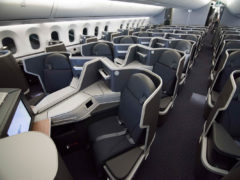
Review: American Airlines Business Class
Quentin Long settles into a Business Class seat on an American Airlines 787-9 Dreamliner from Sydney to LA. American Airlines flies comparatively und...

A family holiday, the Samoan way
Put the ‘family’ back into your family holiday by embracing Fa’a Samoa. Looking to reconnect with the kids on your next family holiday? Say no ...
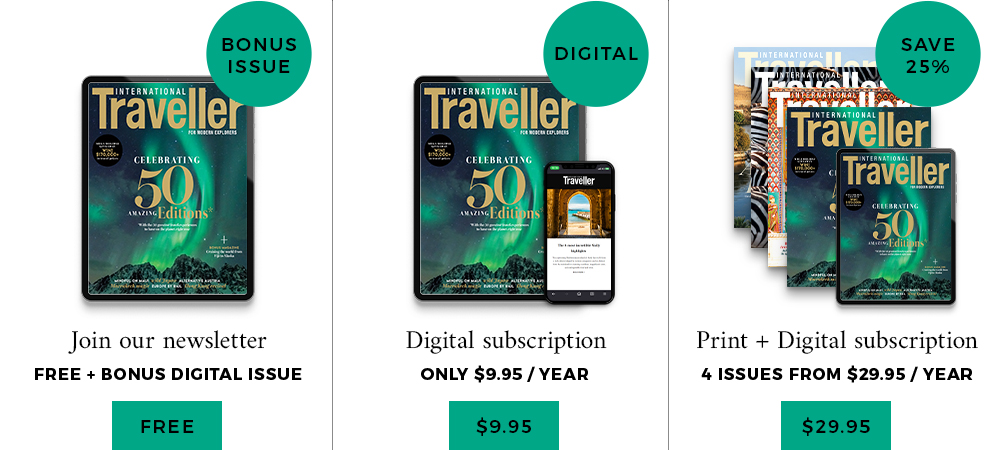

How To Travel The World Cheap: 57 Epic Budget Travel Hacks for 2024!
There are lots of practices you can adopt in order to travel the world cheap . The most effective ways are to take advantage of Airmiles, exchange work for free food and accommodation, have a well researched travel plan and to be savvy with bank cards and money exchanges.
Since 2008 I’ve travelled all over the world on a fairly tight budget, often working as I go. In this guide I want to share 57 cheap travel hacks that I’ve picked up which will have you exploring the globe for less.
So, let’s get straight into it!
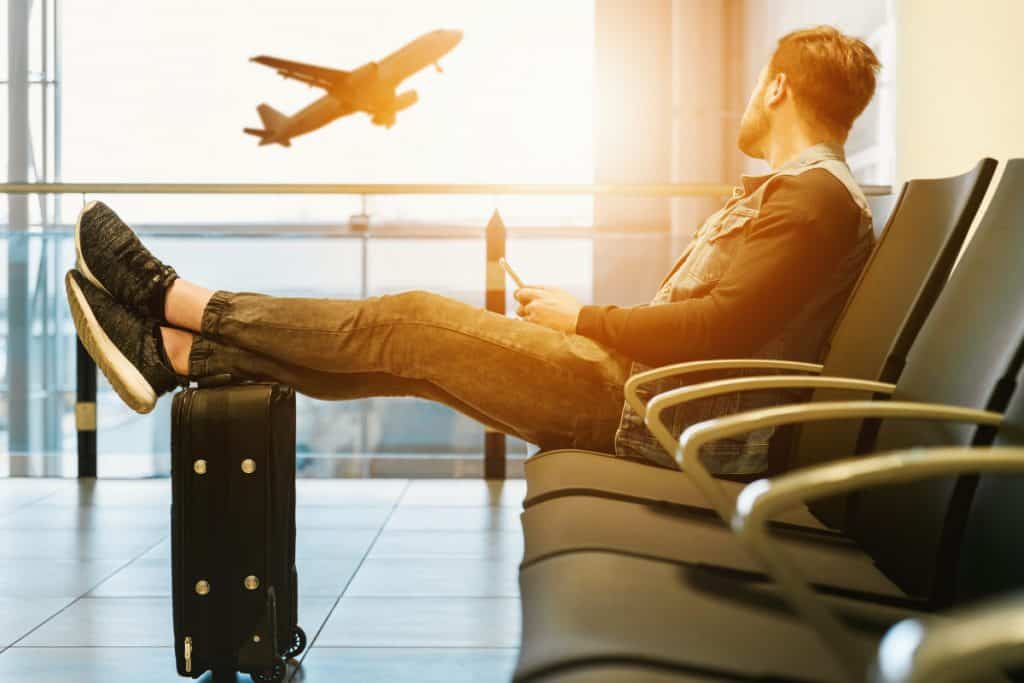
Transportation Travel Tips & Hacks
1. Flight booking hacks. One of the biggest initial costs when travelling is your flight ticket. So in order to travel cheap, use flight comparisons sites such as Kiwi . You may find booking directly through the airline is cheaper but always use a price comparison engine to check before you book.
Pro Tip : Make sure to clear your cookies and browsing history to avoid price increases. By searching for flights you are signalling to the world that you are looking to buy, so prices will then increase daily in order to get you to panic buy. Delete cookies or browse in incognito mode to avoid this. @import url('https://fonts.googleapis.com/css2?family=Inter&family=Inter:wght@500&family=Noto+Serif&family=Noto+Serif:wght@500&display=swap'); .tp_wrapper { font-family: 'Inter', sans-serif; /* the font, can be replaced with 'Noto Serif' */ max-width: 1024px; } .tp_content { background-color: #DEE9F0; /* main block background color */ padding: 24px 32px 32px; } .tp_subtitle { margin: 0 0 16px; font-size: 22px; font-weight: 500; } .tp_text { font-size: 17px; font-weight: 400; line-height: 145%; margin: 0; } .tp_button { display: inline-block; background: #2A243B; border-radius: 6px; box-sizing: border-box; cursor: pointer; color: #fff; font-size: 20px; margin-top: 24px; padding: 12px 32px; text-decoration: none; }
2. Try changing the home location of flight booking websites to see if purchasing in another currency is cheaper.
3. One of the cheapest ways to travel is through offering to get bumped off a flight in exchange for a flight voucher. These can be seriously rewarding! Companies will regularly overbook flights on the assumption that people will cancel or not show up. On those times when this doesn’t happen the airlines need to free up seats quick, and that’s where you step in!
4. For short trips choose carry on only or if you need to check baggage, pay for it online before you travel. Airlines will often charge more at the airport.
5. Save on rail travel costs by using railcards. I saved a ton through using the Japan Rail Pass during one visit, however they only save money if you use them to the full so do the research first. Also consider using overnight trains to save on accommodation costs. This works great in some countries such as India and is an awesome local experience too.
6. If you feel comfortable, consider hitchhiking. Alternatively, connect with other travellers at your hostel to carpool.
7. If you have a flexible plan, investigate relocating vehicles to get free or discounted car hire.
Consider renting a car with Rentalcars , an international car rental booking service that is present all over the world. With Rentalcars you will definitely find a perfect car for your perfect trip wherever you are.
8. When travelling for long periods save money through walking or using buses, instead of using expensive taxis. Use ride sharing apps such as Uber, Lyft, Cabify and Grab. Uber opened the door for cheap car journeys but now there are lots of different companies operating all over the world. Research which ones are best for the areas you’re traveling too and download the app before you go.
9. One of the biggest ways to traveling on the cheap by far, is to use an Airmiles credit card. Every time you spend money with that credit card you will be earning Airmile points which can be exchanged for flights. Just remember to always pay off your credit card every month to avoid high interest fees.
10. Create frequent flyer accounts with every airline you travel with then sit back and enjoy the rewards.
11. A top sneaky travel hack is to jump on airline price errors. Sometimes airfares can pop up at crazy low prices, often caused by a glitch in the Matrix (or something!). If you manage to purchase one of these flights the airline will often honour the incorrect price. Act fast and take advantage of these opportunities by following these ninja websites:
- Secret flying.com
- Jacks Flight Club (UK) or Scott’s Cheap Flights (US)
- The Flight Deal
12. Pack light and smart to avoid excess baggage fees. Roll your clothes or use packing cubes to save on space.
13. Take advantage of layovers to enjoy a quick city visit without any extra flight costs.
14. Try booking two one-way trips rather than a return. I’ve had success with this on flights and rail trips.
15. Keep receipts for gift purchases and claim back the tax at the airport before you leave the country.
16. Travel by campervan. If you’re looking to explore your own country (or continent), consider buying a campervan to combine your method of transportation with your accommodation. My campervan has been one of the best investments I’ve ever made and I can highly recommend it. For all the latest info on converting your own campervan check out my van life section .

Accommodation Travel Hacks
17. Get cheap or free accommodation through housesitting . With housesitting you will generally look after the persons house whilst they are away. Many housesitting jobs often include pet sitting.
18. Get free accommodation and learn all about life from a local through couch surfing .
19. Pick accommodation with free breakfast to save on food costs.
20. Choose private hostel rooms instead of more expensive hotels.
🏨 Where can I find the cheapest hostels?
You will definitely find the hostel you need with Hostelworld , the global hostel-focused online booking platform, inspires passionate travelers to see the world, meet new people, and come back with extraordinary stories to tell.
21. Use booking.com ‘s price matching promise to get the best price on hotels.
22. Travelling on a special occasion? Be sure to let your hotel know and they might offer you a free upgrade.

Work Abroad
23. Exchange work for accommodation and/or food with companies such as Workaway or World packers. Or, if you want to learn about organic growing, check out WWOOF .
24. Earn a passive income to support yourself whilst travelling. There are so many ways to get a side hustle going these days but some examples include;
- Selling your photos on stock photography websites such as Dreamstime or Shutterstock.
- Starting a website. Make sure you use a fast and reliable host. For my websites I use Siteground .
- Selling your photos directly with a website that does it all for you. I use Smugmug .
- Teaching English online.
25. Join a voluntary programme abroad for example VSO. Many volunteer programmes charge a fee and in return they will provide accommodation, food and training. There are volunteer programmes all over the world in all sorts of different professions. For example, I joined the American Conservation Experience as I was interested in conservation and wanted to explore the South West . Here are some other ideas to explore .
26. Work in a travel job, for example as a tour guide with Contiki, Exodus or Backroads. For adventure travel consider life as an Overland Leader. I’ve worked as an overland leader for severn years and have travelled extensively through Asia, Africa and the Americas. Read more about this job here . If you have a particular trade you can also work on cruise ships or private yachts.
27. Work abroad with a work visa. Below the age of 30 work visas for many countries are quite straight forward to get. Whilst in that country you can then pick up temporary work which is usually unskilled, such as fruit picking, retail or a bar work.
After a certain age, usually 30, some countries will still allow you to work but will require work visas for specific professions, for example as a ski instructor or scuba dive instructor.
Alternatively you could get your TEFL certificate and teach English abroad. This can also be done remotely, online.
28. Do your job online. Can your work be done remotely? Post Covid it seems like more companies are exploring this as a full time option so this could open new avenues for many. If you have a service that can be provided online you could also offer your services on Craigslist or Fivrr.
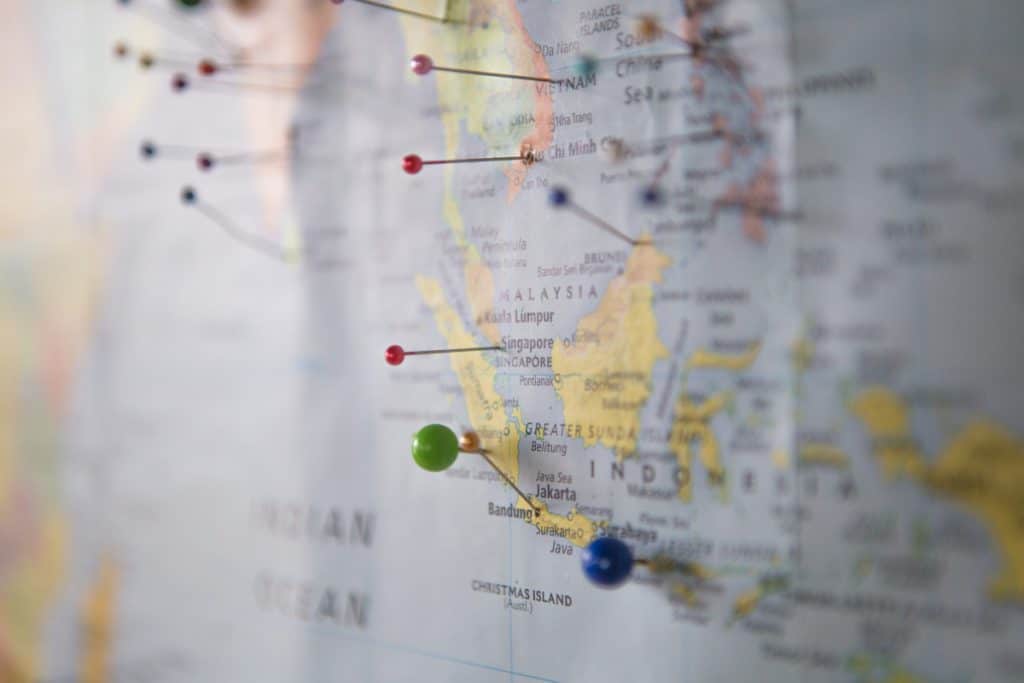
Destination Tips For Budget Travel
29. A cheap way to travel is to visit destinations where your home currency is strong. You’ll benefit from a strong exchange rate and from cheaper costs of living.
30. Whilst you’re on a tight budget, skip destinations with expensive visas.
31. Stick to one region at a time to avoid air travel costs. When I first went travelling I booked a round the world air ticket thinking I could see the world in 6 months. Boy did I have a lot to learn! Pick one region to fully explore first before moving onto the next. Don’t do what I did and be in a hurry to see everything all at once.
32. Travel during the shoulder season to benefit from lower costs and avoid the crowds at the same time – double win!

Food Travel Hacks To Save Money
33. Cook your own food. One of the best ways to travel around the world for cheap is to limit the amount you spend of food. Now don’t get me wrong I am a complete foodie and believe one of the best things about travelling is experiencing new types of cuisine. However, eating new types of food doesn’t mean going to the most expensive restaurants, in fact it’s often the opposite. But travelling on a limited budget does mean it’s not possible to eat out everyday since the cheapest way to eat often involves cooking your own food. Therefore choose accommodation with kitchens included such as hostels or rent an apartment.
34. Jump on happy hours and all you can eat deals.
35. Eat out at delicious and cheap street food stalls with the locals.
36. Avoid restaurants near popular tourist spots as these will often be overpriced.
37. Limit your alcohol if you have a limited budget. Alcohol is often expensive and isn’t a necessity.
38. Use a filtered water bottle and never buy water again. Check out this guide to discover which filtered water bottle I recommend for travel .
39. Stealth budget travel hack: Use chewing gum or tic tac containers to transport your favourite spices. Cheap food doesn’t have to be bland!
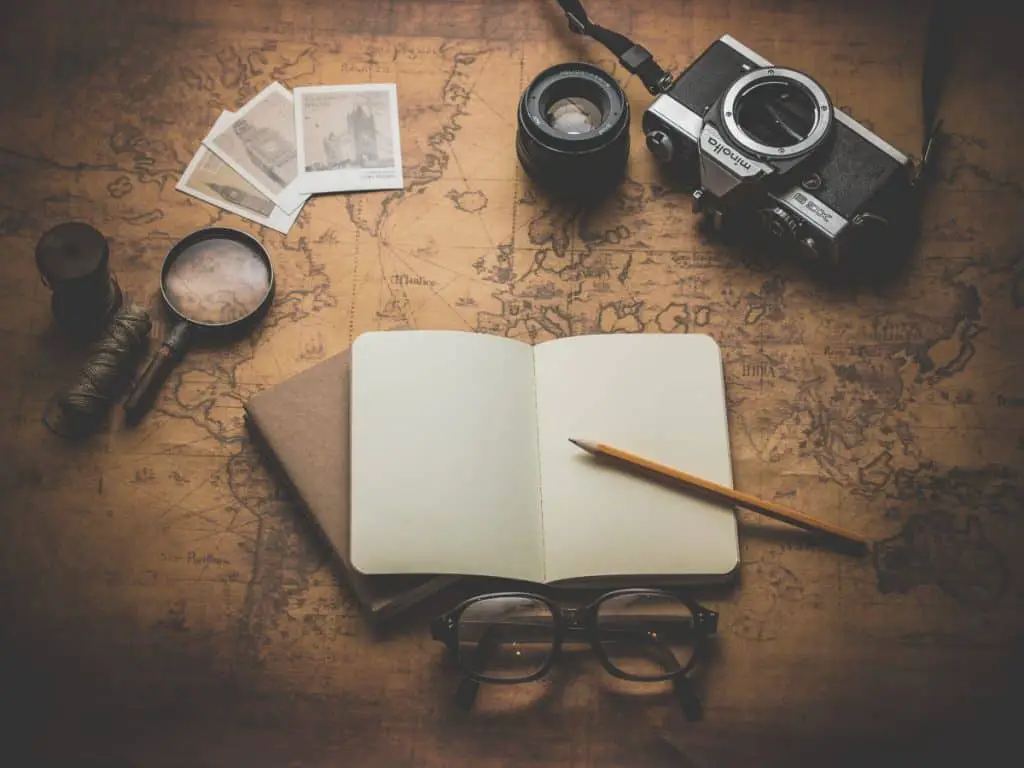
Planning Tips For How To Travel On The Cheap
40. Set a budget and stick to it. But be sure to include a generous contingency to allow for times when things don’t go to plan or to cover a once in a lifetime opportunity if it arrises.
41. If you are travelling on a tight budget you need to make a plan before you leave. List your priorities before you set off and refer to the list once you’re on the road. That way you won’t get sucked into doing expensive tours that you weren’t interested in anyway. Check out Google Maps Trip Planner for a great free trip planning tool.
42. Research whether activities you want to enjoy are cheaper to book in advance or are best left open and flexible. Last minute trips can sometimes work out cheaper.
43. If you don’t want the hassle of planning a trip use a travel agent. They know what they’re doing and can often find you the best deals.
44. Get smart and savvy with city tourist cards which provide entrance fees for multiple sites. If you know you’re going to visit all the top sites these will definitely save you money overall.
45. Enjoy free city walking tours. I’ve enjoyed great free city tours in Galway and Yerevan to name just two. But of course they’re not completely free – don’t forget to tip!
46. Research entrance prices beforehand to avoid getting scammed. However, just be aware of what the local currency is doing as prices can jump up if a currency weakens.
47. Follow your favourite travel companies on social media to learn about special promotions or giveaways.
Money Top Tips For Traveling Cheap
48. Get smart on money Exchange. Never change money at the airport or at busy tourist spots as these will have the worst rates. Hotels or hostels may also offer exchanges which again typically aren’t the best rates but they are safe and convenient so way up the risks/benefits of both.
49. An easy but important cheap way to travel is to use a travel card or join a bank with no overseas fees. This way you can hit the ATM without getting hit with overseas withdrawal fees. I use Starling Bank which is an online bank. All of my transactions are managed online via an app. Also, if purchasing online, they don’t charge for overseas transactions and have decent exchange rates.
50. Haggle but don’t be a d**k! Some cultures embrace bartering, expect it even, but these local people also have to support themselves so don’t be the person that walks away from a purchase for the sake of a dollar!
51. Use donatefull.com or groupon.com to find best coupons or use wikibuy to apply coupon codes at checkout.
52. A top life hack for travelling is to purchase a Scrubba bag and save on laundry bills. This nifty little bag packs down really small so doesn’t take up any room in your luggage and with just a 3 minute shake, can wash your clothes as good as any washing machine!
53. Keep rechargeable batteries in the fridge or at least in shady places. Rechargeable batteries retain 90% of their full charge if they’re kept cold. Not freezer cold though as this will have the opposite effect.
Phone and Internet
54. Get a local sim card and avoid hefty roaming fees. In some countries these can be a rather involved process but for most it’s quite straight forward. You often need your passport to register the sim card.
55. Use offline maps to save data. I use maps.me for most places when I’m travelling.
56. Consider investing in your own wifi router if you require a good connection. In our campervan we use this super fast Huawei wifi travel hotspot which allows us to connect multiple devices in areas where signal is typically poor.
Travel Insurance
57. Last but by no means least, get yourself some good travel insurance. Travel insurance can be expensive for long trips but you just never know when you might need it. The world of insurance can be a minefield but the guys at SafetyWing do great deals for long term travel through allowing you pay on a month by month basis. I highly recommend checking them out.
Summary On How To Travel The World Cheaply
Travelling around the world cheaply can do be done in many ways but it often requires a good amount of planning in advance. Be prepared for your trip through investigating the best deals, signing up for Airmile credit cards and joining frequent flyer programmes. Consider exchanging work for accommodation and reduce food costs through cooking your own food. Ensure you have the best bank cards to avoid big transaction fees, choose destinations where your currency is strong and use local Sim cards for the best phone and internet deals.
Through incorporating even just a few of these cheap travel tips you’ll be well on your way to exploring further, for longer 🙂
Join my newsletter today for more travel tips!
By checking this box I consent to the use of my information provided for email marketing purposes.
Louise is a Mountain Leader and Snowboard Instructor from South Wales. As a former Adventure Tour Leader she has spent the last 15 years travelling Asia, Africa and the Americas. Louise is a published photographer and is currently based in the UK.
Recent Posts
The Best eFoiling Destinations For Beginners
Imagine gliding effortlessly over the water, powered by the wind and waves, but with a futuristic twist. Welcome to the world of eFoiling - a dynamic blend of traditional water sports and...
A Guide To Visiting Rhossili Bay
Rhossili Bay and Worm's Head are two of the most popular and beautiful natural attractions in South Wales. These stunning destinations offer breathtaking views of the Welsh coastline and are a...
- Work + Money
- Relationships
- Slow Living
99 Travel Hacks To Make Your Next Trip A Little Easier

I’ve never cared about brand-name purses or clothing, much less cars or makeup. Instead, I spend whatever leftover money I can on travel. Traveling has exceptional “memory dividends” long after the money’s gone and is the best way to experience all the world has to offer (at least, in my humble opinion).
I’ve now been to 30+ countries and hundreds of cities—from rural northern Thailand to Moorea in French Polynesia to most of the United States—so I’ve picked up quite a few hacks here and there to make traveling the best experience it can be. Below, I’m sharing 99 of my best tips so you can spend less time planning and questioning and more time experiencing and enjoying. Got more? Share them in the comments; we don’t gate-keep here!
Wherever you’re heading—whether by plane, train, or bus—safe travels and happy exploring! 🌍
1. To save time, only pack a carry-on ; no more waiting at baggage claim!
2. If you decide to check a bag in, throw an Airtag into your suitcase, so you can always track where it is and ensure it’s reached your destination.
3. For the best possible travel deals, be flexible on your destination and dates. I’ve scored deals to multiple European cities for under $200 by leveraging that flexibility.
4. Perhaps the most important tip of all: Always buy travel insurance . Always.
5. Allocate all your spending on a credit card that racks up points which can later be redeemed for travel—my preferred option is Chase Sapphire Reserve or the AmEx Gold.
6. Sign up for credit card bonuses that offer up to 150,000 points once you hit a minimum spending bonus—I like to check Nerdwallet’s top credit card offers (updated monthly) to see the best bonuses.
7. Search for flights leaving at off-peak times (for example, mid-week, red eyes, or with a layover) if you’re trying to save money.
Prioritize early morning flights; they’re the least likely to be delayed or canceled.
8. If convenience is more important than money, prioritize early morning flights; they’re the least likely to be delayed or canceled.
9. Use Google Incognito or a VPN to search for flights. Searching on the same browser and internet connection tells the airline that you’re looking to book and allows them to hike the price up.
10. Once you find a flight you like—if you’re not ready to book—set up an alert to be notified if the price changes. If it drops, great! If not, you’ll know to book soon or keep an eye on it in case it comes back down.
11. Not sure when to go? Check out apps like Skyscanner or Hopper to find the best prices and times of year to head to your destination.
12. Sign up for loyalty programs with every airline you can; you never know when you’ll need to use them, and you can rack up miles for later use.
13. If you’re used to one specific airline, see if they have an airline-specific credit card for additional bonuses and perks. For example, United Airlines has major hubs in both our hometowns and our current cities so we have the United MileagePlus cards, which offer early boarding, free baggage, and 60,000 points each.
14. Keep an eye out for points sales , like Black Friday or Cyber Monday deals, 30% off transfer premiums, and more. (This is always a good option to keep in mind if you just need a few more points for a mostly-free flight!)
15. Look into mistake fares (deeply discounted fares mistakenly shared by an airline). They can sometimes be canceled or refunded, but many times, airlines will honor them anyway. One time, I was able to travel to Milan, Prague, and Amsterdam for $197 one-way from New York.
16. Subscribe to real-time alerts from The Points Guy , The Flight Deal on Twitter, and more.
17. If you have a few bucks to spare, sign up for flight deals from Going (previously known as Scott’s Cheap Flights). You’ll share your departure airports of choice, and you’ll receive deals right in your inbox.
18. Sign up for TSA PreCheck, CLEAR, or Global Entry to expedite the security process.
19. Once you’re past security but before you get to the gate, check out the Priority Pass, which will give you access to hundreds of lounges around the world. Both Chase and AmEx offer cards with Priority Pass access, and once you get to a lounge, you can stock up on free food, drinks, WiFi, and more.
20. Heading abroad? Use a third-party encrypted program like WhatsApp, Viber, or Signal for international texts and calls—you can avoid extra data and call charges!
Alert your credit and debit card companies about your travel so you don’t get flagged for fraud.
21. If you need access to international calls, buy a SIM card locally—you can usually find kiosks in the airport after arrival, or sometimes your carrier will offer a global SIM card for temporary use.
22. Alert your credit and debit card companies about your travel so you don’t get flagged for fraud.
23. Get a no-fee ATM for international destinations; my favorite is the Charles Schwab.
24. Only ask for ATM withdrawals in the local currency, not your native one.
25. Same for credit card charges; if you’re in Italy, pay with your card in Euros, not USD (for example). Then you’ll avoid fees and often score better conversation rates.
26. Download the airline app before you fly for easy access to your boarding pass, checking in, and seat or meal selection.
27. While you’re at it, you can check out the seat map on most flights to see what’s open and change seats accordingly.
28. You may even find an open seat in First or Business Class—consider politely asking for an upgrade. You never know if they’ll say yes!
29. If your travel plans are flexible, volunteer for a later flight when they’re offering compensation to offset the cost of the airfare.
30. If you decide to volunteer, try and wait to see if they’ll increase the compensation before you agree. Sometimes, you can get thousands of dollars in flight vouchers if you hold out long enough.
31. Buffer in extra time for delays—always.
32. Have a connecting flight? Aim for at least a 90-minute layover in between to avoid missing your flight in case of delays, security issues, etc.
33. Travel during shoulder season (i.e., not quite peak time yet). For example, if June-August is the best time of year to visit Greece, consider going in May or September for lower prices but still preferable conditions.
34. Don’t cut costs over convenience either, though—if you know you suffer from insomnia and back pain, taking a red eye in economy to save $100 may not be worthwhile. Similarly, don’t go for the cheapest hotel without thorough vetting; you don’t want to be stuck three miles from the beach without a bike because you didn’t know how far it was!
35. Check out alternative modes of transport besides the typical plane or car: Trains, bikes, public transportation, buses…the list goes on. These are often cheaper, better for the environment, and more accessible.
Create a default packing list for yourself that you can copy and tailor for each trip.
36. Create a default packing list for yourself that you can copy and tailor for each trip. This way, you’ll know you’ve included all the necessities most important to you, like specific medications, chargers, and toiletries.
37. Wear layers while in transit—it’s easier to pack your luggage, and you can stay warm (or cool) as needed.
38. If you suffer from swollen ankles or potential blood clots when sitting in one place for hours, get a pair of compression socks. There’s a reason many travel pros swear by them!
39. Another must? A reusable water bottle. Perfect for refilling inside the airport after security, carrying with you on tours, and having in case of emergency.
40. Heading to a place without clean, potable water? Don’t forget to bring a water filter or purifier for when you’re on the go.
41. Easily organize your suitcase (and save space!) with packing cubes .
42. If you’re really in need of space, consider vacuum bags to compress all your clothes.
43. If you know you’ll want to shop or bring back many souvenirs, get a secondhand suitcase at your local thrift store for cheap and fill ‘er up.
44. Don’t bring too many valuables. Many women travel pros will wear fake wedding rings to avoid burglaries or attacks.
45. Always tell someone at home what your itinerary is and where you’ll be. Even better if you can tell someone you trust locally in case of an emergency. #safety
46. Turn on location services and sharing, too, for good measure.
Print out extra copies of your passports and travel docs; keep digital copies in your email as well.
47. Print out extra copies of your passports and travel docs; keep digital copies in your email as well. Losing your passport is all too easy! 48. Need to drive worldwide? Don’t forget to pick up an International Driver’s Permit , which are readily available at most AAA locations.
49. Want to save money or avoid excess noise? Stay slightly away from downtown city centers and tourist spots—usually going even two or three blocks away can make all the difference.
50. Another way to cut costs is to consider house-sitting or couch surfing, depending on your level of comfort.
51. Hostels are another great budget-friendly accommodation option; it’s also a wonderful place to meet like-minded people and organize local tours.
52. Weigh the cost of laundry versus the cost of a checked bag. Sometimes packing light and doing laundry will be far cheaper than paying for an extra suitcase.
53. Pack a capsule wardrobe for easy mix ‘n matching for your daily #lewks.
54. Think about items you may need at a destination that you’ll end up paying a premium for later and see if you can get them beforehand. For example, sunblock at a tropical destination will be far more expensive than getting it in the off-season in the Midwest.
55. Pack an essentials kit in case you need certain toiletries or accessories while in transit—for example, a small bag with spare underwear, ear plugs, eye mask, tampons, and charging wires.
56. Carry a purse or travel bag that you can keep close on your body, closed with zippers rather than buttons or flaps. This will help stop pickpockets!
57. Pack extra snacks. Just trust me on this one! You never know when you may need sustenance and can’t find anything worthwhile.
If you can, take the day off after you get home so you can ease back into everyday life.
58. If you can, take the day off after you get home so you can ease back into everyday life. Then you can finish up any chores or errands like laundry, grocery shopping, and more without worrying about rushing back into the office.
59. In your carry-on backpack or purse, keep an extra set of clothes, a toothbrush, and undies in case your luggage gets lost. (Which is another reason why you always want travel insurance!)
60. If you’re not using data and/or are heading to a remote area, download offline versions of Google Maps and take screenshots of any information you need.
61. If you’re heading to a foreign country and the local language isn’t one you speak, download the Google Translate app. You can then converse with locals, take photos of written text to translate, and more. (This was an invaluable tool when I was stranded in northern Thailand during a downpour once!)
62. Download media a day or two before you leave, so you can access it while traveling—think audiobooks, ebooks, Netflix, etc.
63. Get the best portable charger you can afford if you know you’ll be relying on your phone throughout the trip. You’ll never regret it.
64. Pack a universal adapter so you can use your electronic devices around the globe.
Pack a universal adapter so you can use your electronic devices around the globe.
65. Don’t forget a converter too, if your electronics’ voltage doesn’t match up to the outlets abroad.
66. Getting a rental? Book the reservation on a credit card like Chase or AmEx, which offers auto insurance and collision insurance for rentals.
67. If that’s not an option, it’s well worth getting auto insurance from the rental company.
68. Take photos of everything important: The condition of your rental when you pick it up/drop it off, receipts if you’re going to be reimbursed or splitting costs, WiFi passwords, and so on.
69. Make sure you’re up-to-date on your vaccinations and shots , which vary by country. (And don’t wait until the last minute to book your appointment!)
70. Read. The. Reviews. Make sure you look for any bots or planted reviews, and keep an eye out for any red flags, whether you’re searching for accommodations, a tour, or restaurants.
71. Similarly, seek out vetted tour groups if you’re traveling alone. A few of my favorites for women include El Camino Travel , Stellavision Travel , and G Adventures .
72. Sometimes DIYing a trip can be helpful, but other times, a good travel agent is the most valuable. They’ll get access to exclusive discounts, tours, or accommodations that you couldn’t leverage otherwise.
73. If you’re considering traveling with a friend or partner, ensure your travel priorities are aligned before leaving. Nothing will be more frustrating than having a companion sleep in when you’re a morning person or dealing with a racket first thing in the morning if you’re a night owl.
74. In the same vein, learn many of your destinations’ cultural nuances and customs—it’s important to be considerate and mindful of the communities you’re visiting.
75. Heading to a faraway destination? Try pairing nearby cities together on this trip so you knock out two at once.
76. Stay hydrated, especially when traveling. We’re already adjusting to new environments, time zones, etc., and hydration is key for our bodies to adapt.
Get sunlight as early as possible when you’re in a new time zone to help reset your circadian rhythm.
77. Get sunlight as early as possible when you’re in a new time zone to help reset your circadian rhythm.
78. Napping to adjust a timezone is okay, but try staying awake the whole day and sleeping at night to beat jet lag once and for all.
79. Chew gum while taking off or landing if your ears pop while in flight.
80. Invest in a quality skin mask or moisturizer, lip balm, and lotion during and post-flight when our skin is driest.
81. Luggage scales can be clutch—if your baggage is overweight and you can’t rid yourself of any items, you’ll be on the hook for hefty excess fees.
82. Traveling with kiddos? Bring a “busy bag” to keep them entertained throughout the day, stocked with coloring books, toys, a tablet, snacks, and whatever else your little one prefers.
83. If you’re dealing with long-haul travel, you’ll want a quality neck pillow—this is mine and I’m obsessed.
84. If you can , opt for a backpack over a suitcase or duffel. There’s a good chance transportation carriers won’t bother to weigh your backpack!
Whatever you’re budgeting for your trip, add another 10-20% in case of emergency.
85. Whenever you get samples like shampoo, moisturizers, or sunscreen, throw them in your travel toiletry bag. That way, you don’t need to bring the bulk items or worry about the liquid limit.
86. Throw a lavender satchel or a dryer sheet in your bag to keep things smelling…fresh. 🙂
87. Pack at least two extra large plastic or ziplock bags for shoes, dirty clothes, etc.
88. Opt for a bright-colored suitcase so it’s easy to spot at baggage claim or while in transit.
89. If you’re flying with another person and can book your seats in advance, one of you can take the window and the other can take the aisle. That way, the middle seat will likely be left open for you both to enjoy.
90. Always keep a spare pen on you, especially if you know you’ll have to fill out customs forms or write down directions.
91. Take a picture of your car or write down where it is in your notes app so you don’t forget where you’ve parked, whether at an airport parking lot or a new hotel.
92. Bring extra wipes or a sanitizer spray for when there’s no washroom or when things need some tidying…like your tray table.
93. Whatever you’re budgeting for your trip, add another 10-20% in case of emergency.
94. Check out local walking tours in big cities; they’re often free or pay-what-you-can and are a great way to see the most important sights and get acquainted.
95. Some businesses offer deals if you book with a partner company—for example, United MileagePlus members earn savings if you book a car rental through Avis or Budget.
Travel is one of the most valuable experiences there is in life. Enjoy every moment, be mindful and respectful, and explore as much as you can.
96. Don’t forget to check if you’ll need a visa for specific countries! Or, prioritize countries where you won’t need one for ease of access and to save money.
97. Eat street food (as long as it’s cooked in front of you and looks safe!). It’s often one of the best ways to enjoy a local culture.
98. Make lunch your biggest meal—it’s usually cheaper than dinner while being just as filling.
99. Most importantly, remember: Travel is one of the most valuable experiences there is in life. Enjoy every moment, be mindful and respectful, and explore as much as you can.
Henah Velez (she/her) is the Senior Editor at Money with Katie at Morning Brew , as well as a writer at The Good Trade. She holds a Master’s in Social Entrepreneurship and is a proud Rutgers grad. Originally from NJ, Henah’s now in the Bay Area where she loves shopping small, hanging with her pets, or traveling. Say hi on Instagram !
RELATED READING

How To Make A Travel Journal
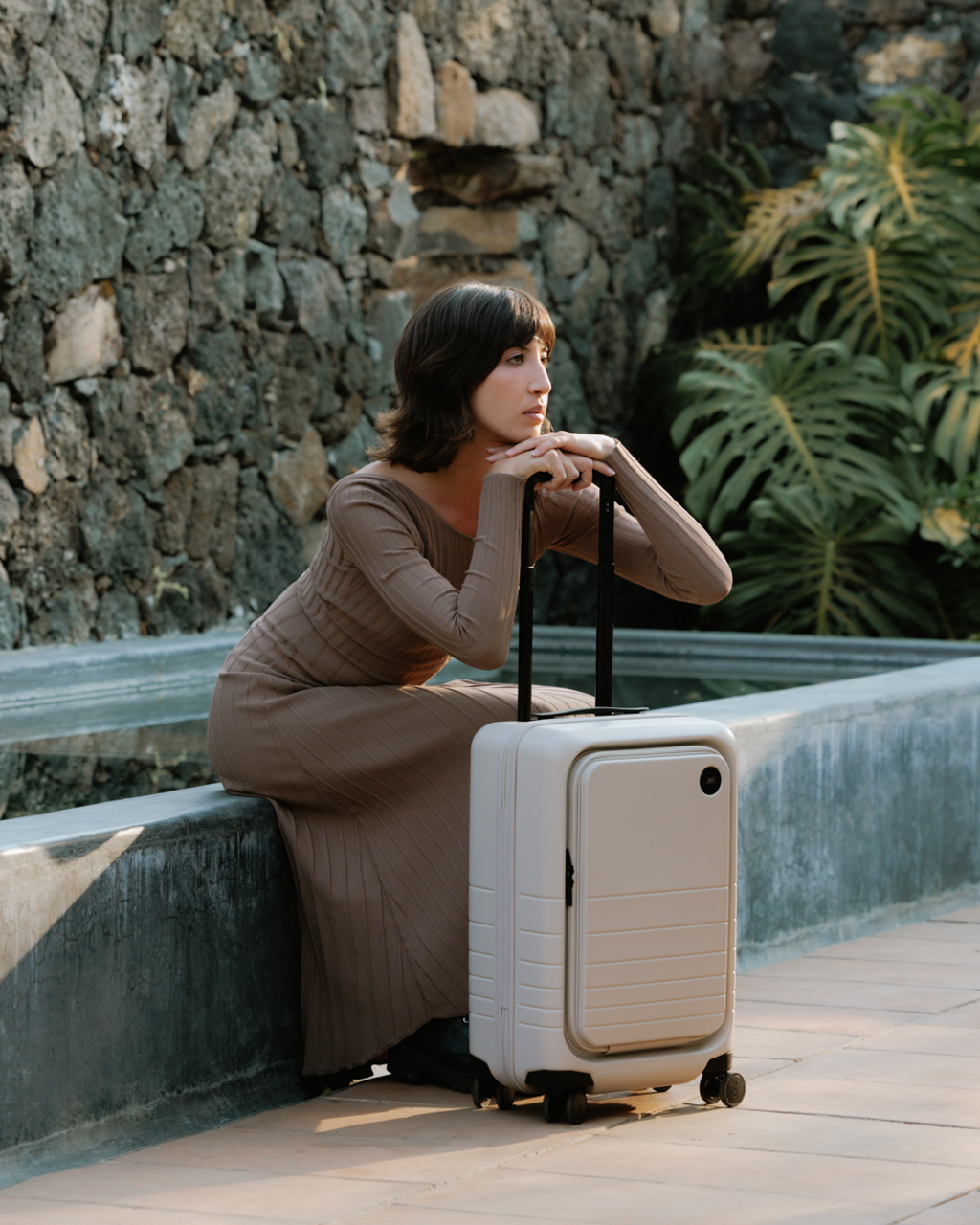
9 Sustainable Luggage Brands To Travel The World

99 Money Affirmations To Attract Abundance Daily

7 Language Apps To Prepare You For Your Trip Abroad
9 Travel Hacks By 9 People Who Wander The World
Avid travelers shared their best hacks and advice for smart travel to help others see the world!
- Always carry multiple cards to keep your travel funds safe and avoid getting stuck without access to money.
- Register your trip in S.T.E.P. for solo female travelers to feel safe and ensure someone knows their whereabouts.
- Use apps like Emma Finance or YNAB to budget and save for your dream adventure, keeping you on track for your departure.
Travelers from around the world are constantly sharing online their tips and tricks for traveling smarter , safer, and wandering the world more affordably . But with so much noise and so many travel creators out there, it can be hard to sift through all the information and suggestions to find the hacks that really help. We’ve done the hard work for you with 9 tips from some of the world’s most well-traveled and adventurous content creators. Keep these tips from people who wander the world in mind next time you’re planning an adventure!
Anchors Aweigh: 10 Travel Tips For A Hassle-Free Cruise Experience (Before Boarding)
9 always carry multiple cards, the wanderer: hey ciara.
Full-time traveler Hey Ciara recently took to Instagram to share a key tip with her followers: carry multiple cards when you travel. After her credit card was swallowed by an ATM less than 24 hours into her trip in Ghana, the travel expert advised followers to:
“Carry two cards (debit and credit) at the least and limit daily cash withdrawals.”
She also advised that travelers should notify their banks before traveling to avoid locked cards and ensure they have the ability to lock or cancel a lost or stolen card immediately. Ciara also says downloading the Western Union app is a good way to transfer money internationally.
- How It Helps Your Budget: Keeps your travel funds safe
- Best For What Budget: All budgets (but especially backpackers $)
- Options To Get You Started: Carry two cards, download the Western Union App, and wear a money belt
8 Register Your Trip In S.T.E.P
The wanderer: crosby grace travels.
Crosby Grace Travels is a YouTuber and full-time traveler with tips for solo females who are discovering the globe. In a video about her solo adventures in Mexico , Crosby shared a useful tool for women traveling solo: registering in the Smart Traveler Enrollment Program.
The site allows you to register your trip, the dates, and where you’re coming from. Then, the information is sent to the closest US embassy to where you’re staying at your destination. This helps provide peace of mind that if friends and family at home lose contact with a traveler, the closest embassy knows, based on the itinerary provided, where the individual is supposed to be and can help locate them.
The S.T.E.P. program is for U.S. travelers.
- How It Helps: Keeps female travelers feeling safe knowing there is a record of their whereabouts
- Best For: Solo female travelers
- Options To Get You Started: Sign up online
7 Use Apps To Help Save Money For Trips
The wanderer: travelwrighter.
Megan Wright, “Travelwrighter” on Instagram, promotes the ability to take an adult gap year as she herself has done, and is helping others get there by teaching them how to budget for a year of travel. She recommends using apps like Emma Finance or You Need a Budget to help breakdown all your income and monthly expenses to determine where you can cut costs and how long it will take you to save what you need for that epic year of adventure.
- How It Helps Your Budget: Keeps you on track for your budget by departure
- Best For Budget: Low-budget to mid-range ($-$$)
- Options To Get You Started: Download the Emma Finance or YNAB app
Take To The Skies With Confidence: 10 Travel Tips For A Smooth Flying Experience
6 use google maps offline, the wanderer: drew binsky.
Traveler Drew Binsky has been to every single country in the world, and he shared a key hack in a video on his YouTube channel : download and use Google Maps offline while exploring a new destination. Doing this before arrival is essential when you’re not sure how reliable cell phone data or Wi-Fi access will be. Having an offline map allows you to get to your accommodation from the airport or train station without having to pay for additional cell phone data usage. Binsky also mentions the app Maps.me as an alternative, but says he prefers Google Maps.
- How It Helps Your Budget: Reduces the need for additional cell data
- Options To Get You Started: Download Google Maps for the destination offline or download the app Maps.me
5 Get A Priority Pass For Airport Lounge Access
The wanderers: kara and nate.
Kara and Nate have a following of more than 3 million subscribers on YouTube and have been traveling the world full-time since 2016. As huge proponents of miles and points and airport lounges , the Husband and Wife team have frequently shared a particular travel hack in their videos over the years: get a Priority Pass .
The Priority Pass is a great option for travelers who fly frequently throughout the year and want to reduce their cost on food and water while at the airport. A Priority Pass incurs an annual fee, but this is well worth it if you travel more than 4–5 times per year. You’ll have access to the world’s largest network of lounges and get complimentary meals, drinks, water, and even showers at airports around the world. Perfect for the avid traveler who wants to invest now to save later!
Some credit card holders may already have access to Priority Pass lounges. Be sure to check with your bank! If you don't have access, you may have a discount available for purchasing the pass.
- How It Helps Your Budget: Reduces food and drink costs at airports
- Best For Budget: Low budget ($)
- Options To Get You Started: Sign up for a Priority Pass, or get a credit card that comes with complimentary lounge access (and use responsibly)
4 Upgrade To Business Class With Points
The wanderer: renee roaming.
Renee Roaming is an outdoor, lifestyle, and travel blogger whose Instagram account and blog focus heavily on hiking and US national parks. The Aussie-born turned Seattle resident recently flew from the US to Japan on American Airlines and shared a tip via Instagram for her followers: upgrade to Business Class using miles and points.
In Renee’s case, she was able to upgrade to American Airlines’ Flagship Business class using points amassed by flying frequently with the airline as an AAdvantage member . This hack shows the value in sticking to an airline or airline alliance and racking up points to later apply for an available upgrade before a flight. It's a great way to elevate the Economy experience without paying for a Business Class price outright. Before selecting an airline to stick with, consider which ones have the best points systems .
Usually, using points to upgrade from Economy Class to Business Class is much more affordable and requires the use of fewer points than booking Business Class straight away.
- How It Helps Your Budget: Uses fewer points for a better flight experience
- Best For Budget: Mid-range ($$)
- Options To Get You Started: Look at what airlines fly out of your home airport and see if many of them belong to a specific airline alliance (Star Alliance, Oneworld, etc.) - sign up as a loyalty member and start collecting points
10 Tips For Travelers When Planning A Backpacking Adventure
3 choose booking platforms based on your destination, the wanderer: nomadic matt.
One of North America’s top travel bloggers, Nomadic Matt (Matthew Kepnes), shares helpful hacks and insightful travel encounters on his blog, Nomadicmatt.com . Recently, via Instagram stories, Matt shared a helpful tip for travelers about booking their accommodation: change your booking platform based on the destination.
For example, he shared that Agoda often has the best hotel and hostel deals when looking at destinations within Asia.
- How It Helps Your Budget: Offers more options at better prices
- Best For Budget: Low budget ($) to mid-range ($$)
- Options To Get You Started: Check out sites like Agoda (for Asia), Hostelworld (for Europe)
2 Bundle Hotel And Flight Bookings
The wanderer: hey nadine.
British Columbia-based content creator Nadine Sykora (Hey Nadine) recently shared a travel hack on her Instagram Reels where she says travelers are “sleeping on,” and that's bundling flights and hotel bookings. In her post, Nadine highlights Expedia’s bundles, which can save Expedia Rewards members up to 30% on their trip compared to booking their flight and hotel separately. This is a great way to find an affordable hotel and flight combination, even in luxury destinations like the Maldives, on a budget .
This underrated feature is also available on Booking.com and is a great way to save hundreds of dollars on a trip, especially if you want to travel during a busy season or aren’t flexible with your dates.
- How It Helps Your Budget: Reduces costs by up to 30%
- Best For Budget: Mid-range ($$) to High End ($$$)
- Options To Get You Started: Expedia , Booking , Kayak
1 Find Flights Using Skyscanner
The wanderers: ian and ana.
Ian and Ana Ryan have been traveling the world full-time for over five years, and they have amassed a significant following on YouTube throughout their adventures. Ana shared a tip via Instagram Reels for the cheapest way to book flights and compare costs based on destination and travel dates: Skyscanner.
Travelers may not realize they can use Skyscanner’s cool feature of setting the destination to “everywhere” from their home airport and seeing a list, ranked by price, pop up of where they can fly during their desired dates. Even more flexible? Input the dates as “Anytime” for a sense of the lowest fares this year ! This is one of the best ways to book cheap flights .
- How It Helps Your Budget: Compares costs by date, destination, and airline
- Best For Budget: Budget travelers ($)
- Options To Get You Started: Download the Skyscanner app using the App Store or Google Play
- Share full article

Travel 101: Our Favorite Hacks, Hints and How-Tos
Successful trips take thorough preparation, from picking the right destination to nailing down all the details. We’ve done the homework so you don’t have to.
Credit... Dani Pendergast
Traveling is exciting, fulfilling and even life-changing. Planning to travel can be stressful, confusing and overwhelming. What should you pack? How can you arrange that big trip with friends and not end up enemies? How do you get to your destination when cancellations and delays conspire against you?
This new series, Travel 101, is designed to help. We’ve talked to the experts, read the fine print and dived deep into the details to offer actionable, practical solutions that will help you maximize the joy and minimize the headaches. We’ll be adding to this guide regularly to create a compendium of advice you can turn to at each step along the way. Bon voyage!
Vacation Rentals: How to Shrink Your Carbon Footprint

Travelers choosing to stay in a vacation home instead of a hotel may have to spend more time searching for sustainable lodgings, but ultimately they will have more control over their environmental impact. The following are steps short-term renters can take to shrink their carbon footprint.
Search for sustainable rentals
The company Sustonica validates short-term rentals based on sustainability standards, including conserving water and minimizing waste. But it does not act as a search engine. Instead, travelers will find its logo on certified listings on platforms like Airbnb and Booking.com.
Airbnb’s rental categories can help travelers find off-the-grid options, highlighting more than 9,000 listings that rely on renewable energy sources or have no electricity, and Earth Homes , a set of accommodations built with organic materials such as mud or rammed earth.
Booking.com, which lists vacation homes as well as hotels, allows travelers to search for listings with sustainability certifications from more than 65 organizations doing third-party reviews of practices ranging from renewable energy sourcing to recycling.
The company said that more than 16,500 properties, a combination of hotels and rentals, have separate, third-party sustainability certification.
The vacation home rental platform Vrbo does not have an eco-friendly search filter, citing the lack of industry consensus on what makes a rental more sustainable. Properties listed by its sibling agency Expedia may say they are “eco-certified” and users can search using that filter. But read the results carefully; some listings lack information on their sustainable features.
Wherever you search, scrutinize the listings, said Bob Garner, the founder of EnviroRental , a service that works with short-term rental owners on sustainability practices. Do bathroom photos show shampoo in large, shareable dispensers? Does the description mention recycling? If the host has a separate website, look for press links or blog posts related to sustainability.
Talk to the host
According to Airbnb, more than 80 percent of its hosts say they incorporate at least one sustainable feature, such as composting, minimizing single-use plastics and providing guidance on using public transportation. The platform maintains a guide for hosts on sustainable tourism practices, with tips on things like creating a manual to direct travelers to local shops, restaurants and markets.
“When you think you’ve found the right property, ask some questions,” Mr. Garner said. “If they can’t answer them, then there’s a red flag.”
Just the act of asking about environmentally friendly features can have a lasting effect.
“If they think you care, there’s a greater chance of moving the needle,” said Diane Daniel, the founder of Vacation Donations , a nonprofit that encourages short-term renters to donate leftover food in the Tampa, Fla., area.
Consider a pedestrian- or public-transit-friendly location
Even if you can’t find a solar-powered stay, you can choose a location that allows you to get around with minimal emissions.
Connect your “environmental consciousness with the idea of being a good traveler,” said Beth Santos, the chief executive of Wanderful , a global women’s travel community, and the author of “Wander Woman: How to Reclaim Your Space, Find Your Voice, and Travel the World, Solo.”
She recommends travelers live like locals, including taking public transportation, visiting neighborhoods beyond city centers and patronizing small businesses. Take a “day zero,” or a single unscheduled day to walk the neighborhood to find nearby shops as well as transportation options.
Conserve energy
Conserve energy by turning air conditioning off or down when you’re out, switching off lights when you leave and turning off the tap while you brush your teeth.
“This could be one area where you say, ‘I don’t care, I’m on vacation,’” Ms. Daniel said. But travelers should stay vigilant, she said. “Short-term rentals are the easiest places to regulate your footprint, because it’s really up to you.”
Plan meals, reduce waste
Renters usually have the option of cooking meals. To avoid food waste , plan meals and shop for them as you go — and as plans change — rather than buying everything at once. Bring staples like salt and pepper and ask the host if the kitchen is stocked with other supplies like cooking oil and coffee.
“Buying slowly over the week as you need things is a really nice experience if you’re in a location where they’ve got some nice delicacies and interesting farm shops,” Mr. Garner said.
Ms. Santos of Wanderful recommends packing a collapsible food container. “You can throw it in your luggage, take home leftovers and have a place to reheat them,” she said.
Donate leftover food
Take as much leftover food home as you can and look for food pantries that accept donations for whatever you can’t take.
“Perishables are very challenging unless you’re near a pantry that takes them and is open when you’re checking out,” said Ms. Daniel of Vacation Donations.
Don’t assume the cleaner wants your food. In a pinch, Ms. Daniel recommends knocking on neighbors’ doors if you’re staying in an apartment building, or searching Facebook for local groups seeking food donations.
Consider ‘community offsets’
Carbon offset programs invest in activities like tree farming that reduce carbon in an amount matching the emissions generated by a trip. But it’s a controversial practice that has led to inflated, if not bogus, claims of carbon mitigation.
Instead, consider donating your time to a local cause in the area where you’re renting.
“Community offsets or volunteering work are opportunities to spend two hours one morning of a holiday to help in whichever volunteering work there is in this local area, from picking up trash to feeding homeless people,” said Vanessa de Souza Lage, the co-founder and chief executive of Sustonica.
Travel Advisers: When to Let a Professional Plan Your Trip

Decades ago, your vacation most likely began with a visit to a travel agent, who relied on a combination of expertise and connections to find the best deals on plane tickets, hotels, tours and more. Since then, the internet has turned most of us into our own travel agents, and artificial intelligence software is making research and self-booking even easier. But for some trips, that special insider knowledge can still make a big difference.
So when should you hire a professional, and how does it all work? Here are some tips.
Why should I consider a travel adviser?
It’s easy for a traveler to do the research for a standard trip, said Chris Anderson, a professor at the Cornell University School of Hotel Administration, “so they should look for a specialist for the type of tour they are looking for, say a bike trip in Ireland, who can really add value.”
The insider knowledge offered by a travel adviser can add the most value to trips that have multicity itineraries, involve a wide age range of travelers , are very significant (like an anniversary vacation) or are to destinations you are unfamiliar with, said Gary R. Johnson, who has run the travel agency Woodside Travel in Seattle for nearly 30 years. An adviser could help you decide, for instance, in which order to visit European cities based on local events and transportation options.
What can an adviser give me that a booking site can’t?
Travel advisers can help you research the best destinations, lodging, or activities for your particular group and travel goals, offering up specific advice that might be hard or time-consuming to find yourself. Those specializing in cruises might know which cabin to choose if you are prone to seasickness, while a safari planner could help you decide which park would be best for bird-watching or seeing specific animals, like rhinos.
Travel advisers typically have relationships with tour companies, hotels and cruise lines, sometimes through networks. Those connections can allow advisers to offer extra perks such as late checkout, free breakfast, airport transfers, a welcome basket or a credit to spend on a cruise ship.
“A good travel agent will be a better steward of your travel budget than you are,” said Guy Rubin, managing director of Imperial Tours , which arranges travel in China.
When bad weather or other circumstances disrupt your itinerary, travel advisers often have direct lines of communication with providers and can do the work of rebooking and changing plans, saving you time and stress.
OK, let’s say I need help. How do I find an adviser?
Networks like the American Society of Travel Advisors and Travel Leaders have websites that can help you start your search for a travel adviser by answering a few questions about your desired trip. Once you have a handful to choose from, get on the phone with them to talk about what they might do for you, how they charge and the level of service you can expect. Special trips can cost thousands of dollars, so it’s worth investing time up front, Mr. Rubin said.
Make sure to read over the travel agent’s reviews and any user-generated social content that mentions them, Dr. Anderson said. “If there is no external validation, that’s a red flag.”
How do advisers get paid, and how much will it cost me?
Advisers receive commission from suppliers, typically 10 to 15 percent of the price, when selling cruises, lodging and tours. They also sometimes charge travelers a planning fee, from a few hundred dollars, which may be credited to the final bill if the booking is completed, all the way up to tens of thousands of dollars annually for a luxury concierge travel planner they can call on all year. Mr. Johnson said that he charges a planning fee the first time he works with customers. If they return for other trips, he waives the fee.
Advisers may be tempted to sell you something that will earn them a higher commission, Dr. Anderson said. But, he points out, the same is true for the large online services, which promote hotels that pay them larger commissions. Travelers can ask advisers about specific commissions they receive or how they are affiliated with the products they are recommending, he said.
Sometimes a local tour company will package transportation, lodging and experiences for an adviser, who tacks on a percentage before passing it along to a client. But a bill that is not itemized can make it harder to make trade-offs — between a more expensive hotel and a special experience, for example. If pricing transparency is important to you, discuss it with the adviser up front.
How are A.I. and other technologies affecting travel advisers?
While new technologies are allowing do-it-yourselfers to create their own itineraries online based on individual preferences, and to type questions directly into travel websites, advisers are also taking advantage of those technologies to improve their services. Joan Roca, chief executive of the upscale travel planning company Essentialist said his team “uses technology to enhance the human touch,” employing artificial intelligence to choose options from a database of travel offerings selected by a human team. If a couple wants to take an after-dinner stroll, for example, Essentialist’s app will offer up ideas of where to go, based on what part of the city the travelers are in and conversations they’ve had with their travel adviser.
Advertisement
Drone Photography: How to Take Better Pictures

Before the advent of drones, people had to rely mostly on airplanes or helicopters to take aerial photographs. Now, thanks to increasing availability and decreasing price points of drones, as well as advances in obstacle avoidance technology, GPS navigation, battery life and camera stabilization, it certainly seems easier to take photographs from higher elevations.
But that doesn’t mean anyone with a drone can make excellent photographs. Here are some practical tips on the logistics of drone usage and suggestions to make better photos while traveling.
First, know the rules
In the United States, the Federal Aviation Administration oversees drone regulations, and FAADroneZone is the country’s official website for understanding drone requirements and managing drone services. If you are a recreational flyer, you must pass an aeronautical knowledge and safety test, called the Recreational UAS Safety Test , before flying your drone.
The drone company DJI also has a detailed website that instructs drone users on local rules and regulations.
The basic rules for flying a drone as a hobbyist — that is, recreationally using a drone — are to fly the unmanned aircraft only at or below 400 feet, always keep the drone in sight, do not fly in restricted airspace and do not fly over groups of people. If you are flying your drone commercially, you must become a certificated remote pilot by passing the F.A.A.’s Part 107 test . This is a more extensive test and covers additional drone rules, airspace regulations and weather conditions.
Be aware that many countries may have different regulations. Anywhere you go, you may be fined or your aircraft may be confiscated if you do not adhere to the rules.
Understand what your drone can do
Drones are incredibly fast, maneuverable and precise. You can fly up to 400 feet and move laterally in an infinite number of directions to get the perfect shot. But first-time drone flyers often fly as high as possible and take pictures that lack a point of focus or a strong composition.
In order to get photos with the most detail, set your drone to the lowest ISO, usually 100. This is the feature that sets the camera’s sensitivity to light and was known as the film speed back in the days of film. To achieve the best quality pictures, it’s best to shoot in RAW format, which is a digital image file that is unprocessed and contains the most amount of data. When processed, this will produce photographs with the most detail.
After you have purchased your drone, it’s good practice to regularly update the firmware, which is software that provides basic instructions for the craft’s hardware to function successfully, like the drone and remote controller working together.
Use maps and the weather forecast, and time it right
Whether you consult an atlas or follow your car or phone’s navigation, maps are very effective tools for seeing the shape of a river, lake or pond and provide ideas for good aerial subjects.
Once you have a location, shoot during the “golden hours” — taking photos around sunrise and sunset will often produce the most dramatic pictures with warm light and shadows. It’s a good idea to keep an eye on the weather forecast to know the sunrise and sunset times and also what the weather will be. High winds and rainy or snowy weather make flying a drone much more difficult.
Look for patterns, lines and light while flying
Many times a drone photographer will make discoveries from the air. You might launch with the idea of photographing one thing and, while in the air, you might discover something more compelling. Rivers, solar arrays, farm fields and trees can provide engaging patterns and lines.
And don’t forget the light and shadows, either. Good light can make or break a photo. Sometimes the best light means a golden sunrise, as we said earlier, but sometimes it means an overcast day with diffused light. On cloudy days, shooting straight down on a subject can be very effective.
Taking drone photos at twilight can also be very captivating. This is the time after sunset and before nightfall. Set the drone to manual exposure, set the ISO to 100 and experiment with long exposures. Some drones can take up to eight second exposures and maintain sharp focus.
Study an expert’s work
One of the great ways to make your photos better is to study the work of a professional photographer.
The photographer George Steinmetz has been making aerial photographs for decades — even before the rise of affordable drones — while working with publications like National Geographic and The New York Times. He has published five books on aerial photography.
“For intimate aerial photography, a drone is exceptional,” he said, but adding that any type of aerial photography can be transformative.
“You see the world in a way you’re not accustomed to,” he said. “It adds context and a new perspective.”
Renting a Car Abroad: Don’t Get Taken for a Ride

“Throw the keys through the kiosk’s open window. We’ll get the car when we open later”: Those slightly unorthodox drop-off instructions I once received from a Hertz manager in Croatia illustrate some of the differences U.S. travelers might encounter when renting a car abroad.
It pays to familiarize yourself with the local policies and protocols ahead of time. Here’s what you need to know before you accept the keys.
You may need an international driver’s license
If you have a U.S. driver’s license, an international driving permit is officially required (along with your state-issued license) in Australia, Austria, Bulgaria, the Czech Republic, Estonia, Italy, Japan, Poland, Romania, Serbia, Slovenia, Slovakia, Spain and Thailand, although its use is not universally enforced. It’s also a good idea to carry an I.D.P., a booklet — slightly bigger than a passport — that translates a U.S. license into 10 languages, when renting a vehicle in a country whose language is not written in Roman letters.
An I.D.P. costs $20, is valid for one year and is issued to any applicant by a local AAA office (the only issuer in the United States authorized by the State Department). You must apply for one in the country that issued your regular driver’s license.
Familiar brands may be franchisees
Car rental brands familiar to Americans operate throughout the world; those include Alamo, Avis, Hertz, National, Sixt and others. You can reserve a vehicle through a company’s U.S. website or through a rental aggregator such as Autoeurope.com , to compare rates.
The overseas branches of U.S. companies may not always be owned by the parent company. The discussion boards on websites like Tripadvisor abound with commenters calling out franchise operations of major chains for not providing the service they expect from a U.S. operation.
Franchise or not, disputes with a foreign branch should always be directed to the U.S. customer service operation, according to Hertz and Autoeurope.
Check minimum (and maximum) age requirements
The minimum age to rent a car varies by country and company, and it’s indicated on each rental agency’s website. Most countries charge a “young driver” surcharge for renters under 25. Some countries, such as France and Germany, allow (but do not require) companies to rent to 18-year-olds, but 21 is the typical minimum rental age for most.
At the other end of the spectrum, Hertz won’t rent a vehicle in Northern Ireland to anyone older than 79; those from 75 to 79 must have a doctor’s letter stating that they are in good health, as well as a letter from their insurance company proving that they haven’t had an accident within the past five years.
Cut costs with a stick shift
Cars with manual transmissions are still popular in many European countries, so if you’re comfortable driving one, select that option. Renting a car with an automatic transmission can typically cost an additional 30 percent or more.
Check your credit card’s rental insurance coverage
Many U.S.-issued credit cards cover damage to your international rental car if you’re in an accident, as long as you charge the entire rental fee to the card. Some issuers also require that the same card be used to make the reservation for the insurance to be valid. That collision coverage is primary, unlike in the United States, where your personal vehicle insurance would cover the costs while your rental insurance would pay for any deductible amount. Even if your credit card covers damage to your rental vehicle, you will be responsible for the cost of damage to any other vehicle if the accident is deemed to be your fault.
Be warned that standard rental insurance for American Express cardholders is not available in Australia, Italy and New Zealand, and other cards may have different restrictions.
Familiarize yourself with local driving and parking laws
Before you go, learn each country’s rules , including the meaning of various road signs and markings. For instance, simply because you see other vehicles parked with their wheels on the sidewalk — common in European cities with narrow streets — that does not mean that it’s legal to do so.
Autoeurope.com has driving tips for dozens of countries, not all in Europe, and Britain’s Automobile Association lists road rules for six European countries. Don’t forget that many places besides Britain drive on the left (including Japan, Australia, New Zealand, South Africa and numerous Caribbean islands). And if you get a ticket, don’t ignore it. The rental agency will eventually collect from you, along with an administrative fee .
Seatbelt laws are often strictly enforced, with a separate fine — sometimes issued on the spot — for each occupant not wearing one.
Finally, many European cities restrict driving in central or historic areas to residents only or those driving low-emission vehicles. Entering these limited-traffic zone areas can incur heavy fines, plus an added fee from your rental company. Watch for signs and gates (commonly marked “ZTL” in Italy ).
Know your fuels
Diesel engines are very common in other countries; putting diesel in a gas engine or vice versa can cause serious — and costly — damage .
While fuel pumps are color-coded to indicate what they dispense, those colors vary by country and region. Fuel requirements are listed on a sticker on the inside of the filler door.
In the United States, black indicates gasoline while green designates diesel. In Iceland and other European countries, it’s the opposite: green for gasoline and black for diesel.
Cellphones: Go Abroad Without Racking Up Big Fees

The horror story goes something like this: A family returns from a trip abroad, and the glow from the vacation has barely begun to fade when a cellphone bill with hundreds — or even thousands — of dollars in international charges arrives. The phenomenon even has a name: bill shock .
Smartphones have become an indispensable part of international travel. You can use them to check in at the gate, go through borders, find your way around a foreign city and pay for breakfast at a sidewalk cafe. Now, it’s easier than ever to use your phone just as you would at home without getting a big hit to the wallet.
There are two major options: You can get a data plan directly through your phone company or you can swap out your phone’s SIM card, a small chip that stores data about you and your carrier — on newer phones, you can use an app that does the same thing. Here are some tips:
Pick the right plan
The three biggest U.S. carriers all offer some version of an all-inclusive international data plan. The prices and countries covered vary. Some take effect automatically when you cross a border, and others require you to sign up before your trip. Almost all of them send a text message detailing your options when your phone connects to a foreign network.
AT&T offers the International Day Pass for $10 a day, allowing travelers to use their phones much as they would in the United States. AT&T automatically adds a day pass when customers with unlimited plans connect to the network in a foreign destination.
Customers with this plan can use their phones for as many days as they want, but they’ll be charged only for a maximum of 10 days per billing cycle. The plan covers about 210 destinations. (Canada and Mexico are included in unlimited plans.) Some exceptions: Cuba and the Maldives.
Verizon has a similar offer: TravelPass , which gives customers who have Unlimited Plus, Unlimited Welcome and other unlimited plans the ability to talk, text and use data for $10 per day (there is no cap on how many days you can be charged in a billing cycle), or a monthly $100 pass . The first 2GB of high-speed data each day is included; after that, travelers get unlimited data at a slower speed.
Unlimited-plan customers heading to Canada or Mexico do not need to buy TravelPass, but for all other plans, a day pass for those countries costs $5. TravelPass covers about 210 international destinations. Exceptions: Cuba and the Maldives.
T-Mobile automatically includes international coverage at no extra cost in its most popular plans, said Mike Katz, president of marketing, strategy and products. Depending on the plan, it includes unlimited texting in over 215 destinations worldwide and 5GB of high-speed data per billing cycle (but most phone calls cost 25 cents a minute). As with AT&T and Verizon, Cuba is not covered, but the Maldives is.
T-Mobile travelers needing more high-speed data or free calling can upgrade with day passes , starting at $5 (unlimited calling, and up to 512MB of high-speed data). For longer stays, a 30-day plan with up to 15GB of high-speed data costs $50.
Swap your SIM
Subscriber identity module cards — tiny, removable chips that link a phone to its owner’s network and phone number — offer another way to save money while you’re traveling , especially if you’re taking an extended trip or using a large amount of data. Instead of signing up for a U.S. provider’s international calling plan, you can buy a local SIM card, usually as part of a pay-as-you-go or prepaid package, usually at a cheaper rate. Rates vary depending on the provider, country and offerings.
If you have a newer model of phone, you probably don’t even need to swap out — and keep track of — physical SIM cards: You may have built-in eSIM capabilities instead.
Apps like Airalo provide affordable eSIM options for hundreds of destinations around the globe. Airalo’s options include Discover Plus , a global plan that includes 10 text messages, 10 calling minutes and 1 GB of data, starting at $15 for seven days. There is also a regional plan (covering places like Europe), starting at $5 for seven days, and a local plan (for only one country), as low as $4.50 for seven days.
Two caveats to SIM swapping: Your phone generally must be unlocked (not tethered to a specific carrier), and you will usually receive a foreign phone number when you set up the new SIM card, so make sure to share that number with anyone who needs to contact you. (Your regular phone number will go to voice mail.) If you use an eSIM and your phone has Dual SIM Dual Standby technology, you may still be able to use your regular number .
Tailor the technology
There are a few technological precautions travelers can take to avoid bill shock.
First, control your data use by turning off data roaming in your phone’s settings when you don’t need it. You can also download maps when you have Wi-Fi and then use apps like Google or Apple Maps in offline mode. You can also squelch data-gulping apps individually by toggling off their access to cellular data in your phone’s settings.
Finally, consider using secure Wi-Fi (be wary of public networks) to make calls on services like FaceTime or WhatsApp to avoid voice or long-distance fees.
How to Survive Long-Haul Flights

Long-haul flights are generally considered to be those eight hours and over, while any that stretch past a grueling 16 hours are nicknamed “ultra long-haul.” The longest nonstop commercial flights currently available include New York to Singapore (18 hours and 50 minutes; 9,530 miles) and Perth, Australia, to London (17 hours and 45 minutes; 9,010 miles). Qantas Airways, Australia’s national airline, plans to operate two even longer direct flights in 2025: Sydney to London and Sydney to New York — routes that will take up to 20 hours.
For travelers, flying at 35,000 feet for an extended period of time comes with its own set of challenges, including little space for movement, dry cabin air and time zone changes.
Though extreme long-haul air travel never gets easier, there are some things you can do — before, during and after your flight — to make it slightly less terrible.
Jennifer Bagnall, 40, a communications executive who often flies between her home in Los Angeles and Sydney, believes reframing the experience in your mind is an essential first step.
“Instead of approaching it as a long stretch of time in a confined space without escape, I think about how it’s a long stretch of uninterrupted time with no responsibilities and where I can’t be contacted,” she said. “It’s so rare you get that.”
Pack your carry-on smartly and strategize early
You’ll most likely be checking your luggage, so your carry-on bag will need to be well equipped. As well as any items you’re going to use for entertainment, think ahead to what will help you feel the most comfortable. Packing a change of clothes (if there is a stopover, you may be able to find a shower in the airport) as well as a toothbrush and toothpaste will go a long way to helping you feel fresher during your journey. Make sure you’re wearing comfortable clothing and a pair of compression socks to combat swollen feet from so many hours with little physical activity.
“Wear a hoodie,” recommends Nikki Greenberg, 40, a futurist and innovation strategist from Sydney who frequently travels internationally for work. “It is cozy, warm, covers the ears (less noise) and eyes (less light for sleep), and creates a private cocoon environment.”
Find a way to sleep as much as possible
Do anything and everything you can to make sure you spend a large chunk of the time onboard asleep. Some travelers consider sleeping pills or melatonin supplements as must-haves, while eye shades and noise-canceling headphones can reduce cabin lighting and help to dull the roar of the plane. A travel pillow like the Trtl Pillow , which supports your neck, can help when trying to sleep in the upright position.
Mapping out your sleep schedule ahead of time can also be useful, depending on when your flight or flights are departing. Vanessa Quincey, 33, an advertising director from Melbourne, Australia, who has lived in New York for the past decade, stays awake for the shorter leg of her journey — New York to Los Angeles — to ensure she’s extra tired for the long second leg to Melbourne.
“Purchase a ‘Do Not Disturb’ eye mask if you plan on sleeping through meal service,” she said. “The mask will block out the overhead lights, and the ‘do not disturb’ will let the cabin crew know not to wake you.”
Save up entertainment
Plan how you will fill the rest of the time onboard: A 10-episode narrative arc of a TV series will stretch out a lot longer than one movie. You can look ahead on the airline’s website to see what in-flight entertainment will be available on your flight. Be sure to download TV shows, movies, podcasts and music onto your devices before you get to the airport and have to rely on spotty Wi-Fi. Bring a good book you’ve been meaning to read. Have some offline games you can play on your phone or iPad. And don’t forget a backup portable charger.
Patrick Quade, a 52-year-old tech founder from New South Wales in Australia, has done the trip between the United States and Australia more than two dozen times. He recommends setting a goal that takes longer than 20 hours: “Learn Adobe Premiere well enough to make a three-minute short with edits and sound track.”
Never stop hydrating
The air onboard is extremely dry. Pack a decent moisturizer, lip balm, lubricating eye drops and a small nasal spray. Try to avoid alcohol and drink as much water as you can throughout the flight: Bringing your own empty water bottle to fill up at the airport after customs can help with this goal. Powdered vitamins or electrolytes can be added to your water to maximize hydration.
Move when you can
Many people prefer an aisle seat so they are able to get up frequently without disturbing their seat neighbor. Ahead of booking, research the layout and model of planes on websites like SeatGuru to find the most legroom. Do some stretches while you’re waiting in line for the bathroom and walk a few laps of the terminal during a layover to get your blood moving.
Think ahead to your final destination
Without a doubt, the most important thing is to never, ever take a nap if you land during the day, as tempting as it is after a grueling flight. “This is really tough flying to Australia because you usually land early in the morning,” says Nathan Weinrich, who has been traveling home to Australia from New Jersey for eight years. “But it makes a huge difference to how quickly you adjust to the new time zone.”
Tips for First-Time Cruise Passengers

You’ve picked a ship, booked an itinerary and chosen your cabin, but even with the hardest part done, figuring out the ship’s layout and how to get a spot on a popular outing can be daunting. Here’s how to prepare for a smooth first sailing.
Familiarize yourself with the ship, even before you board
Ocean cruise liners are big, and each ship is unique, so get familiar with deck layouts and features before you board. Most cruise companies have detailed plans and videos on their websites and there are virtual ship tours by cruise enthusiasts on YouTube and social media.
Once you’ve checked in and found your cabin, go on a scouting mission, identifying key areas like the main dining room, pool and lounge area while keeping an eye out for hidden nooks. “The crowds are fun, but there’s going to be moments when you want to escape them and find a quiet corner to relax,” said Mandy Holden, a retired teacher from Florida who takes an average of five cruises a year. “Take time to explore the ship, you don’t want to find the best spots on your last day.”
Bring a carry-on
After you check your bag at the terminal, it may take several hours before it’s delivered to your stateroom. “Be sure to pack a carry-on with all of the essentials you might need during that window of time,” said Colleen McDaniel, editor in chief of the cruise news site Cruise Critic , who suggested including “medication, sunscreen, a bathing suit, a phone charger and other essentials that you’ll need as soon as you board.”
Sign up for activities in advance
Popular onboard restaurants, shore excursions and spa treatments can fill up quickly so book ahead. Many companies will let you book in advance through their website or app, but if not, head to excursion and activity desks soon after you’ve boarded.
“The theater productions are incredible and produced at a very high quality,” said Chris Thompson, an avid cruiser of 35 years based in London. “You can usually reserve a seat in advance for free, but if it’s booked up, try showing up 15 minutes before the start of the show when seats often become available.” Mr. Thompson also suggests going to a specialty restaurant on the first night when there is likely to be more availability. “Most people eat in the main dining room while they settle in, so chances are you’ll find a nice table at one of the special restaurants,” he said.
Bring your own drinks
Beverages are expensive on cruises and can add up. Many lines offer all-inclusive food-and-drink packages for a flat fee, which can save money, particularly for those who enjoy alcohol, but it’s also worth bringing your own. Be sure to check your ship’s policy as the rules vary from line to line, and passengers may be limited to a quota of beverages they can bring onboard. Many cruise lines have apps where you can check on your daily charges and make sure they are accurate. Taxes and service charges are usually added automatically.
Switch your phone to airplane mode
During your cruise, you will likely be crossing through several international telecom networks and could rack up significant roaming charges as your phone automatically downloads data. It’s best to keep your phone in flight mode and connect to the ship’s Wi-Fi if it’s included or if you decide to purchase a package, which usually ranges from $15 to $40 per day.
Catch a deal during a port stop
On longer cruises with several stops, it can be worthwhile to stay on board and make the most of the ship’s offerings during an excursion day. Many lines will offer deals on spa treatments, restaurants and activities during port calls and it’s a good opportunity to use the ship’s facilities when they are less crowded.
Know that your itinerary may change
Itinerary changes are common on cruise ships and could occur at the last minute. Factors like weather, wars and civil unrest can disrupt what ports you leave from or stop at, and cruise lines will either substitute a stop or spend longer at the next scheduled destination. Refund and cancellation policies vary between cruise lines, so read the fine print. Even if an itinerary change doesn’t result in a refund, some companies may offer cruise credits as a courtesy.
To have your trip fully covered, consider taking out travel insurance. “A cruise is an investment of money and time and should be protected,” said Stewart Chiron, a cruise industry analyst and chief executive of the news site cruiseguy.com . “Besides providing protection for cancellation, policies also cover for interruption, medical, travel delays, property loss and are worth serious consideration,” he added. “If itinerary is a major determinant, consider a policy covering ‘cancel for any reason’ in case of major changes.”
Don’t be shy
The idea of being in the middle of the ocean with thousands of strangers can feel intimidating, but it’s a great opportunity to meet new people, particularly experienced cruisers who can offer tips in real-time.
Cruise Critic has Roll Calls for guests on a particular sailing to join and chat with one another in advance. Passengers have also used Roll Calls to form groups to plan independently booked shore excursions, which can be cost-effective.
“But be aware,” said Ms. McDaniel of Cruise Critic, “If you’ve booked an independent shore excursion that runs late, the cruise line does reserve the right to leave without you if you’re unable to return to the ship in time.” She notes that the ship will wait if you’ve booked an excursion through the line.
Follow New York Times Travel on Instagram and sign up for our weekly Travel Dispatch newsletter to get expert tips on traveling smarter and inspiration for your next vacation. Dreaming up a future getaway or just armchair traveling? Check out our 52 Places to Go in 2023 .
How to Avoid the Pitfalls When Renting a Car

From getting a good deal to figuring out insurance requirements, renting a car can be a complicated, pitfall-prone experience. Here are some best practices to follow, from reservations through returns.
Compare prices and convenience of airport vs. nonairport locations
Prices vary widely based on the vehicle model and the location of the agency. Airport rentals, subject to extra taxes and fees, are generally more expensive.
Some cities are now charging similar fees if an agency is within 20 miles of the airport, according to Jonathan Weinberg, the founder of AutoSlash , a car rental platform. “Always check both,” he said.
If you’re flying and choosing an off-airport rental location at your destination, factor in the cost and convenience of transportation to the agency. Most have more limited hours than airport-based outlets, which could be important if your flight is delayed.
Don’t prepay
Many agencies offer discounts for prepayment. But prepaid contracts often incur fees if you cancel.
Most unpaid reservations are flexible, allowing you to cancel anytime with no penalty. Experts advise reserving early and then using the time before your trip to check prices. If they go down, you can cancel and rebook at the lower rate. Many agencies, including Budget and Dollar , offer best rate guarantees, meaning if you find a better rate on their cars elsewhere and they can verify the claim, they will rent you the car for 10 percent below that price.
The website AutoSlash will track your reservation at no cost and alert you to any price drop.
Maximize your memberships
Use memberships at the retailer Costco or the organizations AAA or AARP to get a discount at specific companies. Payoffs vary. If you’re strictly joining Costco to rent cars, it may take a few rentals a year to recoup the $60 membership fee.
If you join loyalty programs at Avis, Hertz or other major rental companies, which are usually free, you are entitled to express pickups, which means you can skip the line at the counter and go directly to your vehicle.
Consider alternative companies
Turo and Getaround act like Airbnbs for rental cars: Owners offer their vehicles to rent through company websites or apps. Turo, available in 11,000 cities in the United States, Britain, Canada, France and Australia, requires renters to work out where and when to pick up cars from their renters, though some owners will bring the car to you.
Available in more than a dozen cities in the United States, the app- and internet-based rental company Kyte , which has no brick-and-mortar locations, will drop off and pick up its cars, which are competitively priced, wherever you specify, at no extra charge. The contactless and app-based UFO Drive rents E.V.s in more than 20 cities in the United States and Europe.
At the counter, understand upgrade policies …
At traditional agencies, when the car you’ve reserved is not available when you arrive, it’s a common practice to give you the next-best available car at no extra charge. This may not always be made clear, and agencies have been known to ask if you want to upgrade for a fee. Before accepting, request your original class of car. If it is not available, you are entitled to a free upgrade.
Watch out for “manager’s specials,” which tend to be bargain leftovers. As agencies transition to electric cars, renters have ended up with surprise E.V.s that they didn’t necessarily want, according to Mike Taylor, the managing director of travel, hospitality and retail at the market research company J.D. Power.
… and know your insurance coverage
If you already have auto insurance, in most cases that coverage extends to a rental. Many credit cards also provide coverage against theft and damage as long as you use that card for payment. Check on both before buying additional coverage at the agency.
“Credit card insurance is only collision, not liability,” Mr. Weinberg said, noting liability insurance will add roughly $20 a day.
If you do not have insurance and are relying on a credit card’s coverage, pay attention to exclusions of certain kinds of car and peer-to-peer rental agencies like Turo.
“You want to avoid duplication of coverage, but you don’t want to go in thinking you’re fully covered when you’re not,” said Chuck Nardozza, the managing director of sales at AAA Northeast.
Most personal auto insurance will not apply to driving abroad, with some exceptions for Canada and Mexico.
Before driving off, document the vehicle’s condition
Look for damage, including dings and scrapes and upholstery tears. Take photos or a video to establish the vehicle’s condition at pickup. If there is damage, ask the company to document it in your paperwork.
Take photos again when you drop off the vehicle. Even if an employee reviews the car and gives you a receipt, you’ll have a record of its condition should a deeper review find any damage.
Before returning the car, buy gas
Fuel options include returning the car with a full tank or having the company refill it at what may look like attractive per-gallon rates. However, in the second scenario, you must buy a full tank.
“If you use three-quarters of a tank, you’re giving the rental car company a quarter tank of free gas,” Mr. Weinberg said.
When you return the vehicle, take a picture of the gauge showing a full tank. Companies have been known to tack on extra gas charges, and photographic proof usually wipes those charges away.
Return the car on time
A rental car day is usually 24 hours from the time you leave the lot. Anything later might incur another full day’s charge.
Even if you reserved a car from noon on pickup day to noon on drop-off day, if you arrive early and take the car at 11:30 a.m., you’ll be expected to return it by 11:30 a.m. on the due date. “They might give you a little leeway, but that window tends to be short, like 60 minutes or less,” Mr. Nardozza said.
Bedbugs: Vacation Without an Infestation

Bedbugs don’t just live in beds. In hotel rooms, these apple-seed-size pests can hide out in furniture, waiting for their chance to come out, usually at night, to feed on humans’ (and pets’) blood while they sleep. Their bites, usually painless, often occur in clusters or lines.
Although bedbugs generally pose minimal risks to health, said Bryon Backenson, director of communicable diseases at the New York State Department of Health, their bites can cause allergic reactions for some and, of course, they are a source of discomfort and anxiety for pretty much everyone else.
Here are some ways you can prevent bloodsucking stowaways from sneaking home with you .
When you arrive
Check your hotel room before you settle in, even if the room is spotless. The warmth, blood and carbon dioxide of humans are far more important to bedbugs than an unsanitary environment, according to the Environmental Protection Agency’s bedbug myth website . But, the website adds, clutter can help them hide.
When you first enter the room, immediately put your luggage in the bathroom, then do your bedbug inspection, advises Jody Gangloff-Kaufmann, a senior extension associate at Cornell University who focuses on pest management and has a doctorate in entomology.
Adult bedbugs are wingless and have six legs and a flat, oval body. They’re about the size of Lincoln’s head on a penny, according to the Centers for Disease Control and Prevention . The eggs are pearl white and about the size of a pinhead, the E.P.A. website says.
Thoroughly check the bedding, box spring, bed skirt, side tables and even the alarm clock, anywhere the bugs can hide.
“The first thing you might notice is the fecal stains that they leave behind, which is kind of like magic marker dots in fabric,” Dr. Gangloff-Kaufmann said.
Also check the headboard; some can be popped off the wall. If there is powder behind the headboard, Dr. Gangloff-Kaufmann said, that may a sign that the room has been treated for bedbugs in the past.
Pack a small LED flashlight you can use as you do your inspection. It will help illuminate any eggs or shells discarded during molting. Finally, check the rest of the furniture and any nooks or crevices — think baseboards, moldings and floors — around the room. A sweet, musty smell may also indicate the presence of bedbugs.
Commercial bedbug tests such as the swab-based TruDetx , which promises “reliable detection in just five minutes” may work, but do not have enough scientific studies backing them up, said Dr. Gangloff-Kaufmann. They can also provide a false sense of security, Mr. Backenson said.
If you find any evidence of bedbugs, do not stay in the room. Instead, contact the hotel staff, leave the room with your belongings and request a room in another part of the hotel — not adjacent to the infested one.
During your stay
Minimize the places a bedbug could hide by storing your clothes in sealable plastic bags. Some travelers also bring large, airtight plastic bags for their luggage.
A hard suitcase, Mr. Backenson said, may be a safer choice than soft luggage because it has fewer crevices where bedbugs can stow away. Always keep your luggage on a rack, away from the wall, or in the bathtub.
Do not sprinkle diatomaceous earth — a white, silica-rich powder that some travelers have deployed to desiccate bedbugs — in a hotel room, Dr. Gangloff-Kaufmann said, because it may contaminate the room and potentially even cause a scare if a hotel worker sees it and doesn’t recognize it.
Blasting your luggage or clothes with a hair dryer or a portable steamer, another popular tip, may not work because the temperature may not be high enough for long enough to kill the insects, said James Mulloso, vice president of Northeastern Exterminating in Brooklyn. Their eggs may take up to 90 minutes at 120 degrees Fahrenheit to destroy, the E.P.A. says on a web page for bedbug control .
Wiping down your suitcase with rubbing alcohol, another popular bedbug-fighting strategy, can help kill the insects if done safely in a well-ventilated area, Mr. Mulloso said, but keep in mind that rubbing alcohol is flammable, and it could be dangerous.
After you return home
After your trip, unpack your bags in the bathroom against a light-colored surface, so you can spot any bugs, the New York City Department of Health advises, then shake out the clothing in a bathtub or shower and vacuum out your luggage. Don’t forget to empty the vacuum and dispose of its contents.
Put your clothes in the dryer as soon as possible, the experts agreed, and run it at the hottest setting for at least 20 minutes to kill bugs and eggs.
If you think an item has been exposed to bedbugs and it cannot go in the dryer, seal it in an airtight plastic bag and leave it in a warm area for six months — the time it takes for the bugs to die from lack of water, Dr. Gangloff-Kaufmann said.
Wildfires: Stay Safe in a Warming World

Climate change is warming up the spring, lengthening the summer, and drying out soil and vegetation , leading to more frequent , destructive wildfires . This year alone, wildfires have left at least 98 dead on Maui , forced mass evacuations from several Greek islands , and raged across Canada, forcing an entire city to evacuate and fouling the air across North America. If you’re traveling in this environment — especially if you’re planning a trip to the outdoors — how can you stay safe? Here’s how to prepare yourself, and what to do in case of an emergency.
Realize that every season is now fire season
In years past, travelers could plan around “fire season,” steering clear of the hottest, driest times of year. But — as evidenced by the Marshall Fire , which ignited Dec. 30, 2021, then burned more than 1,000 homes near Denver — when it comes to fire, season doesn’t really matter anymore.
What matters is weather. Heat, drought, low humidity and wind can signal fire danger, so the National Weather Service checks for these conditions year-round and issues red-flag warnings for places that are at high risk.
No matter the season, watch for those warnings. Lori Moore-Merrell, the United States fire administrator, whose agency supports and strengthens fire and emergency medical services, also recommends chatting with a local authority — for instance, a park ranger or a firefighter — “to kind of just say, ‘What’s going on today? What are you hearing? What are the conditions?’” That will help you gauge the risk level, and know what to monitor.
Check out the National Interagency Fire Center’s National Incident Map , FireWeatherAvalanche.org and CalTopo.com for real-time fire maps. You may also want to follow the social media accounts of the cities, counties and parks you’ll be visiting, as these accounts often deliver real-time information.
Prep your phone
Your device could save your life in a wildfire, but not if its battery is dead. Ensure yours works when you need it by bringing a charger that doesn’t need a wall or a car socket, such as one powered by the sun .
Both FEMA and the American Red Cross have free apps that you can customize to receive location-specific alerts. On the Red Cross app, there’s also an option to enable critical notifications to sound, even when the phone is on silent or in Do Not Disturb mode.
Candice Stevenson, a fire communication and education specialist for the National Park Service, advises signing up for emergency alerts for the area you’re visiting. These alerts might be shared via text, email or phone call, depending on where you’re traveling. “Sometimes,” she wrote in an email, “a text or alert can still work while in poor cell coverage.”
Another tool for low- or no-service areas is What3Words . The free app works by dividing the world into roughly 10-by-10-foot squares and assigning a unique three-word code to each square. (The geocode for the trailhead for the path leading to the top of Half Dome, in Yosemite National Park, for instance, is songbird.contraband.partly .) Because the service uses satellites, your phone can receive the three-word address corresponding to your location even without internet or cell service, which can help emergency workers find you when you do make contact with them.
“I can’t tell you how many times people will call and say, ‘I’m on fill-in-the-blank lake,’” said Alex Luscutoff, the deputy chief of law enforcement and emergency services for California State Parks. “When we get that information as first responders, sometimes it’s very difficult to distinguish what particular area of the park they are located.”
Use of the service is catching on. Besides the California State Parks, emergency responders in and around places like Austin, Texas; Niagara Falls, Ontario; Tucson, Ariz.; Los Angeles, Nashville and London have also adopted the app.
Bring analog backup
Phones are powerful tools, but they can also break, freeze up or get dropped in lakes.
Don’t underestimate the value of paper maps. Study them before you depart to familiarize yourself with your destination, and to find several evacuation routes. Then, keep those (preferably waterproof) maps handy.
Sherri McKinney, a national representative for the American Red Cross, also recommends bringing a lightweight hand-cranked weather radio , especially for backcountry travel, to listen for weather information and emergency announcements. A hand-cranked radio “can be the difference between life and death,” she said.
Be ready to evacuate
Once a fire starts, time is limited. “Fire is fast,” Dr. Moore-Merrell said. “It is fast when it is coupled with hurricane, gale-force winds as we saw in Maui; it is fast if it happens in your home.”
That means it’s critical to know your evacuation route before a fire starts. When you reach your destination for the night, Dr. Moore-Merrell said, look for exits, stairwells and any other escape routes. Better yet, Ms. McKinney advised, once you arrive and drop your bags, “take another drive after you’re checked in so that you can see what the exit route is, and practice that evacuation route.”
Above all, if and when you’re told to evacuate, don’t wait — get out.
Get to a safety zone
Maybe you’re too far from your car to reach it. Maybe you’re too deep in the backcountry to reach a road. Maybe the fire is blocking your only escape route.
If, for any reason, you cannot evacuate, look for a safety zone: a place where you could survive a wildfire and await help.
Ms. Stevenson of the National Park Service wrote that what constitutes a safety zone depends on a fire’s severity: “The larger the flame heights and the faster the wind speed, the larger the safety zone would need to be.”
If you’re on a hill, Drew Leemon, the risk management director for the National Outdoor Leadership School , advises going downhill. “Heat rises, so it’s going to go up the side of a valley faster than you can run,” he said.
Mr. Leemon also suggests heading for a body of water, ideally one deep enough to submerge yourself, if there is one nearby.
Fire needs fuel, so get away from as much fuel as you can. If you’re in the forest, he said, go to a meadow. Better yet, run to a place with very little vegetation, like a boulder field or a rocky area. If you’re in immediate danger, Mr. Leemon said, you can head into “the black” — the area that has already burned. That scorched zone presents its own risks — embers, hot ground and trees that might fall — but there is also much less left to burn there.
Foreign Exchange: Get the Best Rate

Using foreign money wisely requires understanding the going exchange rate with the U. S. dollar and practicing the following strategies to avoid excessive fees.
Take a card that doesn’t charge transaction fees
The primary rule of managing purchases abroad is ensuring you are not using a credit card that charges foreign transaction fees.
“Everything you buy will be 3 percent more expensive if you have a card that doesn’t waive foreign exchange fees,” said Nick Ewen, the director of content at the Points Guy , a travel website that focuses on maximizing credit card benefits.
You don’t need an expensive card with a $500-or-more annual fee to have foreign transaction charges waived. Capital One offers cards with no annual fees or foreign transaction charges. The personal finance website NerdWallet maintains a list of credit cards that don’t charge a fee for foreign transactions.
Credit cards are often safer than cash because fraudulent charges can be disputed. (But given high interest rates, use credit cards only if you regularly pay off the balance in full.)
If you are planning on paying primarily with credit, bring a second card as a backup in case the first is lost, stolen or declined.
Ask to be charged in the local currency
If you are offered the choice to be charged in U.S. dollars or the local currency, always go with the local option.
“People feel like they’re playing with Monopoly money so they will say yes to the U.S. price because they know what it is, but you should let the credit card company do the conversion,” said Sally French, a travel expert with NerdWallet.
Merchants offering to charge in the local currency or U.S. dollars are engaging in “dynamic currency conversion” or setting their own exchange rate, which is typically worse than the going bank rate. Mr. Ewen of the Points Guy has seen a markup of 3 to 10 percent for paying in dollars.
“The reason you get a favorable exchange rate with a credit card is the issuer is operating at much more scale and they’re able to do a large volume of transactions,” said Greg McBride, the chief financial analyst at Bankrate , a personal finance site.
Don’t exchange money at the airport
Though you may need cash upon arrival in a foreign country to pay for a cab or tip a bellhop, don’t get it at an airport.
“In general, the worst place to exchange currency is, in fact, the airport,” Ms. French said.
She advises ordering a small amount of foreign currency from your bank before you fly. This method may not deliver the best exchange rate, but it usually beats the airport currency desk, Ms. French said.
Other experts recommend holding out for foreign cash until you arrive and can use a local A.T.M., where you will most likely get a better exchange rate.
As with credit cards, if you’re given the option, always choose to have a withdrawal debited in local currencies. Some A.T.M.s will engage in dynamic currency conversion and dispense local currency but debit your account in a U.S. dollar amount; don’t fall for it.
Also, larger hotels will often convert small amounts of money for their guests.
Beware of A.T.M. fees
Expect to pay $2 to $6 to use a machine that is out of your bank’s network, plus an additional foreign transaction fee, usually 1 to 3 percent, according to NerdWallet. To avoid excessive fees, limit the number of times you use an A.T.M. by withdrawing larger amounts.
Check with your bank to determine whether it has a reciprocal relationship with a foreign bank that allows you to use its A.T.M.s without incurring out-of-network charges. For example, Bank of America has partnerships with a number of banks in Canada, Europe and the Caribbean, though it generally charges 3 percent of the amount withdrawn as a foreign exchange fee.
Citibank will waive out-of-network A.T.M. fees up to a certain number of monthly transactions, depending on the type of account. Charles Schwab Bank offers a checking account with unlimited A.T.M. fee rebates worldwide. Capital One offers a checking account with fee-free access to more than 70,000 A.T.M.s globally.
Use mobile payment for transit
Depending on where you’re going, check whether local transit systems accept mobile payments such as Apple Pay or Google Pay , which allow users to store a credit card in a cellphone app for contactless transactions. Transport for London , for example, allows mobile payments and will cap any charges once you’ve reached the price for a day pass.
The systems in Stockholm and Toronto also allow mobile transactions.
Don’t return home with coins
In countries like Canada and Australia, local currency commonly comes in high-denomination coins valued at $1 or more. When paying with cash, it’s easy to find your pockets weighted down with coins. Try to spend or donate them abroad, as it is harder to exchange coins for U.S. dollars once you are back stateside. Bank of America, for example, does not accept coins for conversion.
Rewards Cards: Put Those Points to Work

Sign-up bonuses, lounge access, cash rebates, free hotel rooms and plenty of fine print: The dizzying promotions and Byzantine rules on earning and redeeming points with rewards credit cards can make your head spin. Here are some ways to cut through the confusion and get the most out of them.
Rewards cards offer three types of value. There is typically a sign-up bonus, up to 120,000 points or miles after spending a minimum amount within a certain period. Then there are the points, miles or cash back you receive for spending with the card, sometimes multiplied for purchases in specific categories like travel, dining or fuel. Last, there are the benefits you receive as a cardholder, like credits for the Global Entry or TSA PreCheck application fees, access to airport lounges, and elite status at hotels.
Travelers should weigh the rewards against the annual cost of a card, which can range from zero to $695, and which airlines, hotels and other travel partners it works with. To get the best value, pay off the total balance each month to avoid interest charges. Autopay is your friend.
Make partnerships work for you
A co-branded card, like the Alaska Airlines Visa Signature (fee $95), helps you achieve status faster with that airline. Cards co-branded with airlines may also offer perks like priority boarding, free checked bags and lounge access — a plus if you tend to fly on one carrier. The Alaska card offers a $99 companion ticket (plus taxes and fees) each year when spending requirements are met. Hotel chains offer similar co-branded cards. The World of Hyatt Visa and Marriott Bonvoy Boundless Visa (both $95) give cardholders one free night, at their low- to midtier brands, on the anniversary of the customer’s sign-up.
If you choose a card that’s not co-branded, you can sometimes transfer your points to your preferred airline’s loyalty program. For cards that don’t have partnerships with certain airlines, you can often use code-sharing as a workaround. For example, Capital One does not allow you to transfer your points directly to Delta SkyMiles . To book a seat on a Delta flight, transfer your points to Aeromexico — which Capital One does have a partnership with — then use those points to book a code-share seat on Delta through the SkyTeam alliance .
Stretch points into pennies
Redemption values can change depending on how you use your points, said Gary Leff, of the travel site View From the Wing . His advice: Explore the variety of ways you can redeem them and aim to get at least one penny per point. Citi ThankYou points are usually worth a penny when buying gift cards from a variety of retailers. American Express cardholders will get 1 cent per point when they’re using their Membership Rewards balance to purchase an airline ticket or a hotel room on the Amex website — and some also earn five points per dollar spent. For example, a $500 room booking will cost 50,000 points, but earn 2,500 points, worth $25, for buying it through the website.
Those same Amex points are worth only about 0.7 cents if used to make a purchase on Amazon and 0.6 cents if used to pay for eligible purchases on your monthly statement. Credit card websites typically have a section detailing redemption values.
Sometimes, points can exceed 1 cent in value if you transfer them to an airline loyalty program to buy a ticket, Mr. Leff said. And keep an eye on travel websites, social media and your email inbox for temporary transfer bonus offers, which can give you an additional bump of up to 30 percent on points you are moving to a specific airline or hotel partner.
Save big expenses for new cards
Tempted by a hefty sign-up bonus? Wait until you’re planning a big vacation, doing a home renovation, or paying college tuition or another large expense, advises Kylie Queisser, who offers travel advice on TikTok . Then use that big expense to meet the minimum spending requirement for the bonus. The Capital One Venture X Visa card ($395) offers 75,000 miles after spending $4,000 in three months. The Citi AAdvantage Executive World Elite Mastercard ($595) was recently offering 100,000 points for spending $10,000 in three months.
Bonus amounts like those can be significant: 75,000 Capital One points can be redeemed for $750 in travel spending; 100,000 American Airlines miles could buy several cross-country plane tickets.
Play to each card’s strengths
If you don’t mind a little juggling, tailoring individual cards to specific purchases can maximize benefits. For example, pair a Chase Sapphire Reserve card ($550), which earns three points per dollar on travel and dining expenses, with a no-annual-fee Chase Freedom Unlimited card, which earns one and a half points per dollar, for everything else, Mr. Leff suggested. “There are similar ways to pair American Express cards and Citibank cards,” he said.
So how do you keep track of which one does what? Easy, Mr. Leff said: He puts little stickers indicating restaurants, gas, groceries or other categories on each of his family members’ credit cards.
Share your travel hacks
What’s your special trick for making every trip go smoother? Tell us about it.
Camping: A Beginner’s Guide

For first-time campers, spending the night outside presents a planning wilderness, including figuring out what to bring. The following are tips from experts in getting started.
Choose your camp style
Camping comes in many varieties, from car camping, meaning you drive to a campsite and pitch a tent, to overnight backpacking, in which you carry everything on foot.
Starter-friendly, car camping allows travelers to bring things like coolers and camp chairs, and most campgrounds maintain toilets.
Rental camper vans often come equipped with gear, including bedding, cookware and a camp stove. Companies such as Escape Campervans , Wandervans and Native Campervans rent modified vans that campers sleep in.
“My advice for a first-time camper is take small steps,” said Alyssa Ravasio, the founder and chief executive of Hipcamp , which lists campsites on private land such as farms and ranches. “Try a night or two. Go somewhere closer to home. And make sure the amenities that are important to you, such as a bathroom or shower, are there.”
Reserve in advance
Like hotels, many campsites can be booked online. Reserve your spot in advance, especially in peak seasons. At New Hampshire State Parks , for example, reservations open 30 days in advance with just a few campsites held back for day-of arrivals.
The federal website Recreation.gov offers campsite reservations across many government agencies, including the National Park Service.
If you aim to camp at a popular national park, plan well in advance and get familiar with its booking rules, which are not standardized, by searching park websites or Recreation.gov. Campsites at Upper Pines Campground in Yosemite National Park in California, for example, are available five months in advance. In contrast, sites at South Campground in Zion National Park in Utah are bookable up to 14 days before arrival.
If national park sites are booked, look for nearby state parks or alternative campgrounds. Hipcamp offers maps showing public lands, including national parks, and many places to camp around them.
Commercial campgrounds like KOA may offer amenities such as swimming pools or basketball courts. Websites like ReserveAmerica.com make it easy to find both public and private campgrounds. Booking platforms such as Hipcamp , the Dyrt and Pitchup.com are good places to look for off-the-beaten-path options or privately owned properties.
If a campground is booked, set up an alert with the Dyrt, which will text you if a site becomes available. The service starts at $9 for nonmembers.
Rent camping basics
When it comes to basic gear, rent before you buy.
“Gear can be pretty expensive,” said Ms. Ravasio, who recommends renting from an REI Co-op store. Other companies such as Outdoors Geek and Kit Lender will ship gear.
“With tents it is worth noting that a four-man tent won’t comfortably fit four men in reality,” said Dan Yates, the founder of Pitchup.com, noting that tent sizes don’t account for baggage. He recommends choosing a tent sized for two people more than will be sleeping in it.
Sleeping bags, rated for outside temperatures, are also often available to rent. Most guides recommend adding a sleeping pad or mat.
“We can deal with almost anything during the day if we get a good night’s sleep,” said Gary Elbert, who designs camping trips for REI Adventures . “If I’m investing money in something, it’s a sleeping kit.”
Plan the kitchen
With a vehicle, avoid buying specialty cooking gear and pack small pots, pans, plates and utensils from home. If you don’t want to cook over an open fire, rent a camp stove.
Food storage advice depends on where you camp. Where bears are not present, storing food overnight in your car deters animals such as raccoons. In bear country, follow campground requirements and use provided food storage safes. Depending on the location, the National Park Service recommends storing food in a locked car only during the day with food or food storage containers such as coolers covered and windows closed.
Water is a primary survival need. In its guide on what to bring , the National Park Service recommends two liters of drinking water a person a day and more if you are in hot places. The Green Mountain Club , a nonprofit that manages 500 miles of trails in Vermont, recommends adding two liters for cooking and another two for extinguishing a campfire.
“Most developed front-country campgrounds will have a potable water source, so be sure to check before you go,” said Emily Mosher, the visitor services manager for the Green Mountain Club.
Pack for problems
Pack and dress in layers to account for changes in temperature from day to night, and remember rain gear or a water-repellent outer layer. Avoid cotton, which absorbs water, including perspiration, and is slow to dry.
Bring a headlamp, which allows you to do things hands-free in the dark like unzip your tent. A utility knife or multi-tool device helps with chores. A first-aid kit should be stocked with bandages, antiseptic wipes and pain relievers.
To account for no or low connectivity, bring paper maps or download maps that you can review offline.
It’s not all defensive packing. Don’t forget cards, books and games.
Practice fire safety
One of the great joys of camping is sitting around a campfire. Campers should check with park or campground authorities to ensure fires are permitted; in drought conditions they are often banned.
Only burn wood that has been purchased or provided locally — firewood from other places risks transporting invasive insects or diseases.
There are several ways to build a fire, as covered in this guide from KOA. Using the basic tepee or cone structure, lean small sticks against a bundle of starter such as dry grass or birch tree bark. Once the tinder is ignited and the sticks catch fire, add increasingly larger sticks, working up to logs.
The most important step in breaking camp is to ensure your fire is out. According to the Department of the Interior, almost nine in 10 wildfires are caused by humans.
When you douse a fire, make “campfire soup” by drenching the fire pit in water and stirring it with a stick so that it reaches all the coals. The remains should be cool enough to touch before you leave.
Leave no trace
Collect all garbage and dispose of it or take it home. Strain gray water used to wash dishes and drain the water in collection areas.
The nonprofit conservation organization Leave No Trace offers a free 45-minute online tutorial in safe and eco-friendly camping basics.
Feel welcome
Outdoor lovers in historically marginalized communities have created organizations that encourage hiking and camping with events, trips and how-to videos. Look for educational resources at Black Folks Camp Too , Latino Outdoors and the Venture Out Project , among others.
Travel Photography: Make the Most of Your Cellphone

A cellphone allows travelers to have a camera always at the ready. The latest phones offer multiple lenses with better resolution and enhanced macro and telephoto capabilities, enabling virtually every moment to be captured for posterity. This can be both a blessing and a curse. When should we be taking a photograph and when should we simply be taking the time to look and wonder at the world around us? Here are a few tips on when and what to shoot, and how to better frame what we see when we travel.
Imagine your photos as an album
Try to capture a wide variety of images. While it is important to concentrate on classic landscape shots and portraits, also search for photographs with arresting colors and shapes, as well as the details of objects, works of art and food — the things that flavor a place and weave its visual tapestry. Imagine each picture as a jigsaw piece needed to complete an album’s puzzle. It’s useful to arrange these images in a separate folder on your phone, making one album for your favorites and another for the rest. That way you’ll be in better shape when it comes to the important task of editing.
Find your horizon
Steven Spielberg ends his autobiographical film, “The Fabelmans,” with a meeting with the legendary director John Ford. Ford’s main piece of advice? Place the horizon toward the top or bottom of the picture because the middle is “boring.” This idea — also known as the rule of thirds — divides the frame into thirds, horizontally and vertically. The concept is to find a more dynamic angle by visualizing the scene or subject not centered, but rather a third of the way up or down (or across) the frame. On most cellphones, you can set up a three-by-three grid for the screen in the camera settings.
Layer your picture with details
Successful landscape shots draw the eye across the whole frame, and for that you need to search for points of interest in the foreground, middle ground and distance. Find a vantage point that lets you see the different layers of a scene. Test different compositions by turning your cellphone both vertically and horizontally, and, if you have a choice of lenses, decide if the scene is best framed tightly or wide. Another way to enrich the landscape is to spot a person or an object and place them carefully in the frame as a focal point. It could be someone walking alone along a beach, or a tree on a hillside, or a horse in a field or a bicycle leaning against a wall. But look for something that catches the eye, giving scale and contrast to the scene.
For portraits, find the right backdrop
Look for a clean background — a natural canvas with relatively solid coloring or shape, like a wall, open sky or foliage. If that’s not possible, move around the subject to find a backdrop that is less cluttered. Also, check that there are no upright objects, such as streetlamps or thin trees directly behind people’s heads, or other unwanted items in the background that will distract from the subject.
Work the frame
It’s often helpful to have a portrait shopping list: headshot, half-body and full body frames (make sure not to cut off people’s feet), as well as horizontal and vertical ones. Having these frames in mind will help you choose the best shot. Many of the latest Apple and Android phones offer a choice of inbuilt lenses with different focal lengths, which help you do this quickly. You can also use the portrait mode on your cellphone’s camera, which shortens the depth of field, blurring the background and giving a portrait style that is similar to what you would get when using wide-open apertures on longer camera lenses.
Edit your photographs more than once
Choosing the best pictures is just as important as taking them. If you have been making a separate album of your favorites, you already have a base from which to start. Nonetheless, take your time and go through all the photographs you have taken, scrolling through the images at least twice. If possible, leave a day between doing so. The eye can get overwhelmed when looking at a large number of images, and it’s easy to overlook a good picture.
Go easy on post-production
Phone cameras, just like regular cameras, are not always able to read the light correctly. Often one needs to adjust a photograph’s exposure, shadows or color temperature. A lot of this can be easily done with a phone’s inbuilt software — though there are also plenty of specialist applications like Snapseed or Adobe Photoshop Express . What you can or should do is a personal decision. But, in general, spend as little time as possible working on a picture, and concentrate on balancing tone and lighting across your selection of images so they feel cohesive in style.
Have a hungry eye
Eve Arnold , the wonderful Magnum photographer, used to recount a story about walking with Henri Cartier-Bresson from the Magnum office in Paris to have lunch at his apartment on the Rue de Rivoli. During the 15-minute stroll home, as he kept telling her that he was no longer interested in photography, only drawing, he took three rolls of film on his Leica. The great photographers have an insatiable eye for images, and a cellphone allows one to be ready for everything. But it’s also necessary to understand the moment clearly. Everyone wants their memories of a journey to be captured so they can reminisce later. But it’s also important to see the world without feeling the obligation to take a photograph. Sometimes the eye just needs the pleasure of looking.
Travel Insurance: When and What to Buy

In the wake of Covid, travel insurance sales have spiked with the rebound in travel as people seek to protect their investments against flight delays and cancellations, extreme weather events and the persistence of the virus. But travel insurance is complicated with a range of benefits, inclusions and prices. Here’s what you need to know before you buy.
Know what’s covered
Generally speaking, travel insurance covers unforeseen events, like an illness in the family, the loss of a job or a natural disaster, that force you to cancel or interrupt a trip. It can also apply in the event of a strike at a transportation company, a terrorist attack in your destination or when your travel provider goes bankrupt. These are known as covered reasons . Most polices also include medical coverage, which is useful abroad where your health insurance may not cover you.
While policy prices vary based on age, length of travel and type of coverage, expect to pay between 4 to 10 percent of your entire trip cost to get insured.
Insure nonrefundable expenses
Travel insurance was designed to protect expenses you can’t get back any other way when things go wrong. Think of nonrefundable Airbnb reservations or the cost of a cruise to the Galápagos.
If your hotel is refundable and you can get the value of your flights back in credits, you can skip travel insurance.
Buy close to booking
Travel insurers say the best time to buy travel insurance — which usually takes effect within a day of purchase — is just after making your travel plans to have the largest possible coverage window. A lot can happen between booking a Christmas market cruise in Europe in June and going in December.
With many plans, purchasing travel insurance 10 to 14 days from your first trip payment entitles you to “early purchase” benefits such as a waiver for pre-existing medical conditions that impact travel. If such a waiver is included, it is usually prominent in a summary of benefits, so read it carefully.
“Not all plans have a pre-existing condition waiver,” said Suzanne Morrow, the senior vice president of InsureMyTrip.com , an online insurance marketplace. “If I have a heart condition and if something occurs, I don’t want it excluded, so I would need to buy a policy within 14 days of the first dollar spent.”
Hedge against the weather
You can’t control the weather, but you can insure against its unexpected disruptions. For example, if you’re ready to jump on great rates in the Caribbean during the height of hurricane season, buy your insurance immediately after booking so that if a hurricane develops and your destination is evacuated, you’ll be covered.
“That’s probably the biggest use case for travel insurance,” said Stan Sandberg, a co-founder of TravelInsurance.com , an online marketplace. He counsels travelers to buy early — if you wait and the storm is named it will be too late to insure against it, because it is no longer an unforeseen event.
Similarly, with winter travel, if you’ve purchased nonrefundable ski lift tickets and a storm prevents you from reaching the resort, you may be able to claim the unused portion of your ski pass.
This coverage may prove more valuable as climate change exacerbates weather events like hurricanes and tornadoes, which are considered “natural disasters” and are covered by most policies.
Pick up the phone
With the proliferation of automated insurance offers when you buy airline tickets or tours, travel insurance can feel like a one-size-fits-all product. It is not. Many policies, for example, exclude extreme sports like skydiving and mountain climbing, though there are specialty policies that include them.
If you have a specific concern — a family member is sick or you’re going heli-skiing — the best way to know if a travel insurance policy will cover you is to call an insurer or the help line at a travel insurance marketplace to get advice.
“Tell them the what-if scenario and then you can get professional and accurate advice,” Ms. Morrow said. “Thinking you’re covered and then having your claim denied is salt in the wound.”
Travel insurance does not cover ‘unpleasantries’
What if you’re dreading spending a week in an un-air-conditioned rental in England during a heat wave and decide you don’t want to go? Most standard travel insurance will not cover a change of heart.
“Travel insurance doesn’t cover you for unpleasantries,” said Carol Mueller, the vice president for strategic marketing at Berkshire Hathaway Travel Protection.
A policy upgrade, Cancel for Any Reason coverage, which is not available in every state, will cover a change of heart, usually up until a few days before departure. Most only reimburse 50 to 75 percent of your costs and the purchase must be made within weeks of your initial trip payment. It will bump your insurance premium up 40 to 50 percent, according to the insurance marketplace Squaremouth.com , which only recommends C.F.A.R. for travelers with specific concerns not included under covered reasons for trip cancellation.
A relatively new twist in trip protection, Interruption for Any Reason , works like C.F.A.R. in that it reimburses a portion of your expenses and can be invoked if you decide to bail while you’re on a trip for a reason that isn’t covered by standard trip insurance. Normally, you must buy it within weeks of your initial trip payment and be 72 hours into a trip before you can use it.
Keep records
If something goes wrong and you need to make a claim, you’ll need proof in the form of a paper trail. That could be receipts for clothing you purchased when your bags went missing, a hotel room required when your flight was canceled (along with flight cancellation notices from the airline) or a doctor’s note stating that you have Covid — or another illness — and are unable to travel. (With Covid, a positive test taken at home is not considered official documentation for the purposes of a claim.)
Resist pressure to buy flight insurance
When purchasing an airline ticket online, most carriers offer travel insurance to cover the cost with some version of vaguely menacing language like, “Do you really want to risk your investment?” when you decline.
Don’t fall for it. You may want to insure that ticket, but price out the policy elsewhere. A recent offer to insure a $428 flight for nearly $28 on an airline website cost $12 to $96 with a range of options at InsureMyTrip.com.
The $12 option was closest to the airline’s offer. Caveat emptor.
Jet Lag: Get Back in the Rhythm

You finally made it to Paris, but instead of running up the Eiffel Tower, you’re passing out in your soufflé. Blame jet lag, when your body’s circadian rhythm — its expected sleep and wake times — is out of sync with your new location, leaving you with brain fog at midday or insomnia in the wee hours. Not everyone has the same body clock, of course, and no two trips are exactly the same, but there are some tricks that could help you get your zip back quicker.
Shift before you go
The time differential and the direction you are traveling each contribute to jet lag, said Jay Olson, a postdoctoral fellow at the University of Toronto Mississauga who has studied the phenomenon. Dr. Olson said that traveling westward, when you need to stay up and wake up later to match the new time zone, is easier for most people than traveling eastward, when you are expected to do the opposite.
For shorter trips, make a gradual one-hour shift per day for the number of time zones you’ll cross, said Dr. Vishesh Kapur, founder of the University of Washington Sleep Medicine Center .
For example, if you are flying from California to Massachusetts — crossing three time zones — try progressively going to bed and waking up an hour earlier each day for three days before the trip. It’s usually not necessary to shift your bedtime before traveling less than three time zones west, he said.
Harness the power of light
Bright light helps keep our internal clock in sync with the outside world, traveling through specialized cells in the retina and signaling the part of the brain that sets the body’s master schedule. So, for longer trips, seek out or avoid bright light at specific times, said Dr. Olson. Starting a few days before your trip, gradually shift the light and dark times of your origin toward that of your destination, using dark glasses, sunlight or other light sources.
In the first few days of your trip, figuring out the best times to get light can be tricky. Let’s say you take an overnight flight from New York to London, arriving at 7 a.m. Your brain may still feel as if it’s 2 a.m., and getting bright light right away could confuse your internal clock. In this case, you may want to put on dark glasses for a few hours, then go out in the sun when it is closer to your waking time at home, extending your London day.
On long trips to Asia — when day and night are reversed — it is often easier to shift your cycle backward, said Mickey Beyer-Clausen, chief executive of Timeshifter , which makes a jet lag app of the same name. For example, when flying nonstop from New York to Tokyo, which is 13 hours ahead, think of it as being 11 hours behind (jet lag does not consider the international date line). That means if you land at, say, 2 p.m. in Japan — 1 a.m. in New York — you need to counter the fact that your New York brain is winding down for sleep. This means seeking out bright light all afternoon, especially in the evening, until bedtime in Japan. You can also get a head start on adapting to Japanese time if you go to bed and seek out light later than normal for two nights before you leave New York.
Online tools like Jet Lag Rooster and Timeshifter help create a customized schedule based on variables like time zone differences, departure and arrival times, and other factors.
Consider melatonin
If you are having trouble getting to sleep earlier in anticipation of traveling east, Dr. Kapur suggests taking one milligram of over-the-counter melatonin about four hours before bed, up to three days before the trip. (Melatonin is a substance that is produced naturally in the body as night falls, signaling that it is time to go to sleep.) This small dose is best for reducing jet lag, Dr. Olson said, because studies show a larger dose doesn’t necessarily work better and is more likely to produce side effects. Travelers should be aware that as a dietary supplement, melatonin is not regulated by the Food and Drug Administration .
Grab a quick nap
If you’re feeling drained as your body adjusts to the new time zone, curl up for a 20-minute snooze, said Dr. Kapur. If you nap longer than that, he cautions, the brain fog may worsen or you may have trouble falling asleep at night.
Refresh with a layover shower
A spritz at the airport between long flights can work wonders for a tired body. Airports with public pay showers include Tokyo Narita International Airport , Munich Airport and San Francisco International Airport . At some airports, only specific lounges — like the Delta Sky Club at Seattle-Tacoma International Airport — offer showers. If you’re not a member, don’t have access through a credit card and really need a boost, consider a day pass. The IGA Lounge in Istanbul International Airport, for example, costs $65. All offer towels, soap and shampoo.
Make the most of the lag
If you expect to be up super late or early as your body adjusts, plan ahead. Early in the trip, you may have the most energy for a visit to the Patpong Night Market in Bangkok , the early-morning tuna auction at the Toyosu Fish Market in Tokyo or a predawn excursion to see the sunrise at Haleakala volcano in Maui.
Delays and Cancellations: Know Your Rights

Flight delays and cancellations are unfortunate inevitabilities, especially in summer, when more people are flying and severe weather tends to occur more frequently.
How can you get your trip back on track when things go frustratingly wrong? Start by reading the fine print before booking, understanding what’s owed to you and being proactive at the airport in asking for what you want. Here’s how to do it.
Prep before you go
Download your airline’s app, which often shows an aircraft’s location and also posts timely updates on a flight’s status or gate changes. Updates may appear here before anywhere else.
The day of your flight, you can also scan FlightAware , a flight-tracking service accessible by app and website , to get a sense of delays and cancellations across major airports. Keep an eye on the weather, too.
It can help to know what airlines your carrier partners with, in case you need to be rebooked on another airline. In addition to partnerships like code shares, when an airline operates a flight on behalf of another, or alliances, most airlines also have relationships known as interline agreements that allow them to transfer passengers to flights on other carriers.
This information isn’t always readily available online; experts suggest calling an airline’s customer service for more guidance.
Be aware that if you have a ticket with a low-cost airline, like Frontier Airlines, Southwest Airlines or Spirit Airlines, you are most likely out of luck: They generally do not rebook on any other carrier.
Go deeper than the dashboard
The Transportation Department’s airline cancellation and delay dashboard is a helpful resource that spells out what 10 of the larger domestic airlines offer passengers. But this dashboard is not your only tool. Customer-service plans for specific airlines (located on their websites, and with links from the D.O.T. dashboard) have further detail about passenger entitlements.
For example, if your United Airlines flight is canceled because of reasons within the carrier’s control, such as understaffing, and you are rerouted to a flight that departs the next day, you are entitled to a voucher for food, a nearby partner hotel and transportation . If a room is not available at the airline’s hotel, and you must find another accommodation, United will reimburse you for “reasonable hotel costs.” There’s nothing on the United customer-service site indicating that food receipts or taxi receipts will be reimbursed.
If a delay or cancellation is the airline’s fault, most major carriers can also rebook you on another airline. A few have this ability regardless of what led to the disruption.
In most instances, American Airlines will rebook you on another airline if there are no American flights until the next day. Delta Air Lines also commits to organizing flights on alternative airlines if necessary, though it is not clear under what circumstances it will do this.
Strategize your ask
In the United States, if your flight is canceled, for whatever reason, all airlines must either rebook you on another flight or give you a prompt refund, even if you have a nonrefundable ticket, according to the Transportation Department .
When a delay or cancellation is caused by the airline, passengers — in most cases — are entitled to a handful of services after wait times have exceeded three hours. Major carriers will provide meals or meal vouchers. And if travelers are forced to stay overnight, most airlines will cover the costs of a hotel stay and associated transport.
But getting what you’re entitled to can be a challenge when hundreds of passengers are lined up and waits for a customer service rep on the phone can stretch to hours. That’s where being strategic can make a difference.
Mary Cropper, a travel specialist at Audley Travel , advised against asking for help at the gate, where many other passengers will be, too. Instead, seek out an airline’s service desk. Airport lounges, some of which are accessible by day pass, may also be a swifter avenue to assistance, she said.
When you do reach the customer service rep, be prepared with the specific request for the outcome you want, whether it’s being rebooked on a certain flight or a flight on a partner airline, or departing from a different airport from the one you might be stranded in. Don’t just ask what your options are.
“If an alternate flight arrangement does not get you where you need to be or when you need to be there, ask for something better,” said James Ferrara, the founder of InteleTravel , a global travel adviser network. And mention if you’re a frequent flier or have an inflexible commitment like a wedding or a work conference, he added.
Experts said passengers can also take matters into their own hands, whether that’s booking a hotel or a new flight, and submitting receipts later for reimbursement with an airline’s customer relations team. However, there is some risk that an airline won’t foot the bill, said Bobby Laurie , a travel expert and former flight attendant.
“You also have to be 100 percent sure you are in the right and are owed the reimbursement,” he said. “Armed with information, you make the best advocate for yourself. But you really, really, have to read the fine print.”
Understand that rights may differ with international flights
In the European Union , flight cancellations or long delays may give passengers the right to either a refund or a replacement flight. There may also be compensation of up to 600 euros, around $660, based on factors such as how long you waited, how much notice you were given about a schedule change, the flight’s distance, and the cause of the delay or cancellation.
The rule covers all passengers , regardless of nationality, and outbound flights from and within the European Union, including on U.S. carriers. On flights into E.U. countries, it applies only to E.U. carriers.
AirHelp, a Berlin-based flight compensation company, has a comprehensive guide outlining passenger rights in many countries.
Know you might be out of luck if the weather turns
Any compensation or help offered by the airlines hinges on whether the reason for the cancellation lies within a carrier’s control, such as staffing or maintenance issues. Air traffic control woes and the weather are not. Weather is the leading cause of delays this year to date, and “creeping delays” are the bane of every air traveler.
It may feel unfair, but “if your flight is canceled because of a thunderstorm,” said Scott Keyes, the founder of Going.com , a website that sends alerts for travel deals, “don’t expect the airline to cover your meals or accommodations.”
The Solo Trip: Explore at Your Own Pace

Solo travel has the power to transform: Think of the memoirs “Eat Pray Love” or “Wild.” But you don’t have to circumnavigate the globe or hike 1,100 miles to see why some people choose to go it alone. The freedom to explore at your own pace, open to connecting with people you meet along the way, can feel as intoxicating as a tropical breeze. But solo travel can be daunting, too, especially when problems arise. And of course, solo travelers need to keep certain safety considerations in mind.
So, are you ready to plan your adventure for one? Here’s how to get the most out of it.
Start off easy
“Keep your first trip simple,” said Carolyn Ray, who runs JourneyWoman , a website for solo travelers, and has visited more than 40 countries on her own. Overcome your trepidation by picking a destination in your own country or at least where people speak your language, she advises. Also, choose accommodations with communal spaces where you can meet others and that are close to the sites you want to see.
Wield the power of one
At even the hottest restaurants, solo diners without reservations can sometimes squeeze in at the bar. And singles can often snag discounted seats at shows and performances by looking for just one ticket close to showtime, says Kat Fleischman, 36, an American public relations professional who has been taking international solo trips since she was 18. She also advises travelers to inquire about single-occupancy discounts at hotels. Travelers on their own can also hop into faster-moving singles lines at amusement parks, filling in spots left empty by groups. Universal Studios Hollywood and Six Flags Magic Mountain , near Los Angeles, and Disney World, in Orlando, Fla., all have a handful of rides with singles lines.
Join group activities
Websites like Meetup and Fun JetSetter can help break the ice with others who share your interests. An internet search can reveal an array of options: Book dinners with locals and other travelers on the website Eatwith . Find fellow nature lovers through local groups like Alaska Outdoors , in Anchorage, which organizes hikes. Find new places to enjoy your favorite activities through sites like Pickleball NSW in New South Wales, Australia . Facebook groups devoted to people living abroad, like Spain’s Expats of Málaga group, can offer local advice and people to meet.
Some hostels and guesthouses also organize outings. You might find yourself going to a kayaking lesson, a singalong, a drag show or a dance club. The hotel chain Selina , for example, offers co-working spaces along with group outings in more than 100 locations in countries such as Peru, Israel and Thailand.
Talk to the locals
If you are eating alone, sit at the bar, where you are more likely to strike up a conversation with those around you. One trick: “Sit with an English-language book to attract other English speakers,” Ms. Ray said. Some dating apps have “friend” settings that solo travelers can use — take the usual precautions, of course, by meeting in a public place and telling others where you’re going and with whom.
Don’t overshare, and use a financial ‘safe word’
Be cautious about sharing personal information, accepting invitations or leaving your belongings with someone you just met. And consider packing a rubber doorstop to add an extra layer of security to your hotel room or Airbnb, and a loud key chain alarm, Ms. Ray said.
If you’re lost, Ms. Fleischman advises, instead of standing on the street to consult your phone, step into a cafe or a store. And rather than looking at your route on your phone as you’re walking, use your earbuds to get directions from mapping apps.
Come up with a term that only you and a chosen few people back home know, so that if you are genuinely in trouble and need money, they’ll know it’s not a criminal impersonating you . Leave an electronic copy of important documents like your passport, health or travel insurance, and itinerary with those people, too. You may also want to share your location with them using a cellphone app.
Leave space for spontaneity
“Stepping out of your comfort zone and embracing the unusual can lead to some of the most memorable experiences during your solo travels,” Ms. Ray said. Make plans that you can choose to change.
Keep a journal
Solo travel is an opportunity to “foster and cultivate your own sense of empowerment,” said Ms. Ray, and it will help to understand what you’ve learned if you keep a record — written, audio or video — of your goals, setbacks and triumphs.
The Friend Trip: Fun Without the Friction

Whoever said a friend is a friend forever has clearly never experienced a group trip that has devolved into a maelstrom of conflicting plans and bickering over restaurant bills. Traveling with your besties can be tricky. Here are some ways to do it without anyone getting unfriended.
Invite with care
“First and foremost, you cannot travel with everybody. All your friends are not travel friends,” advises N’dea Irvin-Choy, a 27-year-old Los Angeles-based travel influencer, on her popular TikTok account. She suggests picking travel partners who share similar interests, and deciding ahead of time what kind of a trip you will be taking — relaxation, partying, adventure. “The last thing you want is for your friends to be giving each other the silent treatment on a nonrefundable excursion somewhere on a beautiful tropical island,” she explained in an email.
Poll, brainstorm, then book
You can get the ball rolling by asking your friends where they want to go and what they want to do using services like Doodle , Google Forms and Troupe . Some people prefer to use familiar spreadsheet programs like Microsoft Excel or Google Sheets to organize the plan and share it with friends. Others prefer to use apps like Hoku , MiTravel and Plan Harmony that allow group members to collaborate in the planning process with photos, maps and more. And creating an Airbnb wish list lets friends suggest lodging options for the whole group to see. Once you’re in booking mode, Mobili provides a way to see each group member’s travel bookings at once, a tool that is especially useful for larger groups.
For sorting out flight arrangements, Robert Driscoll, who owns the L.G.B.T.Q.-focused travel agency VentureOut , swears by TripIt . After making your bookings, you can forward your confirmation emails to the app, which puts them all together on one timeline. Others in the group can then collaborate with the same trip by adding their own bookings to create a group itinerary. “It’s basically a chronological compilation of all your arrangements: flights, accommodations, car rentals, restaurants, activities, tours,” he said.
Commit cash up front
When one participant on a friend trip suddenly drops out, it can throw financing for the whole trip into disarray. Hedge against those monkey wrenches by setting a firm deadline for a monetary commitment. When people put down real money, whether for lodging or activities, they’re more likely to follow through.
Trade off the captain’s hat
Use a classic schoolteacher’s trick to keep everyone engaged and share the planning burden: Schedule a rotating group leader to take ownership of each day’s activities. This person will be responsible for making that day’s restaurant and tour reservations, or simply keeping everyone on schedule. Ask each friend to share a personal desire for the trip — for example, a tour of a museum or an afternoon at the beach — and assign that person to lead the group on the day of that activity. By making everyone the driver, everyone also gets the chance at some point to sit back and be a passenger.
Automate the money flow
Tracking expenses for a whole group can expose a lot of pain points. Differing price sensitivities and priorities make things complicated enough, and that’s before you get into the challenges of pricing couples versus singles, people who join late or stay longer, or charges in multiple currencies. “I have seen so many friendships dissolve because resentment builds when one person suspects other friends are taking advantage of her financially, or not pulling their weight,” said the friendship coach Danielle Bayard Jackson , who is based in Tampa, Fla.
Apps can help make complicated calculations easy and transparent, even while the trip is still underway. Mrs. Jackson said she liked TravelSpend , which automatically converts currencies, and Splitwise , which integrates with Venmo, to “help groups manage everyone’s tabs so there’s no confusion about who owes what.” For divvying up restaurant bills, Ms. Irvin-Choy said she recommended the app Tab , which uses a picture of the receipt to track each diner’s responsibility.
Avoid the ‘travel amoeba’
Groups can easily become what Dina Vaccari, a Seattle-based traveler, calls the travel amoeba: “an excruciatingly slow-moving blob of people that doesn’t really get anywhere.” There are countless situations where the group may end up stalled — when one member runs back to grab a lost hat or needs to use the bathroom or stop at an A.T.M. Decide as a group ahead of time that it’s OK not to wait and set a time and a place to meet up again. Or use the location-sharing feature of apps like WhatsApp , so that stragglers can catch up on their own schedules and the rest of the group is free to keep exploring.
Traveling Light: How to Pack a Carry-on

For some travelers, the mere thought of packing a carry-on bag can sour even the most potent vacation anticipation . But packing light can also be a creative endeavor that helps build excitement for your upcoming getaway. And with fees for checked bags on the rise, it makes economic sense to master the art of packing a carry-on. Here are some tips on how to save space — and your sanity.
Get in the minimalist mind-set
If you tend to over-pack, begin by thinking about why you’re traveling in the first place. Doing so may help you focus on the many sights, sounds, scents and tastes you’re about to experience instead of the many outfits you’re unable to cram into your bag.
“It’s all about the mind-set,” said Pauline Frommer, co-president of the Frommer’s Guidebooks and Frommers.com , who has not checked a bag in more than 20 years. “When you’re traveling,” she explained, “it’s more about you seeing the world than the world seeing you.”
Pack colors that coordinate so you can bring fewer items yet still have options, like re-wearing the same pants with various shirts. Darker colors mean a stain won’t render something unwearable. And invest in some technical clothing. Such pieces keep you warm without being bulky, are easy to move in, have pockets for necessities like glasses and cellphones, and resist water as well as odors so they can be worn more than once. Many outdoor apparel brands ( Patagonia and Arc’teryx , to name a couple) make clothes that are great for hiking yet sleek enough to dress up when the sun goes down. Just pack some eye-catching accessories.
“I tend to maybe throw in a necklace,” Ms. Frommer said, which she wears on top of her day clothing “to make it look more dressy.”
Choose your bag
There is no perfect carry-on for everyone. To determine the bag that’s best for you, ask yourself how you’ll be using it. Will you be carrying it long distances, through subway turnstiles and city streets? Or will you typically be rolling off a plane and into a car? Bags with wheels tend to be less taxing on your body, though if you’ll be taking public transportation or flights of stairs, a backpack or lightweight duffel can keep you hands-free and may make for smoother transitions. Also consider the things you’ll be bringing. Structured, harder luggage is often best for keeping dress clothes wrinkle-free and organizing unwieldy items like high heels. That said, a soft duffel bag without wheels has a better chance of being able to squish into an overhead bin.
Nerissa Settie, who, as the butler executive at Raffles Doha in Qatar trains the butler team and oversees day-to-day operations, wrote in an email that “each option offers a different benefit,” with duffel bags providing more depth, and wheeled bags providing more compartments and less strain on your shoulders. If you opt for the latter, buy a bag with four wheels, Ms. Settie advised, which is easier to maneuver along an aircraft aisle.
Whatever bag you choose, know the rules. Carry-on bag dimensions vary by airline, so be sure to check your specific airline’s size and weight requirements, including those of any connecting carriers.
Also pay attention to your route and fare class, which can affect the number of bags you’re allowed to carry on, as well as their weight. And remember: While your bag may comply with the carry-on policy, that doesn’t necessarily mean you’ll be allowed to bring it on. For instance, if you’re in a low boarding group, you’re more likely to have to gate-check your bag. With that in mind, keep essential items like medicines in a small bag that can easily fit under the seat in front of you. If you’re unsure about whether you’re allowed to pack a particular item, check out the government websites for the places you plan to travel through, such as the Transportation Security Administration’s What Can I Bring? page and the European Commission’s Information for Air Travellers page.

Know when to fold ‘em
When it comes to packing your clothes, the question is: Should you fold them flat or roll them? Ms. Settie recommends rolling because it uses less space and results in fewer creases. That’s easy enough with T-shirts, but what about a suit jacket? The butlers at Raffles Doha use a technique that involves turning one shoulder of the jacket inside-out and then tucking the opposite shoulder inside it, aligning the sleeves and then folding the jacket in half while inside-out, which minimizes wrinkling and helps protect the outer layer of the jacket (Ms. Settie shared instructions here ). Or simply wear your blazer onto the plane, something Ms. Settie suggests because jackets and jeans take up a lot of space and weigh more. Besides, she said, doing so gives you “the added benefit of traveling in style.”
As you place items in your bag, think about balance. Put heavier items, like shoes, at the bottom (near the wheels, if your bag has them). Ms. Frommer said she typically packs two pairs and stashes things such as socks and jewelry in them.
Clothing should go toward the top of your bag to reduce creases created from weight, with jackets going in last, Ms. Settie said. You can also add a layer of protection from wrinkles by putting skirts and blouses in plastic dry cleaning bags before folding them flat and then placing them at the top of your bag.
Borrow and buy
A bit of research ahead of time can free up a lot of room. Call your hotel or vacation rental to find out if items like hair dryers and sunscreen are provided so you don’t have to pack your own, and ask if they have washing machines or offer cleaning at reasonable prices.
And don’t worry about packing for every possible eventuality. Buying practical things while you’re away can be great fun. It’s an opportunity to talk with locals, try regional products (like the affordable beauty elixirs found in Parisian pharmacies) and, of course, bring a few treasures home, thanks to all that room that’s left in your bag.
- Work With Us
- Blogging Bootcamp

- Van Conversion Academy
- Campervan Shop
- Campervan Rentals
- Plan a Trip
- Itineraries
- Destinations
- Responsible Travel
- Family Travel
- Budget Travel
- Scuba Diving
- Travel Credit Cards
- Digital Nomad
- Teach English Abroad
- Blogging Resources
- Income Reports
- Travel Shop
- Meet Katie & Ben
- About Two Wandering Soles
- Personal Stuff
- Portfolio & Press
22 Cheap Travel Hacks You Can Use Right Now
Home » Blog » Travel Tips » 22 Cheap Travel Hacks You Can Use Right Now
If you dream of traveling but don’t know how you can afford it, you’ve come to the right place! We’re sharing all our cheap travel tips that have allowed us to explore the world, even while paying off student loans! This guide will explain exactly how you can afford travel, even if you’re broke right now.

If you dream of traveling full time but are wondering how the heck people afford it, you’ve come to the right place!
We’ve been traveling the world for the last 4 years while paying (lots!) of student loans at the same time.
And no; we don’t come from wealthy families & we didn’t win the lottery.
This has forced us to get creative and learn the best hacks for traveling the world on a super tight budget!
It is our passion to share these cheap travel hacks with others so we can prove that travel does not have to be expensive, and you don’t need to be rich to go on the vacations of your dreams. If we can do it, you can too!
We will go through these tips with you one by one and show you exactly how to travel on a budget like us.
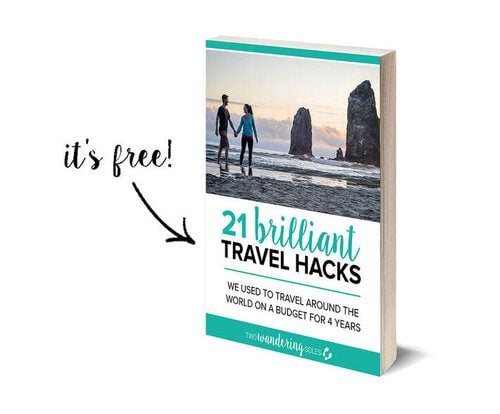
FREE e-Book
We Traveled the World for 4 years on a Budget with these 21 Brilliant Travel Hacks!
[30 pages, money-saving trips, and 100% FREE]
Get your copy NOW!
1. become good at saving money.
It’s a constant learning process, but we’ve been able save quite a bit of money over the years that we use to fund our travels, save for the future and just pay for life… ya know, like eating food and buying toothpaste and stuff.
We’ve got all sorts of tips and tricks that have helped us save enough money to travel extensively and live out of our backpacks (on and off) for 3 years. We’ve put together all of our money-saving advice in one article and hope you can use our hacks to save up for whatever your dream may be
2. Be a master budgeter
No matter if we’re going on a weekend camping trip or a year-long, round-the-world adventure, we always, ALWAYS create a budget. If you don’t set an expectation of how much you’re going to spend, you’re almost guaranteed to overspend.
Sometimes our budget is tight, and other times, we decide that we’ll travel a little more luxuriously. Setting a budget doesn’t mean it has to be a low budget. Heck, you could set a budget of $1,000 USD a day if you’d like. The important part is to know your limits.
Creating a budget can actually be pretty simple and fun. Follow along as we show you exactly how we make a fail-safe travel budget .
3. Find Cheap Flights
You can find amazing deals on flights if you know a few tricks. While there isn’t an exact science that works every time, there are a few ways you can find great deals on flights !
Track your flights
The best way to get a incredible deal is to monitor it frequently. Sign up for newsletters, like Thrifty Traveler and Dollar Flight Club , or join Facebook Groups like Airfare Watchdog . These programs will let you know the best deals right now and will let you in on mistake fares. For example, we recently saw a round trip flight from LA to Hawaii for just over $300! Say whaaaat?!
Do the research
We usually start with Skyscanner because we love the fact that you can see the cheapest days each month to fly. Once we have a flight in mind, we compare the price with other search engines like Kayak and Google Flights.
4. Choose Cheap Countries
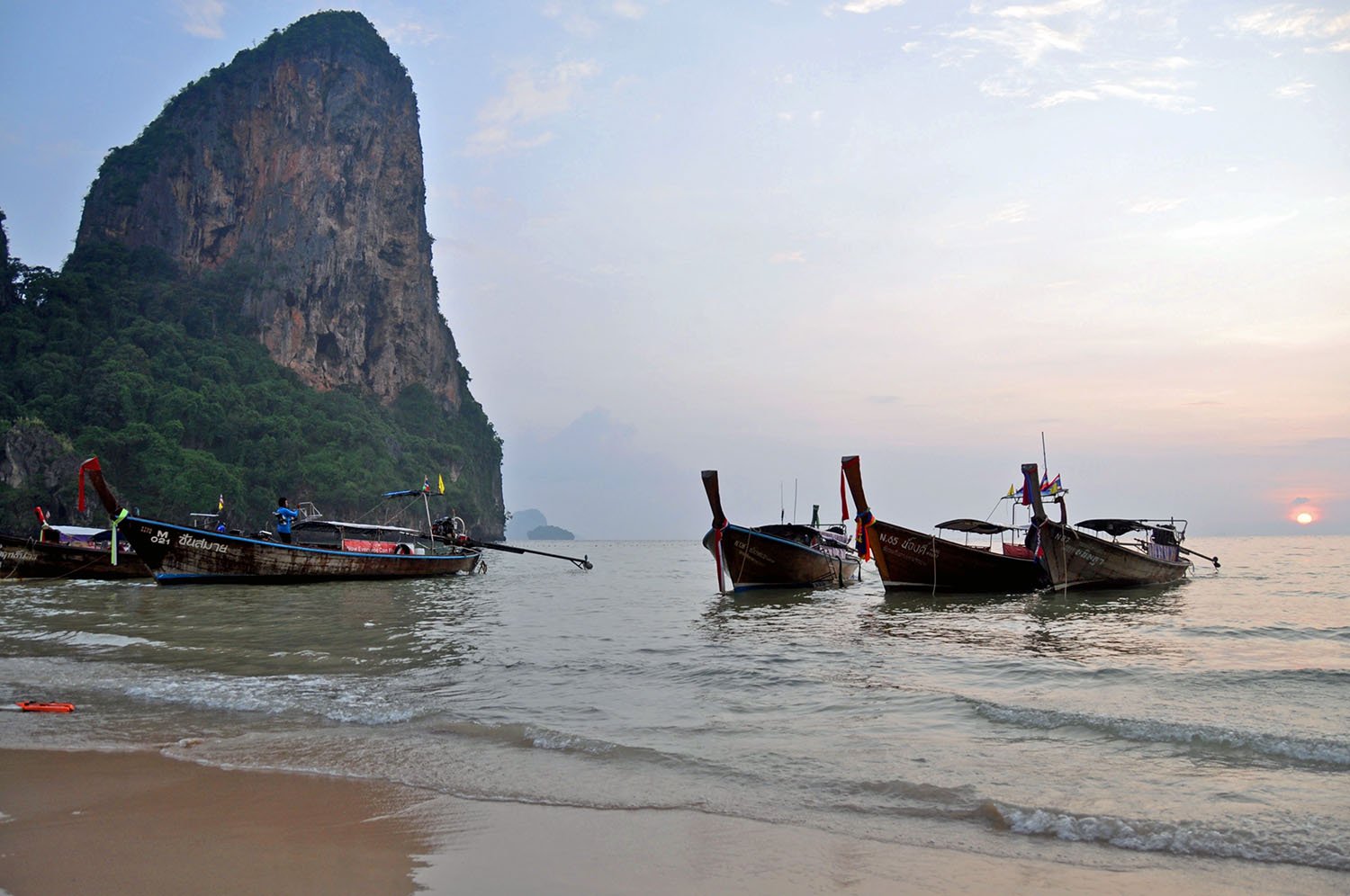
A budget of $5,000 will mean very different things depending on where in the world you plan to travel. In Western Europe, for instance, it might get you 1 month, where in South America you could spend 3 months traveling. And if you bring that amount to India, you could stretch it out to 5 months.
If your goal is to travel longer, choose countries where your money will last longer. Simple.
We typically choose countries where we can travel for less than $70 per day between the two of us because we know we can travel longer. (Plus, many of the places we’re interested in just happen to be inexpensive to travel.)
If you do choose expensive countries, PLAN it out
We have traveled to some infamously expensive places (like Iceland and Japan ), and we’re so glad we didn’t rule them out because of money.
You’ll need to do a lot more planning for expensive countries than you would if you’re visiting a cheap countries. Think about how you can save money: Will you be able to cook? What is the cheapest mode of transportation? And think outside of the box when it comes to accommodation. (Hint: read the rest of this article for all the answers to those questions.
For some budget-minded wanderlust inspiration, find out how we traveled in these notoriously expensive places without breaking the bank:
Galápagos: How to Travel the Galápagos on a Budget
Iceland: Money-Saving Tips for Traveling Iceland on a Budget
Japan: Travel Budget for One Week in Japan
5. Pick the right travel season
Even for cheap countries to travel in, you need to think about the time of year you’ll be visiting because that can really affect your budget.
Croatia in July will be packed with tourists and you’ll be paying top dollar because it’s peak season (we made that mistake). But in October, you’ll still have nice weather and cheaper prices. If there’s a more expensive country you really want to visit, try traveling during low or shoulder season for the best deals.
6. Keep track of all your expenses (yes, ALL of them!)
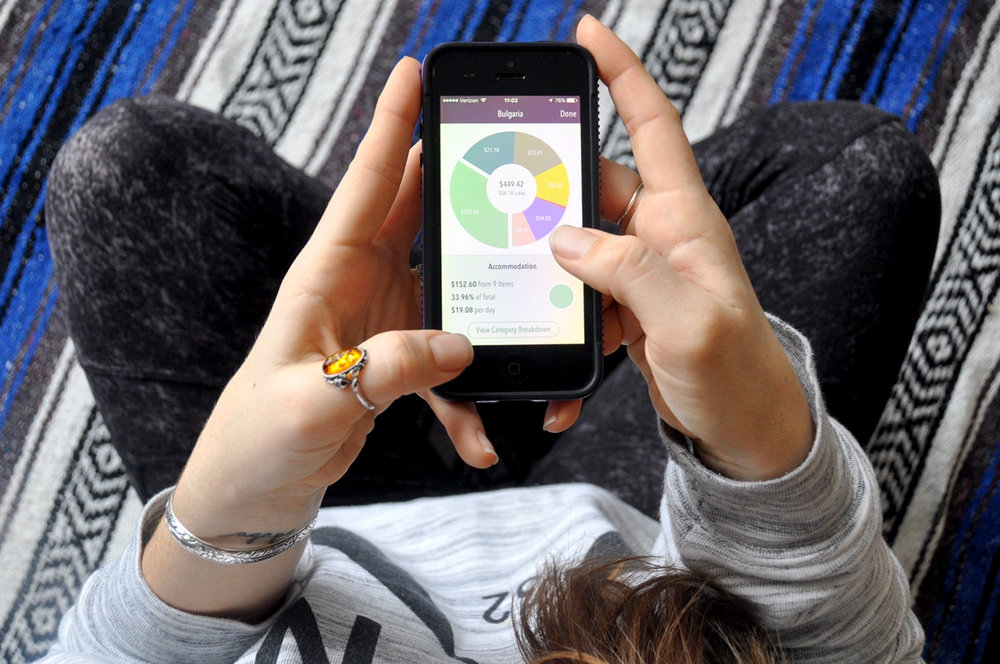
We track every single thing we spend money on while traveling.
And when we say “everything”, we mean everything: accommodation, food, transportation, tours, entrance fees, beers, and yes, even that woven bracelet we bought from a small child that was too cute to resist.
It may sound extreme, but it is the best way to stay on top of a tight budget, and after a while it becomes a habit. There was one month we realized just how much money we were spending on ice cream, and let’s just say that we tried to cut down on that habit a bit…
There are plenty of apps out there to keep track of your budget so make sure you try out a few and pick one that works for you.
7. Get the Best Travel Credit Cards
Never pay an ATM fee again. That’s right, NO ATM fees anywhere in the world! We are seriously obsessed with this card (and it’s not a credit card), so get ready for our ravings…
The Charles Schwab High Yield Investors Checking Account debit card is a must for any serious traveler because it’s free to set up, there are no annual fees, and they reimburse ALL ATM fees at the end of each month.
Whenever we enter a new country, we take out the local currency at an ATM. We’ve found this to be more reliable than currency exchangers (some can really rip you off!), and more convenient than bringing currency from home. Some months we’ve been reimbursed as much as $50. This card has seriously saved us hundreds (if not thousands) of dollars.
Tip: Be sure to take a picture of each ATM receipt so you have a record of the amount that your should be reimbursed.
The Travel Credit Cards we use:
We’re going to go over exactly which cards we actually use, as well as the reasons we love them.
Caution: The cards we use might not be the best choice for you, especially if you are just starting out with credit cards. Also, remember there are two of us. Some of these cards, we EACH have, while others only one of us has.
American Express Platinum – Great for: Lounge access, Uber credit, extra airline perks, sign up bonus
Chase Sapphire Preferred – Great for: Sign up bonus, Extra bonus for using miles when purchasing travel (If you have great credit, you should apply for the Chase Sapphire Reserve which is the elite version of the Preferred.)
Capital One Venture – Great for: Everyday card, good sign up bonus, easy to use miles
Barclays Arrival Plus – Great for: Great sign up bonus, easy to use miles, similar to Capital One Venture
8. Pack Light and Pack Right

We have certainly been guilty of over-packing in the past and we’d lug around extra clothes we never wore. The luggage fees that many airlines have started enforcing made us simplify our packing list so it’s down to the essentials.
Carrying less makes us feel more free, plus, packing light means you can carry on your luggage and you won’t have to pay those pesky baggage fees, which can add up if you have multiple flights.
Find out How to Pack Everything You Need for Travel in a Carry-On , where we share all our packing tips and the best gear we can’t travel without.
Related: Eco-friendly travel gear you can take anywhere that will save you money
9. Watch what you eat

Food can add up while traveling since you’ll likely be eating out lots of the time. Here are some tips for finding cheap (and delicious!) food on your travels:
Go to happy hour: Order drinks and appetizers on discount for a fun dinner!
Try street food: It’s often the best (and most authentic!) food you’ll find on your travels. Pro Tip: If you’re nervous about sanitation, choose stalls that have a line because you’ll know the food is not sitting for long.
Ask locals where they eat: Try asking, “Where do you eat for lunch?” or “If you were to go out to eat, where would you go?” instead of saying, “Which restaurant do you recommend I try?” Sometimes when asked this last question, they’ll point you in the direction of restaurants that are popular with tourists instead of locals because they may assume that’s what you want.
Pack a picnic: In expensive places, picnics are a great way to save money on food. Stock up with staples like bread, cheese, veggies, hummus, fruit, cookies, wine(!) and whatever else your heart (or tummy!) desires. Enjoy your meal with a view and save the leftovers for the next day!
Split your meals: Whenever possible, try to split with others. Oh, and Ben and I split a lot. Typically we get two meals, but if we want a smoothie or a dessert, we’ll only order one. When you’re trying to save money (and you’re part of a couple), it just doesn’t make sense to ALWAYS get two $4 ice cream cones. At least, this is what I try to convince myself…
Have a big lunch: Make lunch your biggest meal of the day when prices are often lower for the same dish than at dinner time.
Know which restaurants to avoid: Stay away from restaurants where someone is calling you inside. This is a sure sign of a tourist-trap restaurant where prices are inflated and food is mediocre. Avoid restaurants near tourist attractions or on main city streets. They pay higher rent, which is reflected in the prices of their food.
10. Take Public Transport
Avoid taxis and chartered vehicles. Instead, take public transportation — metros, buses and trains. Not only will you rub shoulders with locals and have a more authentic experience, but your wallet will thank you. Renting a bike is also a good way to explore a city and it’s usually cheaper than taking taxis.
Pro Tip: Research what apps are popular for transportation in the country you’re visiting. In much of Asia, for example, Grab is a cheaper alternative to Uber. And in Europe, try using BlaBlaCar – a ride sharing app.
11. Take advantage of free activities
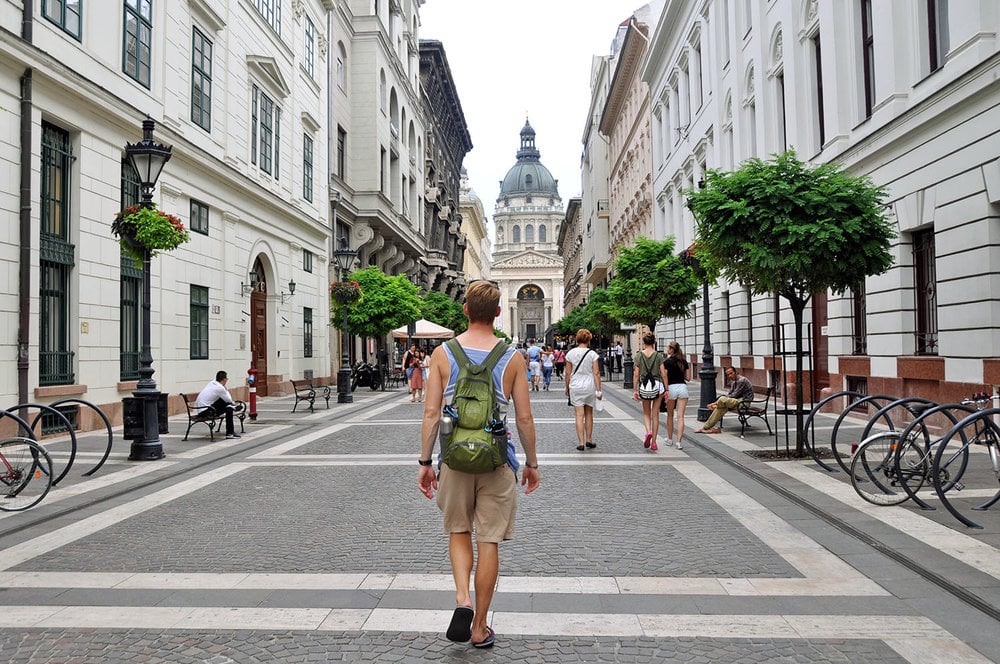
No matter how expensive a country you’re visiting, there are always free things to do! Try searching Google for ideas: “free things to do in __________”. Here are some of our favorite free (or cheap!) things to do in any place we visit around the world:
Take a free walking tour
Explore local markets
Rent a bike and see the city
Have a picnic at a park
Explore free museums
Go on a hike
Get a killer view at a rooftop bar or tall building instead of paying the steep prices of the popular tourist views
12. Talk to Locals
Don’t be shy: ask the locals what they do on the weekend. Ask the man next to you on the bus or your waitress or a stranger in front of you in line at a coffee shop. You’ll get a good idea of authentic ways to see their city, and much of the time their suggestions will be cheaper than the touristy alternatives.
13. Cook whenever possible
In Europe and South America, we typically stayed at places with kitchens and were able to cook many of our meals, which saved us tons of money.
In our 5 months traveling Asia, however, we never once had access to a kitchen ( except for when we took cooking classes, of course! ). And it was fine because food there – especially the local stuff – is so cheap that cooking wouldn’t have been any less expensive.
14. Choose your splurges wisely
If you’re traveling for a long time, you can’t do it all. You need to choose what experiences are important to you, and you’ll also need to get comfortable passing on some things.
Splurging on once-in-a-lifetime experiences ( like taking a hot air balloon ride in Turkey! or whale watching in Victoria, British Columbia ) is part of traveling. You’ll regret it if you don’t. But choose your splurges wisely and know when to pass. Your budget will balance itself out.
Trust us… we know about splurging all too well. We’re obsessed with eating (everything!), we usually spend a little more money on comfortable accommodation, and we can’t resist adventure sports.
But we cut costs in other ways and pass on things that we know we know we won’t regret.
15. Find Deals on Hotels

Accommodation adds up quickly and can often be the biggest expense while traveling, but there are ways to cut this cost significantly. Accommodation does not have to be expensive!
Just to give you an idea, during our year of round the world travel , the most expensive place we stayed was $55 per night for the both of us (in Lake Bled, Slovenia).
And believe us – we were not slumming it during our travels. We stayed in some pretty fantastic places, and the sites below are how we got got ahhh-mazing deals:
If you are traveling in Asia, Agoda is hands-down the best place to find cheap accommodation. This site is easy to use and has a great review system, so you’ll easily get a feel for how nice each hotel is. And the deals are unbeatable.
Booking.com
We loved using Booking.com when we were in Europe and traveling around the U.S.A. They have really good hotel deals and are always running discounts on night stays. They typically have free cancellation as well, which is a nice perk.
In Europe and the US, we love Airbnb because we we’re able to stay in a more “local” area and have access to kitchens so we can save money on food.
Try out Airbnb . If you’re new, sign up here and you’ll get $55 off your first stay ! Yes, seriously – no gimmicks!
We have loads of info on how to book Airbnbs, red flags to watch out for when booking, and our favorite Airbnbs in our Airbnb article .
Hostelworld
Before you get all judgey when you hear the word “hostel”, keep reading…
Hostels are almost always cheaper than traditional hotels, and contrary to popular belief, they are not just dorms! There are almost always private rooms that are quite affordable. Plus, many hostels have kitchens you can use, free breakfast, affordable tour options and local advice. And they typically have a common space where you can meet other travelers and exchange stories and travel information.
Couchsurfing
Another option to try is Couchsurfing . It’s completely free and you’re able to stay with a local which can lead to some unforgettable experiences that you wouldn’t be able to have in a hotel. And who knows, maybe you’ll make a new friend! Before trying it out for the first time, you might want to read about Couchsurfing safety and tips so you feel more at ease.
Depending on where you are in the world, camping can be a great way to save money on accommodation (and it’ll add to the adventure!). Be sure to really research the laws in your country when it comes to where and when you can pitch a tent, and invest in quality gear. There’s nothing worse than waking up to a soaked tent and sleeping bag.
One potential downside of this option is that you’ll have pack your accommodation with you. You’ll have to find the balance between minimizing your load, while still being prepared.
16. Travel slowly
If you only have 2 weeks, it makes sense to bounce around quickly. You’ll want to see as much as you can in the time you’ve got (even if you’re fighting back to the urge to quit your 9-to-5 to travel ).
But if you’re traveling for an extended period of time, you’ll need (and want!) to slow down. Traveling for a longer period of time can be much cheaper per day than a short trip. Bus rides are cheaper than flights and agreeing to stay somewhere for a week might land you a great deal.
17. Do a skill exchange
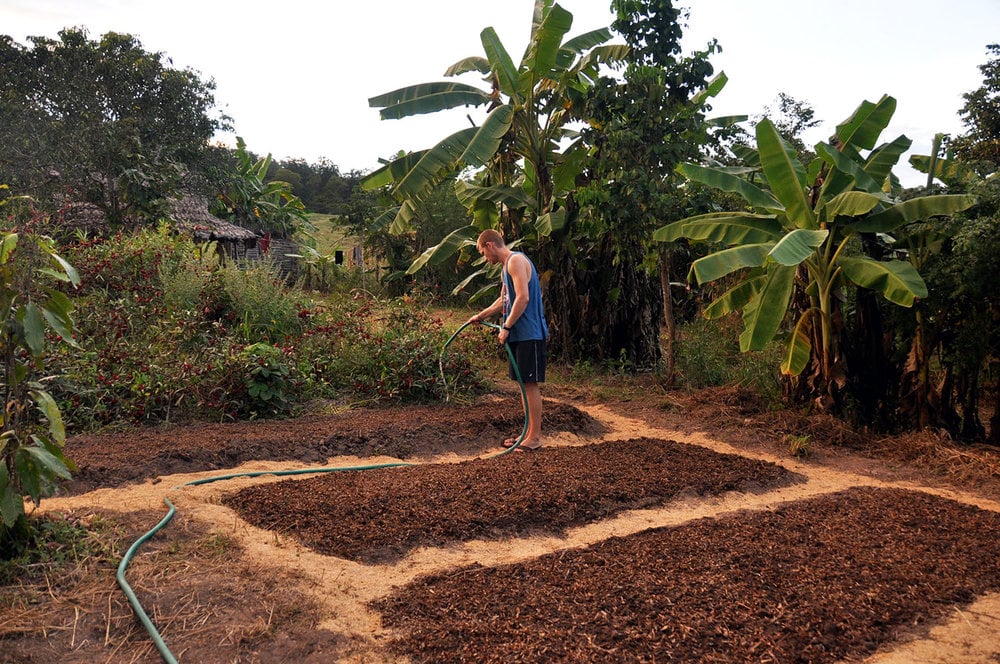
And while we’re on the topic of traveling slowly… Volunteering on your travels is a great way to delve into a community, make a positive difference and get free (or very inexpensive) room and board.
We’ve had great experiences working on organic farms through WWOOF and WorkAway . HelpX is another site trusted by travelers to find volunteer opportunities overseas. And if you want to/able to stay in one area for an extended period of time and don’t mind taking care of an animal, you could try House Sitting .
Caution: Whenever talking about volunteering abroad, we caution people to really do their research. “Voluntourism” is a growing industry and there are many programs that are actually detrimental to the communities in which volunteers work.
Many of these programs also require a hefty fee, so they are by no means a cheap alternative to travel. There are great organizations out there, so don’t let this warning scare you away!
18. Drink from the tap
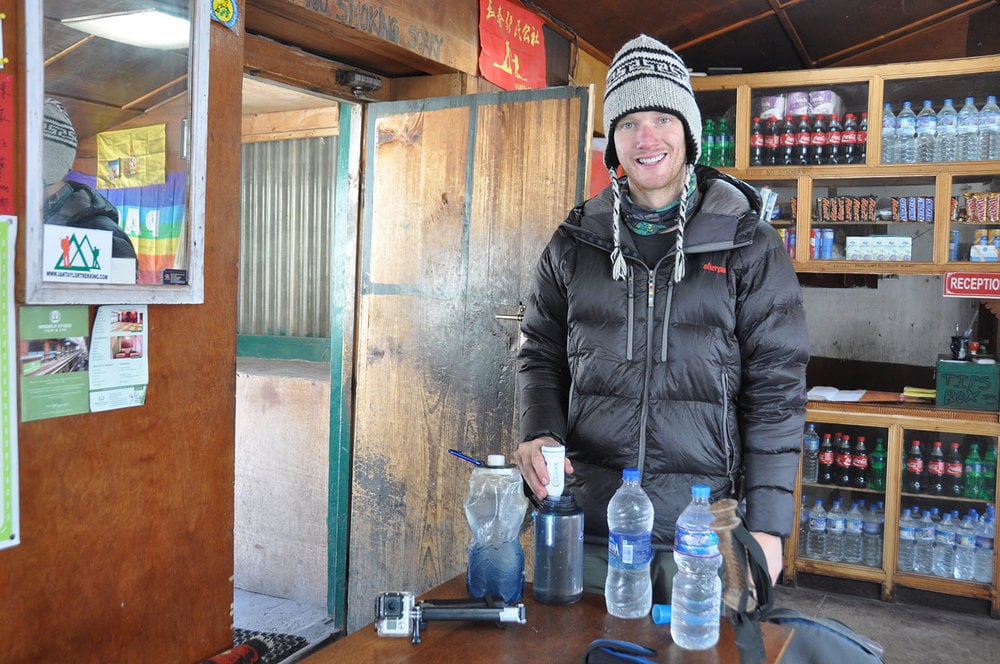
Ben sterilizing water on our trek to Everest Base Camp
Water isn’t something you really think about when you’re packing for long term travel or figuring out a budget, but it should be on your radar.
If you’re planning to visit countries in Central and South America, Africa or Asia, a Steripen should be on your list of must-get travel gear! In many regions of the world, you can’t drink from the tap, and buying plastic bottles of water is not only wasteful, it can be very expensive (especially if you are hydrating properly!). So using a Steripen to sterilize your water is an amazing money-saving (and waste-saving!) tip.
Being the Excel-loving nerd he is, Ben calculated how much money our Steripen saved us during our 3-month trip to South America, and it was surprising… We saved over $200 in 3 months, because we rarely needed to buy water bottles.
Read more: Check out this article with some of our favorite money-saving gear and resources .
19. Avoid being scammed
While we are big believers that there is more good in the world than bad, there are unsavory characters in every city and country. However, while traveling you’re in unfamiliar territory. This can make you a bigger target for people trying to scam you and take your money.
A couple pieces of advice are to Google “common scams in _____” before visiting a new place. Each country has scams of their own, and once you’re aware of them, you’ll be less likely to fall victim.
And as a general rule of thumb, the most common places to be scammed are before, during and after transportation. For example, the time between landing at the airport and getting to your hotel. This is when you are carrying all your luggage, tired from traveling and in a totally new place.
Being aware and cautious can save you from losing money to scam artists.
20. Make money on the road
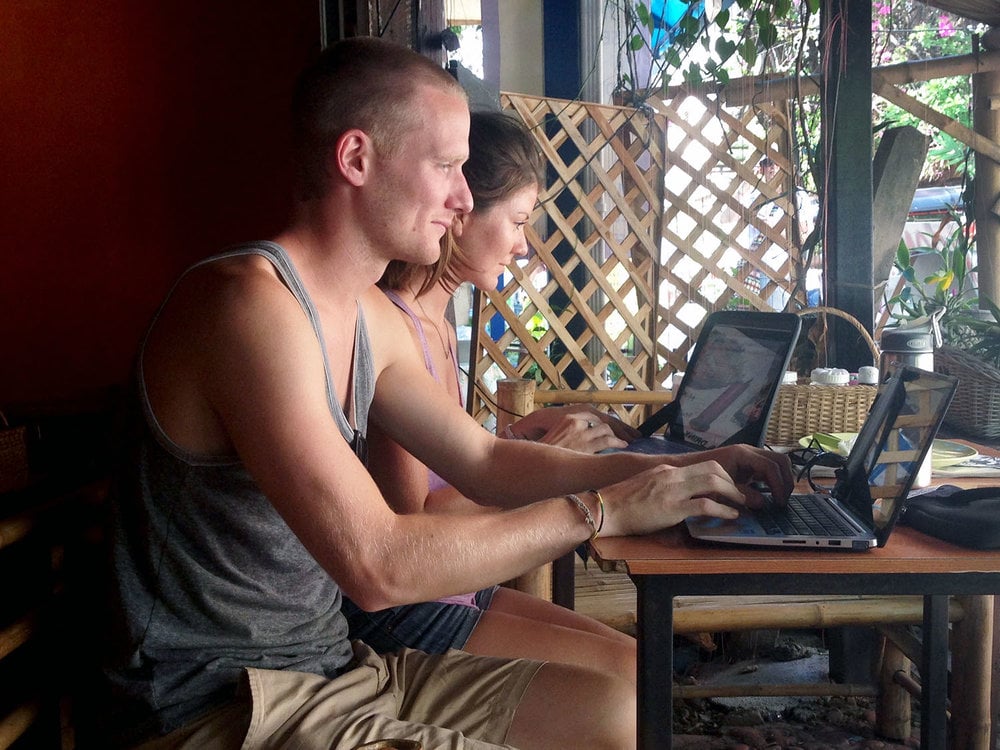
There are lots of ways to earn a little cash online (or a lotta cash! – depending on how much time you can dedicate).
Freelance work: There are quite a few sites out there that connect freelancers with clients looking for all types of help on their business. I used to use Upwork.com and had luck finding projects I could do from anywhere in the world.
Teach English online: One super easy way Ben has recently found is to teach English in an online classroom with VIPKID . You can earn anywhere between $16-$22 per hour (plus additional incentives) practicing English with elementary-age students in China. You can set your own schedule, work as many hours as you want and you don’t even need to your TEFL or teaching experience to do it. All you really have to do is be on time, be energetic and be happy, which many of you already are. It will be the easiest money you make online !
Start a Blog: Another way we make money online is through this blog. We’ve shared more information on how to start a successful money-making blog here so check it out!

But don’t be fooled – earning money while traveling isn’t easy. You need to have access to reliable Internet, which can be difficult in some parts of the world. If you are working with clients in your home country, you might need to think about working in different time zones to meet deadlines.
And sometimes, you’re going to have to forgo fun things in order to get work done. Trust us, it’s not easy saying no to a daiquiri on the beach in order to meet a deadline.
21. Teach English Overseas

If you want a long term international experience, we can’t stress enough how great an opportunity teaching English in South Korea was for us. It allowed us to live in another country and really delve into the culture while making (a lot of!) money.
We’ve gone over exactly how much money you can plan to make in one year teaching English in South Korea , so we won’t say much more on the topic other than DO IT if it is remotely interesting to you.
22. Purchase Travel Insurance
Travel insurance is something you just can’t risk going without. It won’t save you much money up front, but if something were to happen, you could save hundreds if not thousands of dollars by being covered.
We’ve met a handful of people who have had unfortunate accidents on the road and have had to be airlifted to nearby hospitals. That type of evacuation ain’t cheap, and it most certainly will add a couple zeros to the end of your budget. Don’t risk it.
Travel insurance isn’t as expensive as you’d think and it will cover these emergencies (even though you hope you never have to use your coverage!). Some policies even cover valuables stolen on the road or delayed flights.
We have an entire article devoted to helping you choose the right travel insurance policy for you ! There aren’t any excuses anymore.
Create a Travel Budget in 6 Simple Steps
Now that you know all our cheap travel hacks and how we afford to travel around the world, let’s create a travel budget just for you.
Your budget will determine how much money you need to save, and it will also kind of shape your trip. For instance, if your travel budget is small, you might opt out of certain cities or activities. And if you’ve got a lotta dough to spend, you can research all the fun things you can do with it!
And we’re going to share with you exactly how we do it, in 6 simple steps. The beauty of this exercise is that you can cater it to fit whatever your dream trip may be – whether it be a one-week vacay in Hawaii or a one-year journey around the world .
And better yet, it only takes about 20 minutes to come up with a really solid plan of how much money you’ll need to save for your trip. So what are you waiting for?
Let’s take the first step in turning your daydreams into reality…
Step 1: Define your Travel Style

Travel is completely personal, and there’s no “right” or “wrong” way to do it. But in order to determine your budget, you’ve first got to figure out your travel style.
Read the following statements and see which one sounds most like you:
Budget Traveler:
“I don’t mind sleeping in dorm rooms or taking local forms of transportation (even though it’s sometimes slower). I prefer eating at authentic “hole-in-the-wall” type eateries and don’t typically like doing organized tours. I enjoy traveling on a budget because it allows me to interact with locals and often brings more adventure than when you pay top dollar.”
Mid-Range Traveler:
“I like a mix of comfort and authentic adventure. I don’t want to sleep in dorm rooms with people I don’t know, but I don’t need a 5-star hotel every night. When traveling, I enjoy eating at a variety of places –ranging from street stands to nice cafes. I like splurging every once in a while, but am okay roughing it a bit too. For me, it’s all about balance.”
Luxury Traveler:
“When I travel, I like to enjoy the finer things – from plush hotels, to the top-rated restaurants and entertainment. I think that a vacation should be full of splurges, and I don’t like holding back. I enjoy once-in-a-lifetime experiences and I like to have all the details arranged for me, even if it costs more money. Traveling is my time to relax and explore, and I don’t want to miss out by sticking to a strict budget.”
So which one is it?
Maybe you are between two styles. Not quite “budget”, but not exactly “mid-range” either. Or perhaps you’re between “mid-range” and “luxury”.
Remember, there is no right or wrong way to feel. But determining what type of travel style you identify with is the first step to coming up with a realistic budget.
Step 2: Find your Daily Budget
Do a quick Google search for a daily budget of a country you’re thinking of visiting. A good site to start with is Budget Your Trip .
Choose a country, your travel style (Step #1) and your currency, and you’ll get a pretty good estimate of how much to expect to spend each day.
Write this number down because you’ll need it for the next steps.
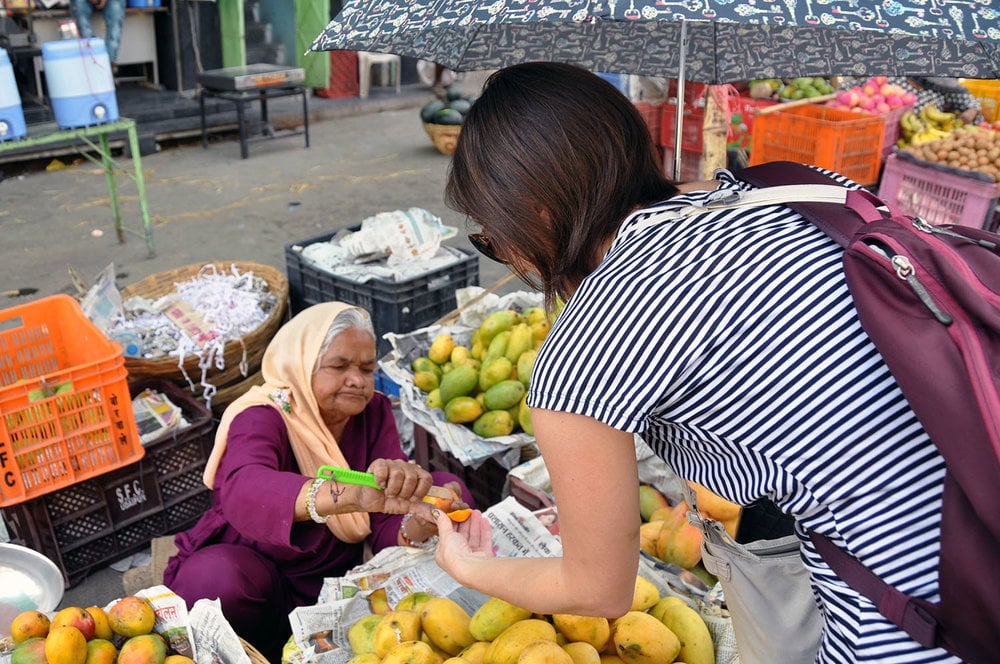
Step 3: Get your Preliminary Total
Multiply the number you got in Step #2 (Daily Budget) by how many days you plan to be there. This will give you the preliminary cost of your trip. But, hold on – you’re not done just yet!
Step 4: Give yourself some “Padding”
Now, calculate 10-20% of the preliminary total you got in Step 3.
You know yourself best. If you’re great at sticking to a budget, maybe you can get by with an additional 10%. But if budgets aren’t your thing, maybe an extra 25% is more realistic. We typically add a 15% padding.
Add this number to your total, but don’t include it in your daily spending budget (Step 2). Remember, you don’t necessarily want to spend this money – it’s just there as a buffer for souvenirs, last minute splurges or incidentals.
Step 5: Plan your Splurges
Even if you have a budget to stick to, splurges are just part of traveling. Don’t let lack of money hold you back from something you’ve been dreaming about, like diving in the Galápagos or a taking a hot air balloon ride in Cappadocia . It may be expensive, sure, but it’s part of your journey. And if you want it badly enough, it’s worth it.
Plan out your splurges so you’re ready for them. (Include this cost in your total budget, but don’t divide it into your daily spending.)
And when you do splurge, make sure it’s with a ethical company giving back to the local community and environment. Read our 36 Tips for Traveling Responsibly article for more information.
Step 6: Add on Airfare and Travel Insurance
Note that when you search for a daily budget in a particular country, it will typically NOT include airfare or travel insurance. You will have to add these costs in as well.
For airfare: We like getting airfare estimates on SkyScanner because you can search an entire month and see the cheapest day to fly.
For travel insurance: We like World Nomads for travel insurance. Get a super quick quote here.
And there you have it: Your own fully-customized travel budget! CONGRATS!
Tip: You can also do this exercise in reverse. What I mean is if you have $3,000 USD saved up, and you want to visit Thailand , start with Step #6 and work backwards by subtracting the costs. You’ll be able to see how many days a reasonable budget will bring you with $3,000 USD to spend.
Interested in more budget travel resources?
Be sure to check out our Budget Travel homepage for resources on everything you need to get your travel budget started and more! Or you can read some of our favorite articles about budget travel below.
How to Find Cheap Flights: 17 Expert Tips
8 Reasons Why You Should House Sit and How to Get Started
Money-Saving Tips for a Cheap Road Trip Across the USA
Plan a Trip: The Ultimate Guide to Budgeting, Planning & Packing
Save this article on Pinterest for later!
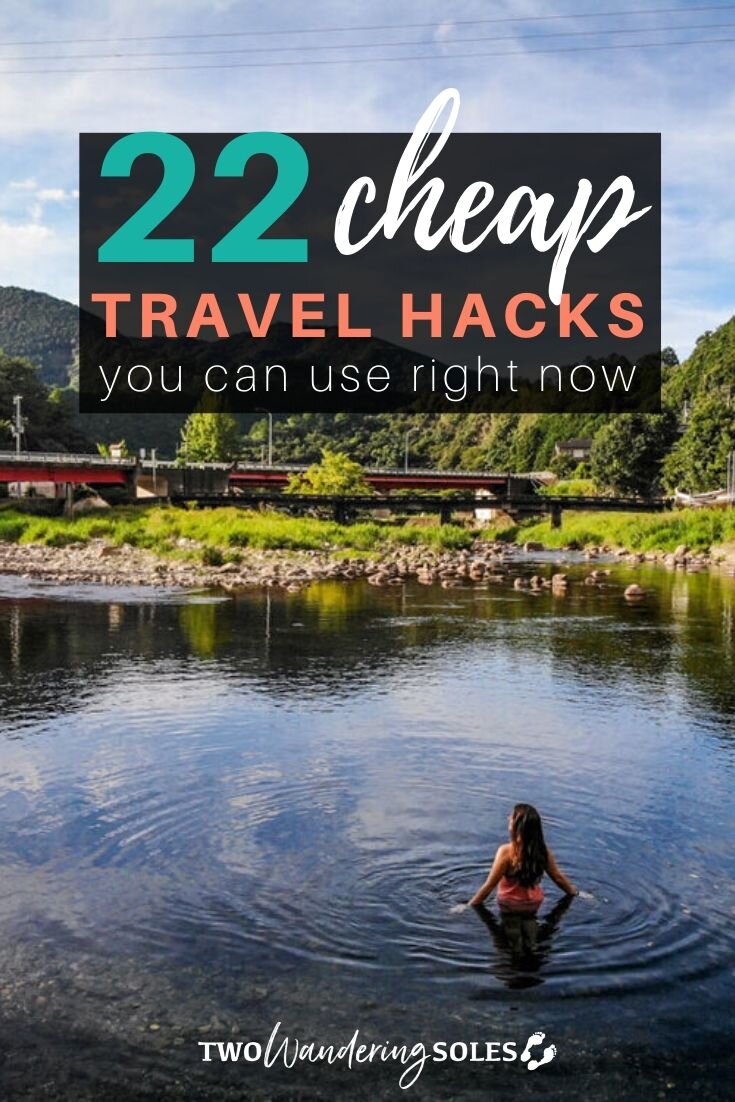
We want to hear from you!
Which cheap travel hack do you like the best? Which one will you use next? Have you created you travel budget? Let us know in the comments below. Or ask us anything about budget travel, we’d like to help you out!
Comments (13) on “ 22 Cheap Travel Hacks You Can Use Right Now ”
Thanks for sharing such valuable tips.
Hi, great tips! If I may add a few more especially related to money — since travellers from outside the US cannot get the charles schwab card – there are other ways to avoid ATM Fees – I use this app – it gives you a list of ATMs with the ATM Fees in 30-40 foreign countries along with withdrawal limits for foreign card holders so you can choose the ones which do not charge any fee to foreign card holders. Also, I always decline conversion at foreign ATMs or select “Without Conversion” and not exchange cash at airports, worst currency exchange rates ever.
Very useful tips to save money.
Great! Also, nice advice also check this out http://bit.ly/2WuFwkQ it might help as well.
I actually spend very little time finding deals! The key to getting a good deal is to be spontaneous, especially while traveling, so thanks. These is STUNNING TIPS!
Hi You Two!
Thank you so much for this incredible article and your site as a whole. My husband and I are getting ready for our first RTW trip, starting in November. This article had tons of valuable information in a concise and efficient way. We so appreciate you!!
Thanks so much Sophia, glad you liked all our travel hacks!
Wow – super comprehensive guide! Thanks for these tips! I’m pretty good at getting deals but I definitely got some new ideas here!
Great, happy to hear you got some new ideas!
Thank you for breaking down the expenses of travelling in South East Asia vs normal living in the states. This helped me get a grasp of what I will need to budget for when I decide to travel that way for 3 months! Thanks again, very much appreciated!
Thanks for the kind words, Kraig. We are so glad it has been helpful to you. Best of luck as you plan!
Stumbleupon your travel blog. My GF and I started
Great Derek, glad you found us 🙂
Leave a Reply Cancel reply
Your email address will not be published. Required fields are marked *
Save my name, email, and website in this browser for the next time I comment.

Postcard Narrative
The Proof is in the Postcard

23 International Travel Hacks: Genius Tips We Wish We’d Known Sooner
Whether you’re an experienced traveler or about to embark on your first international vacation, it’s normal to feel some unease about the unknowns and the “what ifs” of a new place. The key to enjoying the journey, including its unexpected twists, lies in mastering a few crucial international travel hacks.
In this post, we’ll dive into the essential strategies for saving money abroad, flying internationally, staying safe, and even more hacks to feel ultra-prepared.
The Best International Travel Hacks
Book accommodations direct.
This international travel hack was contributed by Sally from Sally Sees.
Your accommodation is one of the most important parts of travelling. It’s also one of the most expensive!
The bulk of most people’s travel budgets is allocated to accommodation. Whether you’re staying in dorms beds in hostels or in luxury resorts, you’ve got to have a place to sleep every night, and those costs add up fast.
If you’re willing to commit a bit more time and effort to booking your accommodation, you can save a ton of money with this handy tip.
Third party booking engines like Booking.com or Airbnb are fantastic ways to find accommodation options. However, they all take a decent cut out of the price you pay for your room.
Airbnb is particularly bad for this, and if you checked out the invoice for any of your recent bookings, you’ll most likely find $50 + of Airbnb fees.
By booking directly with the accommodation provider, you can usually get a cheaper rate and save the extra fees whacked on by the booking company.
This can be a little tricky when its an Airbnb, and it generally only works when the host is actually an accommodation business, rather than a spare room in their house. It’s usually possible to work out how to contact the host directly and organize your stay outside of the app, if it’s something you and they are comfortable with.
This trick works particularly well in countries like Mexico , where there are a lot of accommodation options that aren’t big enough to advertise on sites like Booking.com or Expedia. They use Airbnb to list their property, but are happy to receive bookings directly from travelers.

Exchange Money Before Traveling
Recommended by Eleanor of Elevate Your Escapes
Before leaving for your trip, go to the bank or AAA and order local currency. Many banks will allow you to specify what bills you order. I recommend ordering mostly smaller bills. These bills are very useful for tips, taxi rides, water bottle purchases from corner stores, souvenirs from street vendors, and so much more.
Many travelers know to get local currency before traveling but end up with larger bills that they then have to spend time and money breaking. Though credit cards are accepted more widely now, it’s not always the case. I’ve found myself in situations where I’ve had to pay taxes on hotel rooms and entrance fees for historic sites in cash.
Most banks, like Chase and CapitalOne, will exchange money with no fees. Some banks do charge fees, so always call ahead to be sure. You’ll also need to order the money 3-5 business days in advance of when you need it.

Avoid ATM Hidden Fees
Now, let’s say you didn’t get around to acquiring foreign currency before your trip. Whatever you do, don’t exchange currency at the airport! The airport vendors charge enormous fees.
Hopefully you can make it out of the airport and to your accommodation with the us e of a credit card without foreign fees. When you do, look for a bank ATM. The small ATM use fees will be far more economical than currency counters.
While using the ATM is the preferred option for withdrawing cash during travels, sometimes the prompts can be misleading. The machine will ask you whether to process the transaction in local currency or in your bank’s currency. Always choose local. Read more on this below.
View this post on Instagram A post shared by Catherine – Savvy Family Travel (@postcard_narrative)
Pay in Local Currency
Contributed by Jess from Uprooted Traveler
When traveling abroad, you’ll oftentimes have the option of paying for things at restaurants and businesses in either the local currency or United States dollars.
While it may feel tempting to pay in your more familiar home currency, this almost always comes out to be the more expensive option for you in the long run. In fact, studies suggest that not paying in the local currency results, on average, in paying anywhere from one to three percent more than the bill actually costs—which will not be clearly disclosed to you on the receipt itself! This is almost always higher than what your home bank would charge for paying the transaction in a foreign currency (but you should be traveling with a credit card with no foreign transaction fees anyway!).
This practice of charging customers to spend their home currency, called dynamic currency conversion, regularly occurs in destinations around the globe. So whether you’re paying for a wildlife spotting tour in Costa Rica; riding the Hogwarts Express in Scotland ; or going to Angkor Wat in Cambodia and have the option to choose how to pay, always remember to use the local currency!

International Flight Hacks
Locate children’s areas in airports.
Contributed by Sara of Big Adventures With Little Feet
If you’re a regular traveler with kids then you know how hard it can be to entertain them at the airport. Especially when you’re connecting between flights and might have a layover of a few hours or more.
Did you know that some airport lounges have children’s play areas in them? Yes, small play areas with loads of fun things to do, and they’re never as busy as the main airport ones. Or, that most airport lounges have large windows over the runway? This is perfect for watching the planes takeoff and land. Plus, the obvious perk for both adults and kids – unlimited food and drinks!
It used to be that airport lounges were reserved for first-class and business-class travel. However, not anymore. Airport lounge access can now be found as a regular perk with some bank accounts and credit cards . If you shop around you can sign up and get instant access to hundreds of lounges all over the world.

Save Time at Immigration with Global Entry
Submitted by Karissa of In Old Cities
You may already know that lots of travel credit cards offer tons of points and miles, making it possible to fly around the world for free . But did you also know that many of those same credit cards can also help you speed through immigration when you return to the United States after international trips?
It’s through a perk related to a U.S. Customs and Border Protection program called Global Entry. If you’re approved for Global Entry, there’s no need to stand in long immigration lines after landing in the U.S. — just pop over to a Global Entry kiosk, get your photo taken, and breeze right past that crazy line for passport control. Plus, you get automatic access to TSA PreCheck!
The application for Global Entry costs $100, and your membership is valid for five years. Here’s where the travel credit cards come in: they’ll reimburse you for the full cost of Global Entry. Just pay for your Global Entry application with one of these cards, and you’ll get a $100 statement credit.
Popular travel credit cards offering this perk include the Capital One Venture cards, Chase Sapphire Reserve, and AmEx Platinum.

A Free Alternative to Global Entry
Mobile Passport is a shortcut through immigration when entering the United States because it bypasses the need for the paper immigration forms.
Travelers who can show their Mobile Passport Control App are often redirected to a shorter line.
Packing for International Travel
Know the liquid requirements.
Contributed by Rachel of Barcelona Uncovered
Trying to get to Europe from America? There’s a strong chance you might be flying through London’s famous Heathrow Airport (LHR). Heathrow connects many US flights to popular cities such as Paris, Rome, and Barcelona .
Unfortunately, this layover means tons of travelers lose their travel-sized liquids to Heathrow’s strict liquid requirements daily. Don’t let that be you! You may have to slim down quite a bit of your current travel liquids in your carry on to adhere to this one.
Per Heathrow’s requirements , liquids must be carried in 100ml or less containers separately in a single, transparent bag measuring 20cm x 20cm. That’s not a lot of liquid!
Even if you have Global Entry or TSA PreCheck leaving the States and get out unscathed, you’ll want to remember to pack accordingly and bring your Ziploc baggie for when you arrive at or depart from LHR.
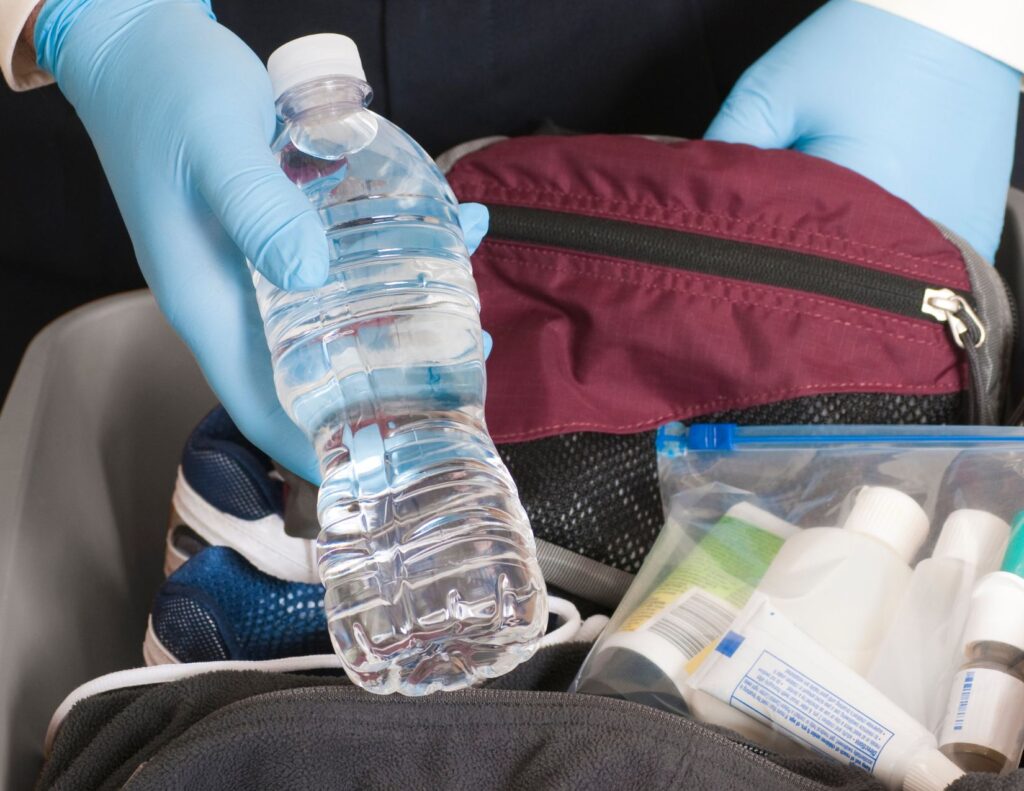
The Item You Never Thought to Pack
Olga, from A Girl in Istanbul , says that bringing a portable carbon monoxide detector is the best way to gain peace of mind anywhere in the world. With several incidents reported at hotels and rentals in very popular destinations, taking this preventive measure could be a smart choice for every traveler.
But what is carbon monoxide? Carbon monoxide (CO) is a gas that’s usually used in households for water heaters, boilers, gas stoves ovens, etc. but can be dangerous and deadly.
It is known as the “invisible killer” according to the U.S. Consumer Product Safety Commission, as CO is odorless and tasteless that makes it undetectable by our human senses.
How does it work: The carbon monoxide detector is a safety device that monitors the air for carbon monoxide levels 24/7. When detecting carbon monoxide beyond the safe level, it activates the alarm warning the traveler to take action and leave the place on time.
Most portable Carbon Monoxide detectors can be found on Amazon or Walmart for as little as $18. They’re typically around 4-5 inches, making them suitable for every budget and every luggage.

Filter Your Drinking Water
Submitted by Claire of Tales of a Backpacker
As international travel hacks go, having safe access to safe drinking water wherever you go has got to be the most useful. A reusable water bottle with a built-in filter means that you can fill up from any fresh water source and know that you can drink the water safely.
It works for everything from muddy ponds and streams to bathroom sinks and non-potable tap water, so you can save yourself from all the nasties that can come with drinking tap water abroad.
Once you’ve got one of these filter water bottles you’ll never look back – as well as keeping you safe and well you will also save money as you won’t need to buy bottled water, and you’ll reduce your plastic waste too so it’s great for you and the environment.
There are various brands that make filter water bottles, and they use different techniques to clean the water. For international travel make sure you choose one which filters bacteria and viruses as well as other particles like dirt heavy and metals, like Water-to-Go or Grayl.

Documentation to Carry
Recommended by Ann of Packing Light Travel
Have you been asked by service providers to present your passport while abroad? It might have been when checking into a hotel, purchasing a SIM card, buying alcohol, seeking medical attention, or confirming an online purchase of a hiking permit.
In each of these cases, and other scenarios except when crossing a border or visiting an embassy or diplomatic mission, a laminated copy of the information page of your passport will likely satisfy the needs of the person making the request.
If this is your experience, carry a laminated copy of the information page of my passport in your purse, personal item, and travel bag. What issue does this resolve? Each time you hand over your passport, there’s no guarantee it will be returned in the same condition (or returned at all).
Someone purporting to be a law enforcement officer attempting to extort money for the return of an actual passport will be foiled when presented with a laminated copy. If a service provider’s coffee is spilled on a laminated copy, you won’t be denied boarding an aircraft because of a damaged passport. A copy can also be useful if you can’t speak for yourself because of an accident and your passport is locked in a hotel safe. It provides first responders with your name, age, and citizenship. These can be invaluable in getting medical attention and consular support.
For more information, see 9 simple reasons to carry laminated copies of your passport .

General International Travel Hacks
Ensure accessibility needs are met.
Kristin from World on Wheels shared this crucial international travel hack.
If you have special mobility requirements, it is important to remember to ask about the accessibility of a hotel or attraction you want to visit as not all countries have accessibility laws that require accommodations to be made. Furthermore, simply asking if something is accessible will likely lead to misinformation due to people’s perceptions of what that word means (which may also be influenced by cultural differences).
Instead, ask specific questions based on your abilities. For example, ask whether there are stairs required, if there is an alternative step-free route, whether a bus has a wheelchair lift, etc. This will help avoid disappointment from being told something is accessible, only to find out it doesn’t meet your needs.
Similarly, another example of things to consider is the size of elevators. Often outside of the US, if elevators (or lifts) are present, they may be significantly smaller than what you are accustomed to.
So, for example, if you are looking for wheelchair accessible hotels in London , you’ll want to ask questions such as “What are the dimensions of your elevator” and “Is your elevator currently working” as even if you find a lift that will fit your mobility device, due to age or maintenance, an elevator may be out of order and you don’t want to be stuck once you arrive, expecting that it will be working.
Asking specific questions about accessibility when traveling internationally will not only help to ensure that your needs are met but avoid disappointment from being given incorrect accessibility information as well.

Apply for Visas Online
Victoria from Guide Your Travel recommends this international travel hack.
Applying for visas online has revolutionized the travel process, offering convenience and efficiency for travelers worldwide. For example, in Bali , travelers can now apply for a visa online, streamlining the once tedious process.
Bali’s online visa application process eliminates the need to visit a consulate or embassy, saving time and effort. travelers can complete an online form, upload the required documents, and pay the visa fee electronically. Once approved, the visa is emailed and ready to be presented upon arrival in Bali.
This innovation solves the problem of long visa application queues and complex paperwork, which is particularly beneficial for travelers on tight schedules. It is helpful for those who wish to avoid jet lag by reducing time spent at airports or embassies.

Invest in a Universal Adapter
Suggested by Catherine at Day Trip Nomad
Packaging a universal adapter may be one of the most easily forgettable travel hacks, but this simple device solves a problem many travelers encounter when venturing abroad: the vast array of electrical outlet types and voltage compatibility issues.
The last thing you want is to arrive at your destination late at night and be unable to charge your devices, leaving you disconnected from your maps and travel guides or missing a picture-perfect moment on your camera or phone.
Electrical outlets and voltages vary around the world. Universal adapters are designed to fit multiple types of sockets. Most models feature a range of sliders or detachable parts that adjust to fit the specific socket type of the country you’re visiting. Before you travel, check which plug types your destination uses, although a well-designed universal adapter should cover the most common variations.

Get Educated on Vaccinations
Recommended by Shweta from Zest In A Tote
The essence of international trips is to go to far-off lands, where the culture, food, traditions are different from your home country. It sounds exciting and is. But with most countries, you do need to check on health safety and requirements. One key aspect for health safety is vaccination. This is especially true if you are travelling outside of the US and Europe: to countries in Asia, Africa, Latin America and the Caribbean.
Let me illustrate this with an example of a recent trip to Jamaica. Before finalizing the Jamaica itinerary , I read on general safety and health safety on this tropical island. Some vaccinations are recommended before your Jamaica trip: Hepatitis A and B, Typhoid, Rabies, Measles, mumps & rubella (MMR), TDP (tetanus, diphtheria & pertussis), Pneumonia.
Being Asian and living in a tropical country, I and my family members were already vaccinated for the above list. But if we weren’t given the dose for any particular vaccination, we would have scheduled a doctor appointment and done the necessary medication before the trip. There is absolutely no reason to endanger health when common tropical diseases can be easily prevented by vaccination. A no brainer when it comes to international travel hacks.

eSim Cellular Coverage Abroad
One of my favorite international travel hacks (that I only found out about in 2022) is the ability to install an electronic sim card to my smart phone before even traveling!
Gone are the days of me trying to hunt down a corner store to purchase a physical sim to use while I’m in a specific country.
I’m a huge fan of Airalo’s eSims so far. Their prices are fair and I love that there are regional sims so I don’t need multiple as I cross borders.
Here are some sample costs, as of March 2024.
Cost for a 3GB, 30 Day eSIM on Airalo (Lesser plans are available.)
- European Region $13
- Japan $8.50
- Costa Rica $22
We’ve purchased European-wide Sim cards a couple times now and also one for Tunisia. My friends and family said Airalo worked great in South Korea and Brazil as well.
It’s easy to add an eSIM under your cellular settings.
Language Translation
Submitted by Sharon from I Travel Peru
One of the travel hacks I wish I had known sooner is how useful the Google Translate app can be.
I regularly travel internationally, including to countries with a very different alphabet, like Thailand, where it doesn’t matter if you understand a bit of the language: if you can’t read it, it’s useless.
And even in countries with the same alphabet but where you just don’t know the language.
But the magic of the Google Translate app is not about translating a long menu word by word. This can take ages and, even though it’s useful, it’s something most travelers already know about.
What makes it really useful and special for travelers is that they can just point at a text with the camera, and it will automatically translate the text on the screen of their phone.
This happens in real-time, as you move your phone along the text. Imagine how easy it can be to understand the food menus during your Peru itinerary or the train signs when traveling around India.

Keep the Change
Depending on where you’re from, it may be an adjustment to get into the habit of keeping coins on you while traveling.
Check out these most common reasons to need coins while in Europe, specifically.
Download Maps Offline
Contributed by Louise from Travel With The Whitrows
Trying to navigate somewhere you’ve never been before can be tricky even with the entire internet inside your phone, but what do you do if you’ve got no internet connection? Perhaps you’re visiting a place with slow or non-existent internet, mobile data is too expensive to run Google Maps, or you don’t want to drain your battery. Rather than having to buy an oversized map that screams tourist, plan ahead to ensure you always have access to a map in the convenience of your phone.
Use Google Maps to download the area you’re visiting and it can be accessed even when you have no internet. You’ll have access to the map view and directions as long as you stay within the area you’ve downloaded. To download a map that can be used offline you need to head to the Google Maps app. You can easily do this by searching for the place you want to download the map for, click more or the ellipses and ‘download offline map’. Once you’ve downloaded a map they’re stored in the Google Maps App and can be found by clicking on your profile picture or initial and ‘offline maps’.

Beating Jet Lag
Use the tips below to help fend off jet lag after long travel days or when your destination is in a drastically different time zone than you left.
In addition to the tips in the caption below, try your best to gradually adjust your sleep and food schedule in the weeks prior to travel.
Safety Related International Travel Hacks
Join the smart traveler enrollment program.
Recommended by Michelle from The Trav Nav
While traveling, staying abreast of local news events is often challenging, especially when the situation in a particular area changes daily. However, understanding the safety situation is essential in planning a trip .
Fortunately, the United States government has a system called the Smart Traveler Enrollment Program (STEP for short) to help alleviate some of these concerns. The free service for U.S. citizens/nationals traveling abroad lets travelers enroll with the local U.S. Embassy or Consulate for up to date information during your visit. So, for example, you could receive an email notifying you that a protest is expected at the local airport and that you need to arrange alternative transportation.
In addition, by completing the provided form, the local U.S. Embassy or Consulate will know where you are staying in case of an emergency and you need to be evacuated.
To enroll in this program, visit the STEP homepage and travel safely.
Shoe Safety
Melanie, a seasoned traveler at The World Travel Girl, has encountered her fair share of wildlife adventures. She has visited the Amazon rainforest , explored African savannahs, and volunteered in wildlife sanctuaries in Asia. One trick she swears by, especially when visiting places with lots of creepy crawlies, is a simple yet effective shoe hack: placing them vertically against the wall.
She learned this hack from her mom when she was in South America. She felt this stinging in her shoe and thought it was a rock. She took off her shoe and shook it, and out fell a scorpion! Ever since then she started setting her shoes up a certain way.
Unwanted critters seek dark, sheltered areas, making shoes a prime target for them to hang out. This solution addresses this common problem faced by travelers, when visiting an insect-rich place. She relies on this method to keep her shoes critter-free.
All that is required is to simply put your shoes vertically against a wall instead of on the floor. This simple adjustment denies insects easy access, reducing the risk of unwelcome surprises when slipping into footwear. For Melanie, it’s a small but essential precaution that ensures her travels and shoes remain insect free.

Look More Confident Thanks to Street View
Submitted by Ashlea – She Roams About
Nothing screams “tourist” quite like someone who is lost trying to read a map. Exuding confidence is a part of personal safety when it comes to international travel, but it’s hard to be confident in a new place. The good news is, Google Street View is like seeing into the future for that walk to the restaurant or museum.
Along with Google Maps’ Directions function comes a Preview feature that provides turn by turn walking directions along with photos of what each area should look like. So instead of looking for that street name in a foreign language, travelers can just remember to take the third left at the statue of the man with a big hat.
Google Street View is also a great way to find entrance doors, identify a location before the Uber drives away, check if an area looks safe to walk, and scope out accommodation surroundings before deciding to book.
This is a travel hack every traveler should have in their arsenal so they can spend less time being lost and more time feeling confident.

Access Your Documentation Anywhere
Rebecca, from Veggies Abroad, suggested this hack.
No matter if you’re backpacking across Europe or taking a vegan small group tour to Asia, you have to be prepared for a terrifying situation — your passport getting lost, damaged, or stolen. Most people think this will never happen to them as they are super careful and keep a close watch on all of their belongings, but it can happen to the most vigilant.
Prior to leaving home take a clear photo (so you can read the passport number) of your passport and upload it into your Google Drive. It is better to save it in the drive so it doesn’t get buried in your email or camera folder. In the event that your passport is lost or stolen, you need to contact the nearest U.S. embassy or consulate for assistance. If you can provide them with a copy of your original passport, it can sometimes help expedite the replacement.

Final Thoughts on International Travel Hacks
From saving money without sacrificing experiences, to packing like a pro, and ensuring your safety in unfamiliar territories, these tips are designed to pave the way for a smoother, more enjoyable adventure.

Leave a Reply Cancel reply
Get Daily Travel Tips & Deals!
By proceeding, you agree to our Privacy Policy and Terms of Use .

12 Insanely Easy Travel Hacks for Your Next Trip
Ed Hewitt started traveling with his family at the age of 10 and has since visited dozens of countries on six continents. He wrote for IndependentTraveler.com for more than 20 years, producing hundreds of columns on travel and offering his expertise on radio and television. He is now a regular contributor to SmarterTravel.
An avid surfer and rower, Ed has written about and photographed rowing competitions around the world, including the last five Olympic Games.
He's passing his love of travel on to the next generation; his 10-year-old son has flown some 200,000 miles already.
Travel Smarter! Sign up for our free newsletter.
Too many travel hacks involve carrying around a lot of stuff or a level of craftsy-ness that would lead to an Etsy empire. Personally, I’d rather focus on easy travel hacks you can actually use—which don’t involve saving old paper clips or retired medicine bottles, repurposing old containers, or really anything that makes one thing easier by forcing you to do/buy/alter/save/remember some other thing.
Here are 12 easy travel hacks that you can do without buying tons more stuff or packing a heap of plastic containers.
Memorize One Credit Card Number
This is not only useful while traveling, but also when making purchases online or paying bills by phone. I have made emergency hotel reservations while driving (using hands-free headphones, of course), paid bills and invoices while on work trips, and made an alternate airline reservation while standing in a frenzied scrum at the airport gate of a canceled flight, all with a memorized credit card number.
Send a Photo of Your Passport to Yourself Via Email
Many travelers take a snap of their passport with their phone, but this can be risky. Your phone is among the most likely items to get lost or stolen, and then the scanned passport is not only useless to you, but may also be useful to a bad guy. If you save it to an email address that you can access from any computer, you can get to it from anywhere—your hotel, a police station, an embassy office, a CBP kiosk, etc. Another option is to upload the file to a password-protected service like Dropbox.
Use Google’s OK Maps Offline Mapping Option
There are countless options for offline maps, but the simplest option is to go to the area you are going to be visiting on Google Maps on your phone, type “OK maps” into the search bar of the Google Maps app, and download the map to your phone.
When you open the saved map later, the functionality is a bit confusing the first time; instead of finding the saved map, you just start using Google Maps as you always would, and all the saved information about streets, restaurants, attractions, and more will be saved for the area you originally mapped.
Fill Any Spaces in Your Luggage with Stuff
I travel frequently with a 500-millimeter camera lens, which has a big lens hood that can take up a ton of space—but if I stuff socks into it, it takes up no more space than, well, socks. I know not everyone travels with a massive lens, but other ideas include putting toiletry bags, sunglass cases, point and shoot cameras (or socks again) inside running shoes; valuables inside the pockets of well-folded pants; or a swimsuit inside of a souvenir coffee mug. You get the idea.
Pick a Travel Jacket with Lots of Zip-Shut Pockets
Of all the travel gear on offer (and there is a lot), there is nothing as useful as a light jacket with several zippable pockets to keep hassle at a minimum. At security you can put all your stuff into the jacket and toss it on the conveyor belt; while on the plane you know where to find important items; and when out walking around you know your valuables are safely zipped away. This way your jacket serves both as cover and as a security tool.
I know this is involves buying more stuff, but a jacket is something you need anyway. The best-known maker of these multi-purpose jackets is SCOTTeVEST .
Wear a Plastic Belt
This is one of the easy travel hacks that I appreciate the most on every trip. It’s bad enough to have to take off your shoes and walk around in your socks, watch expensive jewelry disappear into a scanning machine in a dirty plastic bowl, throw away sunscreen, and chug down water, but avoiding what feels like disrobing in a busy airport security line by not having to fumble with a belt can preserve some small slice of dignity. Amazon has a selection of plastic belts to consider.
Pack an Empty Water Bottle in Your Carry-On
Everyone has a used water bottle lying around somewhere, so save yourself some money, recycle effortlessly, and stop clogging up security lines chugging water by simply jamming a leftover empty water bottle from the last time you visited a Wawa or 7-Eleven into your carry-on. Fill it up on the other side of security, take it on the plane, and then drop it in a recycling bin on your way out of your destination airport.
Alternatively, you can buy a collapsible, reusable water bottle to carry throughout your trip.
Know How to Break Into Your Own Car
On a work trip to Florida last spring, I locked my wallet and car keys in a rental car. A local auto mechanic showed up, pulled out a wedge and a towel, bent the car door just barely open, then reached in with a wire and pushed the unlock button. I remarked on how easy it was, and the mechanic said, “Yeah, when people get charged a fair amount for us to come out and do that in a few seconds, some get pretty upset.”
If you know how to break into your own car, you can avoid long waits and charges for something that almost anyone can do with a couple of simple tools.
Find the Nearest Police Station and Phone Number
In the event of a true emergency, most people know to call 911, but for non-emergency situations, calling the local police is the way to go. But how do you know the number of the local police? Put “nearest police station to my location” into Google and it returns a map and phone numbers.
Speaking of 911, this isn’t the emergency number in many foreign countries. I recommend looking up the local emergency number in your destination before you arrive, and programming it into your phone just in case.
Park in Same Area at the Hotel
At some point most travelers have stumbled out of a hotel foyer, looked around the parking lot, and had no idea which car was theirs. Sure, you can find it by pushing the unlock button and listening for a beep, but if you are in a big lot and have a rental car that looks like every other rental car, this can take a while as you walk around with a ton of luggage.
Avoid this by picking a section of the parking lot that you like and parking there every time you come back to the hotel. Soon it becomes automatic for you to know where to find your car. You can even do this at different properties—for example, by always trying to park in the back right corner of a lot.
Know Where the Hotel Stairs Are
Unless your room is many floors up, taking the stairs is almost always faster and easier than waiting in a dull hotel hallway for a slow elevator. The stairs are also usually empty, so you can run up and down them in a wet bathing suit, half dressed, or with epic bedhead and no one will see you.
Charge Phones and Other Devices via Your TV’s USB Slot
Keeping all your devices charged is one of the great hassles of modern travel; there may not be not enough outlets, or they may be hard to get to, or your kids may be monopolizing outlets to charge their Nintendo devices. Get around the problem with this easy travel hack: Most modern televisions have an unused powered USB slot on the back into which you can plug your phone, leaving the outlets free for other devices.
Do you have other easy travel hacks that you use regularly? Share them in the comments.
More from SmarterTravel:
- 9 Travel Hacks for Lazy People
- 7 Hacks for Staying Organized While Traveling
- 11 Clever Uses for Duct Tape When You Travel
Don't Miss a Trip, Tip, or Deal!
Let us do the legwork! Sign up for our free newsletter now.
Ed Hewitt is a seasoned globetrotter who brings you a monthly glimpse into the latest travel news, views, and trends—and how they could affect your travel plans.
We hand-pick everything we recommend and select items through testing and reviews. Some products are sent to us free of charge with no incentive to offer a favorable review. We offer our unbiased opinions and do not accept compensation to review products. All items are in stock and prices are accurate at the time of publication. If you buy something through our links, we may earn a commission.
Top Fares From

Don't see a fare you like? View all flight deals from your city.
Today's top travel deals.
Brought to you by ShermansTravel
9-Nt Dublin, Cork, Killarney & Galway...
Railbookers

Luxe, 12-Night Spain, France, Monaco &...
Regent Seven Seas Cruises

Ohio: Daily Car Rentals from Cincinnati

Trending on SmarterTravel
Přejít k obsahu | Přejít k hlavnímu menu | Přejít k vyhledávání

- World Travel Hackers: How to plan a multi-city trip for cheap
- < Travel hacks
Travel hacks
By Hana Leakey August 22, 2023
By Hana Leakey | August 22, 2023
Our World Travel Hackers have set off on their adventures! They’ve shown us how to pack to save money, how to get the best flight deals on multi-city trips, and more
It’s time for our first round of World Travel Hackers highlights! Two of our seven duos — Emilia and Joel and Amin and Nathanael — have been on the move for several weeks now, completing travel challenges as they see the world and endeavor to spend as little of their €10,000 budgets as possible. This is where our savvy globetrotters have been, what they’ve been up to, and the travel hacks they’ve used to save money so far.
This campaign is sponsored by Visa.
The easiest way to plan a multi-city trip
Before Emilia and Joel set out on their trip around the world, they carefully calculated how much of their €10,000 budget they wanted to spend on flights, accommodation, and everything else. With €2,800 allocated to flights, they used Nomad , an exclusive travel hack available on Kiwi.com, to find the best multi-city travel itinerary that’d get them to East Asia via some European city-break favorites.
So far, they’ve flown from London to Venice , from Venice to Budapest, and they’ve just arrived in Shanghai. What was the price that Nomad found for these three legs? €640 per person — an absolute steal — at the height of summer, as well!
With four more countries on their list, it looks like Emilia and Joel are on track not to spend more than €2,800 on flights. But of course, travel budgeting is a fine art, and anything could happen. This is the summer adventure of a lifetime, after all, and no adventure is so easy!
Check out how you too can use Nomad from Kiwi.com to create your own budget mega-vacation…
Fit everything for a four-week trip in carry-on only
Both Emilia and Nathanael showed us exactly how they packed their carry-on bags. And that’s carry-on bags only , by the way; they managed to fit everything they’ll need for four weeks into a single practical backpack each. From packing cubes to microfiber towels and shampoo bars, we knew we could trust our savvy World Travel Hackers to find clever ways to make the most of such little space.
Packing light is one of the most important things to do, if not rule number one, if you want to travel for cheap. Play around with the ‘Bags’ search filter on Kiwi.com to see just how much money you could save by forgoing checked luggage on your flights.
See more of the world for less money
@kiwi.com Trip planning of our Travel Hackers – Amin and Nathan💚 #kiwicom #worldtravelhackers #summerjob #contentcreator #travelinfluencer #kiwicomtravelhackers #kiwicomflight #kiwicomworldhack #cheapflight #summercheaptravel ♬ original sound – Kiwi.com
Amin and Nathanael made use of our Self-transfer travel hack to spend a day in Madrid and a day in Mexico City! When they searched for their itinerary on Kiwi.com, the Kiwi-Code presented them with an option to South America with two layovers in these dynamic capitals.
View this post on Instagram A post shared by @aminthestreets
These layovers, made possible by Self-transfer, were long enough that the boys could leave the airports and explore, but brief enough that they wouldn’t end up splurging on extra accommodation. (Okay — they did spend one night in Madrid, but staying with a friend meant no blow to their budget!) Bonus destinations unlocked.
Budapest on a budget
After their brief visit to Venice ( where they found the cheapest, most incredible fresh pasta ), Emilia and Joel managed to get around all the best things to do in Budapest for just €50 each! Their top money-saving travel hacks for this destination included heading to Széchenyi Thermal Bath before 9 am, getting a 24-hour travel pass that’s valid on public transport and the river cruise, and, if you need to eat out, opting for self-service restaurants.
View this post on Instagram A post shared by Kiwi.com (@kiwicom247)
Subscribe to Kiwi.com’s YouTube channel to stay up-to-date on our World Travel Hackers’ journeys, and make sure to follow us on Instagram and TikTok to catch all their bonus content!
Want more travel hacks and inspiration? Visit Kiwi.com Stories .
Asia Budapest Central America Central Europe China East Asia Europe Hungary Italy kiwi.com Madrid Mexico NOMAD Southern Europe Spain travel hacks Venice Western Europe
Popular routes on Kiwi.com
- Cheap flights from Dubai to London
- Cheap flights from Vilnius to Tenerife
- Cheap flights from Nairobi to Eldoret
- Cheap flights from Tenerife to Vilnius
- Cheap flights from London to Prague
- Cheap flights from Barcelona to Tenerife
- Cheap flights from London to Athens
- Cheap flights from Cairo to Dubai
- Cheap flights from Berlin to Istanbul
- Cheap flights from Istanbul to Baku
- Cheap flights from London to Warsaw
- Cheap flights from London to Lisbon

Visit Portugal: see the best of everything this spring
Kiwi.com brings you the best of Portugal: top city breaks, stunning scenery, wonderful walks, beautiful beaches, springtime celebrations, lovely weather, and much more

5 destinations to visit when you’re young and broke
Where are some of the best places to travel to if you’re young and on a budget? We’ve looked at some Gen Z travel habits and picked five of the cheapest and most inspiring destinations in Europe and Asia

Singapore on a budget: 10 ways to save money as a tourist
From street food to hidden attractions, insider secrets and affordable adventures, master the art of budget travel in Singapore with our money-saving tips

Save money on flights and the unexpected with Kiwi.com and AXA travel insurance
If you can have a flight for less, you buy it – that’s a no-brainer! And if, for the money you saved, you can get travel insurance that might well save you from future unexpected costs, you’ll consider adding it to your booking. Especially when it covers not just medical expenses and assistance, but also baggage, liability, flight delays, and even cancellations

World Travel Hackers: Students save over €7,000 on an Asian backpacking trip
Get top travel money tips, find out how to get the most out of long layovers, and learn how two of our World Travel Hackers spent less than €2,000 each on a four-week adventure in Asia

Kiwi.com’s top places to visit in Bangkok
Whether it’s your first time in Bangkok or you’re a regular visitor, here’s what to do and see, with popular choices, hidden gems, and top tips

Hana Leakey
Hana is Europe’s number-one fan. No, not the band — she thinks the band is only “alright”.

Paris on a Budget: 10 Ways to Save Money When You Visit

Los Angeles on a budget: 10 ways to save money when you visit

Take the stress out of travel: World Travel Hackers on insurance from Kiwi.com and AXA travel insurance
Frequent Flier Miles: How to ‘Travel Hack’ Around the World
Share this:.
- Click to share on Facebook (Opens in new window)
- Click to email a link to a friend (Opens in new window)

Twentysomethings Hannah and Chad Janis just quit their jobs to depart on an adventure around the world. They booked their 40-country, $62,000 trip with a classic travel hack — ‘free’ airline points.

Fresh out of college last year, Chad Janis found a job as a banker in New York City. He hacked his first free flight to JFK for the interview.
Chad knows personal finance, and his job paid well. So he and his wife, Hannah, have a little cushion. But they also have an idea that they think is worth spreading: Buy less, do more. Or at least try to travel hack your next adventure.
Inside Credit Card Travel Hacking

For example, Barclays Red Aviator card gives you 60,000 American Airlines points after swiping the card one time. It sounds easy. But Chad studied and experimented with travel hacking extensively over the last five years to figure it out, some 20 hours a week beyond his day job.
He started small by seeing how many single vacation destinations he could get to for free. He flew to Mexico, Italy, France, South Africa, Switzerland, and Iceland — for nothing.
A post shared by Hannah and Chad (@hannahandchad) on Jan 9, 2018 at 10:33am PST
Then, they kicked things up a notch. Eventually, the couple systematically opened 26 credit cards and accumulated over 2 million points, documenting the whole experience online for others to follow.
In theory, the premise of a travel hack is pretty straightforward. “We hit the minimum spend on each of our cards to activate signup bonuses ranging from 30,000 to 100,000 points by simply planning ahead of time what our expected expenses would be in the near-term future,” Chad said.
It’s the details that make it a potentially onerous side hustle.
Frequent Flier Miles: Keeping Track of It All
The Janises’ own travel hacking led to building the web-based premium app Wall Street Minimalist , which has since morphed into a side business. It includes a free flight search engine, a video course, and a tracking system to help others travel hack easier.
The app was a result of trying to manage cards and minimum spend data through a Google spreadsheet, which Chad said was difficult.
“You still have to be responsible with paying off your balances and closing credit cards before annual fees roll around,” he explained. “So the app is just meant to help you track all of the moving parts and information.”
Timing is another struggle. Travel hackers must open and close credit cards at the right time for their best rates.
“You never know whether a bank is going to raise or lower their signup bonus offer,” Chad said. “You also have to be wary of certain rules that each bank has to restrict individuals like us from opening and closing too many cards.”
For example, Chase only allows you to open five cards in a 24-month period.
“Obviously, their rules are only so effective, though, as we were still able to hack our way to over 2 million points. However, for someone who is just taking a couple of trips each year, these rules aren’t very applicable, as they will never be restricted by them.”
What About Credit Scores?

What may be most surprising to those new to travel hacking is that the Janises simultaneously boosted their credit scores. They managed to build Hannah’s credit so she could open more cards while keeping Chad’s credit intact the way most of us were taught: paying credit cards on time and never carrying a balance.
But with 26 pieces of plastic, that requires some serious organizational skills. “When you have so many credit cards, it’s important to develop an autopay system so you never have to worry about missing payments,” he said.
“If you’re good about living within your means and never spending more than you have in the bank, you can use credit cards instead of cash to quickly build up enough points to redeem for your next free flight.”
That means to start small, like with your next flight to somewhere cool.
Travel Hack Cheats System, Not Your Wallet
Chad and Hannah know money doesn’t grow on trees. They live within their means. “We never went on any spending rampages to rack up points, and we’ve never had credit card debt,” Chad said.
“We saved up money over the last year by living intentionally as minimalists. For the trip, we’ll cover our food and activities using the cash we saved. However, without our points, we never would have been in a position to afford this.”
For their global journey, which starts next week, the Janises booked the majority of flights with Singapore Airlines, which has a Star Alliance Round The World Award . The business-class program costs 240,000 points per person. The cash value of the couple’s flights to 40 countries is around $62,000, according to Chad.
A post shared by Hannah and Chad (@hannahandchad) on Aug 22, 2018 at 6:30pm PDT
“We used the points we earned with other airlines through our cards’ signup bonuses to book ancillary tickets such as our flight from Auckland, New Zealand, to Vava’u, Tonga,” he said.
Free hotel stays are another perk of a credit card travel hack. Chad said he still has several hundred thousand points he can apply to hotel stays. He’s already redeemed some abroad, including a free, all-inclusive weeklong splurge at Marriott’s Fiji Momi Bay .
Because after all that work, the Janises deserve some vacay. Check out a handy list of their travel hacks below.
10 Steps for Your First Travel Hack
- Boost your credit score . It’s important that you first build your credit score so you’re eligible for the best credit cards with the highest awards rates.
- Pick your vacation spot . Look at the map and decide where in the world you want to adventure to next.
- Plan months in advance . Preparing to book a free flight with credit card points can take a little time. To earn the required points, give yourself six to nine months from the day you open the card to the day you want to leave for your vacation.
- Search your favorite airlines . Pick three to four of your favorite airlines. Go online and check flights on each airline’s “search award tickets” filter. Then, track award seat availability on your desired vacation days.
- Select the lowest rate . Comparison shop: Some airlines require fewer points than others to book the flight. Just like you do when booking with cash, you’ll want to fly with the “cheapest” airline (the one requiring the fewest points).
- Find the right card offer. After you know how many points it’ll take to book your free flight, and which airline you’ll be flying on, start earning points toward that airline’s rewards program. Do a quick Google search to find the credit card offering the highest signup bonus with the desired airline.
- Evaluate annual fee and minimum spend. Pay close attention to whether the credit card you’re considering has an annual fee or a minimum spend amount that’s out of your range. I try to open cards that waive the annual fee for the first year, and most people find that everyday expenses sync up with hitting a minimum spend of $3,000 within three months of opening the card.
- Open the credit card. Once you decide on the card that will help you earn the required points for your trip, submit your application to open the card.
- Stay responsible. As you use your new card, make sure that you never miss any monthly payments and focus on spending within your means. Use autopay!
- Book your free flight. Once you hit the card’s minimum spend and the signup bonus triggers for your account, you will have thousands of points to redeem for your free flight. Go back to the airline’s website and book your flight using your freshly earned points.
Finally, celebrate. You just saved anywhere from $300 to $1,500 on an expensive flight. “I can’t think of a better reason to relax on the beach sipping a pina colada,” Chad told GearJunkie.
Follow Us On
Subscribe Now
Get adventure news and gear reviews in your inbox!
Join Our GearJunkie Newsletter
Gear Top Stories Deals

Travel hacking, your guide to traveling the world for free!
Travel Travel Inspiration Travel Tips & Hacks Complete Travel Hacking Guide
If you're an avid traveler who takes an average of six trips a year, you're probably already travel hacking. If you're not, but you aspire to take six trips (or more) a year and not burn a hole in your pocket, you ought to start travel hacking. Here's everything you need to get started on travel hacking and travel the world for free!
Travel Hacking Deconstructed - All Your Questions Answered
What is Travel Hacking?
Is travel hacking legal, do you need specific skills to become a travel hacker, does travel hacking consume a lot of time, do you need to spend a lot of money to travel hack, what are the best proven methods of travel hacking, what are the best credit cards for travel hacking.
Travel hacking is basically working around the existing rules set by airlines, credit cards, and hotels, and using them to your advantage to earn free travel - be it flights, stay or other upgrades. Travel hacking may sound complicated, like an art that needs to be mastered over time, but it's no rocket science and is very easy if done the right way.
This question often comes to mind because we associate the word "hacking" with things illegal. However, travel hacking is completely legal. Cashing in on credit card bonuses is absolutely legal. Banks and airlines are well aware of these hacking tactics and often craft promos and offers around these workabouts. Travel Hacking is simply figuring out the rules of the game and capitalizing on them, thereby maximizing your profits.
Absolutely not! You don't need any specific skills - patience and a keen eye is all you need. As hard as it may sound, earning free flights is relatively simple. A good internet connection, patience for thorough research and keeping a keen eye on the constantly changing rules and promotional offers is good enough to get you started on travel hacking.
Again, no. It's a year round process, a sort of lifestyle you need to adapt. Travel Hacking does not involve sitting in front of your laptop for 5 hours a day straight, so it's not time consuming at all. You need to stay organized and on top of your mile and point accrual, but apart from that, it's all about the spending choices you make and how quickly you spot/chance upon a deal and make the most of it.
Since credit card points are a huge player in travel hacking, it may sound like you'll need to up your spending game just to leverage the miles and points. That's again a myth and absolutely not true. Yes, it is true that credit cards have a limit to meet, but a little financial planning on your part should do the trick. Pick up the group tab at dinner and have everyone pay you back. Fill the fuel with your card. Pay your bills with the card.

Now that you know what travel hacking is, that it's perfectly legal and easy; let's get travel hacking.
#1 Sign up for airlines credit cards and cancel the ones you don't use.
It goes without saying that frequent flying miles is the lifeline of travel hacking. Most major airlines offer a branded credit card and signing up for these cards come with a host of perks. From bonus joining miles, free checked-in luggage, priority boarding etc. these credit cards are a good source for travel hacking. In fact, most airline credit cards offer enough bonus miles for atleast one free flight ticket. Here's a list of the top airline cards you must consider.
While many people are concerned that signing up for new credit cards will hurt your credit score, that's not absolutely true. This can be true if you have pending credit card debt, but if you are relatively debt-free and have good credit, applying for a few new cards won’t hurt. However, avoid opening them, grabbing the bonus, and then closing them, a process known as “churning.” Also, when you sign up for a travel rewards credit card you must meet their minimum spend requirements in order to earn the points bonus. Read the fine print before signing up.
Airline cards have yearly fee, so if you don't find it beneficial, don't hesitate to cancel them. It doesn't hurt your credit score to cancel a card and is anyday better than paying a yearly sum for something you don't find value in. If you have pending credits, you can always transfer it to other cards with that card company.
#2 Search multiple airfare aggregators
While most of us start with Google Flights and then move onto Skyscanner, Momondo and then stop right there, take some time to go beyond the top engines. Many of these aggregators don't list smaller websites with cheap carriers, the domestic airlines etc. Always make it a point to look for the country's local airline websites before you take the final call. Smaller websites don't list on aggregators because of the high commission charges, so you're losing out on the cheapest fares if you skip these. In fact, there many been many cases where the airline website displays fares cheaper than aggregators. A thorough round of research is paramount to travel hacking.
Looking for more cheap ways to score flight tickets? We have 17 tried and tested hacks to snagging cheap flight tickets
#3 Sign up for multiple loyalty rewards and frequent flyer programs
Frequent flyer program sign ups are absolutely free and don't cost you a penny. Whenever you stay at a hotel chain or fly an airline, make sure to sign up for their program to earn credits for that journey. Always (we repeat, always), make sure you earn some sort of credits, points or miles for your journey. You can also check the airline/hotel website before booking to see if they're running a promotion or offer for loyalty points and miles.
Another good way to speeden up travel hacking is to stay a loyalist. If you've signed up for 3 hotel loyalty programs and 3 airline miles, be a dedicated repeat customer and use the same chain as much as possible. Find brands you like and are comfortable with and try your level best to stay a loyalist (provided costs and availability adds up).
As and when you start accumulating points, use the Award Wallet to keep a tab on your miles and points. It's also got an interesting feature that alerts you when your points and miles are about to expire.
#4 Love eating out? Exploit Dining Reward Programs
Most airlines have dining rewards programs that you can leverage, especially if you frequently dine out. Sign up with your frequent flier number, register your credit card, and get extra points when you dine at participating restaurants in the airline’s network . While you can sign up for every other dining program there is, you cannot register a credit card with more than one. That means that if your Chase Sapphire Preferred card is tied to your American Airlines account, you can’t earn miles on your United Airlines account with that same card. But if you plan out different cards for different spends (hotels, shopping, dine-in etc), you won't have this problem. That said, you'll need to maintain the minimum spends for all your cards to make use of the miles and points, so a little financial planning before hand will come handy.
Sign up for our monthly newsletter
Your dose of travel fix - from hacks and deals to travel tips and everything in between, delivered monthly to your inbox
#5 Take 5 minutes of your day for an E-Rewards Survey
e-Rewards is an invitation-only rewards community. Share your point of view in online surveys, test upcoming products, participate in real-world missions and you stand a chance to earn e-Rewards currency. This currency can be redeemed in exchange for a wide variety of dining and air miles, to loyalty points and tickets to unmissable events. Since it is a reward only program, you'll need one of the partners to send you an invitation when you stay/dine/fly with them. Once you sign up, you'll get surveys via email and when you complete answering them, your account will be credited with a certain number of e-Rewards currency that you can redeem as points for various partnered expenses. They have a strong and varied clientele - Ethihad, British Airways, Radisson, Accor,Hertz, IHG, Starbucks and a lot more. Check out the complete list here .
#6 Don't hesitate to buy some miles and points (when and if it makes sense)
Financially, buying miles only makes sense if you’re looking to travel in first or business class tickets on international airlines. Most airlines charge high prices for miles, and paying cash for a ticket in coach is more cost-effective than buying miles to redeem for economy. However, when there is a promotion that lowers the price of purchased miles, do not let go of the opportunity. There are many websites that send you milege sale mailers, so sign up for a bunch and keep an eye out. If you're planning an international travel in the near future, especially a long-haul flight and you're dreading the thought of crammed leg space in economy, buying miles definitely makes sense. Before going for that latest promotion, you’ll want to price out your tickets in both cash and mileage. One Mile at a Time keeps a good eye on mile sales promotions, so sign up to their newsletter to take advantage of these flash sales.
Can't find direct flights and need ideas for a fulfilling layover? Here are 12 Creative Ways To Make The Most Of Your Airport Layover .
Credit Card companies change their rules yearly, so what's good this year may not be the best as of next year. However, there are a few constants that make it to every travel hackers wallet. The top few are:
- Chase Sapphire Preferred
- Chase Sapphire Reserve
- Capital One® Venture® Rewards Credit Card
- Delta SkyMiles® Platinum American Express Card
- Platinum Card® from American Express
- Discover it® Miles
For a complete list of the year's best travel credit cards, head here .
Like it? Pin it!
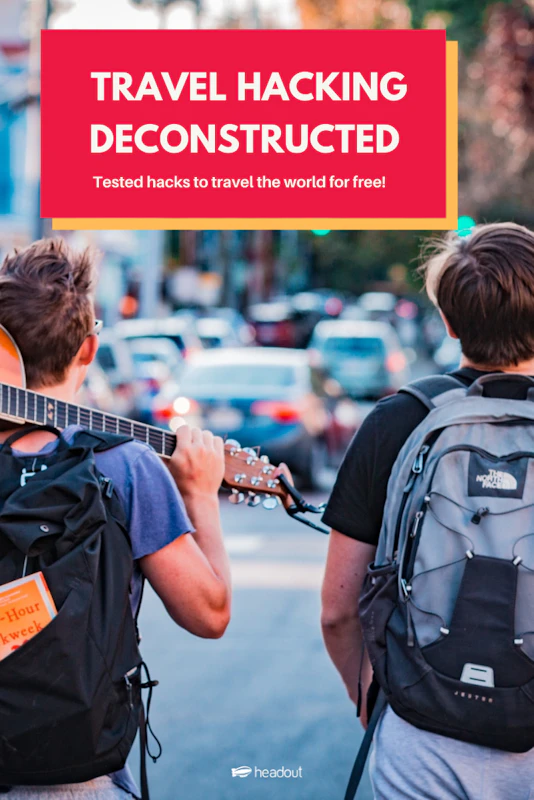
Lakshmi Menon
Born to parents bit by the wander bug, Lakshmi calls her love for travel "hereditary and habitual". Perpetually ensconced with a book in her hand and a mug of coffee in the other, she has been to over 15 countries in her 23 years of existence and is currently saving miles and money for her solo trip to Iceland. Always hustling towards the least trodden path, she has encountered some wonderful people during her escapades and if you ever meet her, she won't stop gushing about them.
Be a smart traveler
The first to know about trending destinations, travel deals, tips and all things travel.


Travel Hacking: Using Points to Pay Your Way Around the World
Keen to travel but can’t quite afford the flight? Don’t stress, we’ve got you covered. Here’s our top guide on how to travel using points!
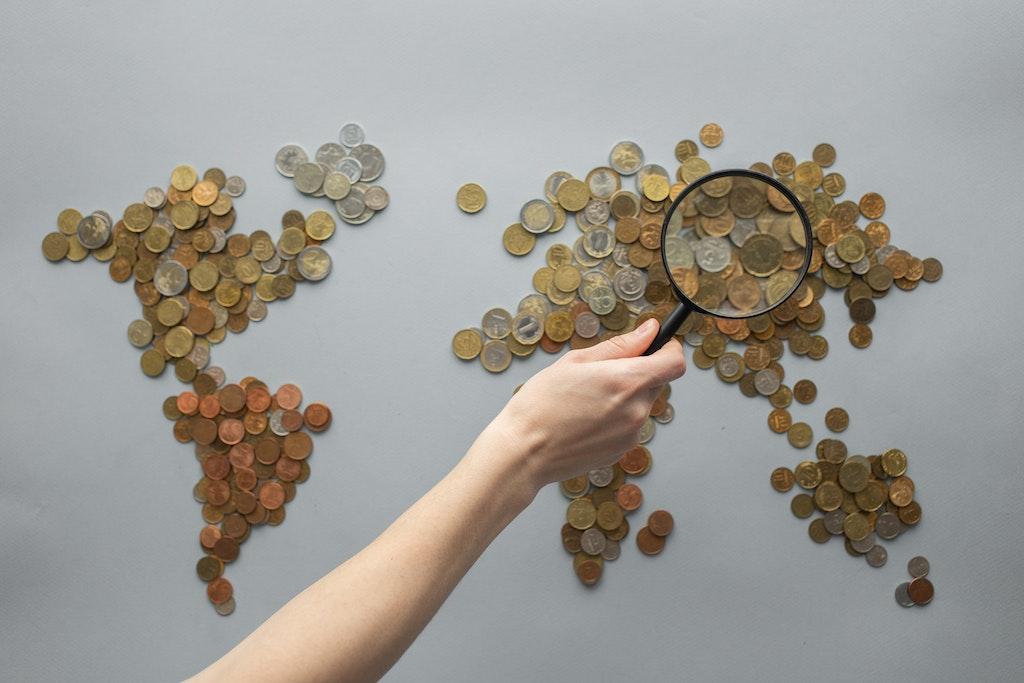
Have you ever wondered how friends and family who make less money than you take that expensive trip to Europe every year, or how these people on Instagram seem to travel continuously? They must be independently wealthy or going into massive debt, right? Perhaps, or maybe they have learned to travel hack and are leveraging the power of points and rewards programs to travel for next to nothing! Using travel credit cards, hotel rewards programs, and airline miles to your benefit’s the key to traveling the world on a budget, and we’re going to prove it. Get your coffee and turn your math brain on, it’s time to start saving! Here’s your know-all guide on how to travel using points!
Warning: Travel hacking is a gateway drug to a full-blown travel addiction. We will teach you how to use points to score excellent trips, but we will not explain to your mom why you’re disappearing for three months again. That’s on you!
Ready to plan your next escape ?
Who knows where the wind will take you, right? The world is full of incredible places screaming out to be enjoyed and admired. Wherever you choose to wander, be sure to take the Let’s Roam app along for the ride. We offer a wonderful mix of exciting activities in hundreds of cities all over the world. Perhaps a relaxing art walk down the cobbled streets of Europe? How about a romantic date night with a difference in South America? Book your ticket and get roaming!
Travel Hacking
Hi! I’m Abby. Together, with my handsome hubby, I have been using travel hacking schemes for more than a decade to land thousands of dollars worth of travel rewards, from free nights in luxury hotels to (almost) free flights, and even free trips, without buying points or signing up for any kind of expensive travel clubs or agents. I can vouch that travel hacking is real. It’s legal too (despite the criminal-sounding name), but it’s not always easy.
The rabbit hole can get deep and complex, especially when you have been doing it for a while and are addicted to finding the absolute best use of your points. For those of you who just want to take a reduced yearly vacation, and are not into spending your whole life calculating, we will give you some easy tips for getting your family vacation paid for too. Some travel hacking articles are really books, and while they are full of fabulous information, they can get overwhelming to read, so we are going to keep this short and sweet!
Travel Credit Cards
I was recently talking to a friend who said, “I want to travel like you, but every article I read about getting free trips is just trying to get me to sign up for credit cards!” My response was… ”yes, girl because that’s how we do it!” Collecting travel credit card points is the easiest, most efficient, and biggest bang for your buck when in the land of points and miles, but old-school financial advice, that is still roaming around out there, has poisoned people’s minds to the benefit of a well-stocked credit card portfolio. Let’s take a good look at how this system works, dispel some of the myths, and introduce you to a few of your new best friends.
Basically, a travel credit card is a card that gives you points for every dollar that you spend on your normal stuff. You have to buy groceries anyway, so you might as well get some money back on them. Almost all of your monthly expenses can be paid on a credit card, except mortgages and loans. Instead of paying with debit, charge your gas, groceries, and miscellaneous purchases to a good travel card.
The credit card company will award you points based on your contract, and then you can turn around and “cash in” these points for hotels, flights, rideshares, etc. If you don’t plan to travel this year, most credit cards allow you to use your points to pay yourself back and just take money off your bill.
Tip: Some payment systems charge a fee for using a credit card, so you’ll need to do a quick calculation to see if the card points outweigh the fee or not.
This year on one of my cards, I earned 57,220 points, just from normal spending. When turned in for travel purposes, each point is worth 1.5 cents on this particular card. Therefore my points are worth $858 worth of travel! I earned a free roundtrip flight to almost anywhere in the world for doing nothing but normal shopping.
(57,220 points x 1.5 cents per point)=85,830 cents or $858
Three Kinds of Credit Card Points
Fixed rate points.
Fixed-rate points are popular on cards the Capital One Venture Card, one of the best cards for beginners. Every purchase earns you a set amount of points, usually one or two, depending on which card you have. These can be used for travel purchases through their online portals or to pay yourself with a statement credit.
Transferrable Points
Transferrable points are the bread and butter of travel hacking, or so some hackers say. These points are collected as a reward for spending, just like fixed-rate points, but when it comes time to cash them in, you have more options. They can be transferred to your credit card partners like major hotel chains and airlines. I find that they aren’t always worth transferring. It all depends on which credit card you’re using and what transfer partners are offering. This process can be complicated and time-consuming, as you have to do a lot of calculations to make sure that you’re getting the best deal by transferring your points.
Let’s say you have the Chase Sapphire Reserve Card, and you’re looking to book a flight from Atlanta, Georgia to Paris, France on the dates of March 1-10, 2023. Along with several other airlines, Chase has a partnership with Star Alliance, which includes United Airlines, Lufthansa, and Turkish Airlines, along with many other smaller airlines. You have two options:
Option 1: Book the flight through Chase Ultimate Rewards Travel Portal .
The flight costs $749, or 50,733 points (1.5 cents per point). You’ll also earn 5 points for every dollar your spend (even when you pay in points), earning you 3,805 new points, somewhere between $38 and $50 of value.
Option 2: Transfer points to United MileagePlus .
You have several options of airlines to choose from with the Chase program, but let’s use United as an example.
The same flight cost the same $749 on United’s website, or 60,000 miles + $85.28 in fees that aren’t covered by points. Chase Ultimate Rewards Points transfer one-to-one with all partners. So you would transfer 60,000 points from Chase to United, which is super easy through your Chase account. To find out if it’s worth it, you must find the value of your transferred points. You must subtract the fees from the total price of the flight because you aren’t getting any value for your points on those. You just have to pay them. Let’s do the math!
$749-$85.28=$663.72
$663.72÷60,000= 1.1 cents per point
So, your points are worth 1.1 cents when transferring to United for this flight (no, it’s not the same for every flight). This would be a case where it’s not a good idea to transfer points. Your points are worth more staying with Chase, where they are valued at 1.5 cents each. This isn’t always the case. There are cases where transferring works out to your benefit, especially when booking a last-minute flight. Let’s say you need to fly the same flight pattern tomorrow:
Option 1: Book Through Chase .
Through the Chase portal, the price now jumps up to $1949, or 129,933 Chase Points.
Option 2: Transfer Points to United MileagePlus .
The flight is $1954 through United’s portal, but due to the nature of airline points, it still only costs 66,000 United points, with $116.98 worth of fees.
$1954-$116.98=$1837.02
$1837.02 ÷ 66,000=2.8 cents per point
So, as you can see, you could score the same last-minute flight for 66,000 Chase points by transferring them, where it would cost you almost 130,000 points to book through Chase.
Additional Considerations
When it comes to transferring points, there’s a lot to think about. For instance, if you transfer your Chase Ultimate Reward Points to United, you lose all the other benefits of booking on your travel credit card, like trip insurance and lost luggage benefits. Plus you don’t earn any new points on the purchase. See… your fifth-grade teacher told you math was important!
Sign Up Bonuses
Welcome bonuses on new credit cards are the fastest way to gain free travel. When signing up for a new card, you’ll be given a certain allotment of time to spend a set amount. Once you hit the amount, you’re rewarded with a large sum of points.
For instance, right now Citi Premier Card is offering 80,000 City ThankYou Points for spending 4,000 in the first three months. That’s $800 in gift cards through the Citi ThankYou portal, but you could earn up to $1400 by transferring them to their extensive list of travel partners.
As you can see, travel sign-on bonuses can easily pay for your vacation flights each year. That is why travel hackers have so many credit cards.
Warning: Most banking systems do not allow you to benefit from welcome bonuses on the same card twice in a set period, usually 18-24 months. Amex only lets you receive one bonus per lifetime for each card. You can cancel a credit card and reapply in a couple of years though, so it’s important to keep track of what cards you have and when you canceled them.
More Perks Than Points
A good travel credit card offers so many more benefits than just points. For instance, Chase cards offer a credit to pay for your Global Entry Status. Get your TSA precheck, and expedite your travel time so that you have more time to spend in the fancy airport lounge that your Chase card also gives you free entrance to! Free food and drinks in the lounge save us hundreds of dollars annually. Chase also gives you discounts on several major car rental companies, trip cancellation insurance, and travel health coverage for major incidents. Then, there’s roadside assistance, discounted shopping portals, baggage delay reimbursement, emergency evacuation, and so much more!
Credit Card Myths
I know some of you subscribe to the Dave Ramsey finance plan, and others like it, and the concept of credit cards strikes fear in your soul. I get it, but it’s not the credit card that is scary, it’s the misuse of the credit card! Let’s dispel a few myths.
Myth: Credit Cards Hurt Credit Score s
Let’s get personal for a second. I already told you I have been doing this for years. I just signed up for a new credit card 10 days ago, so my credit score is in the temporary dip that happens after a hard inquiry. Today, my Transunion and Equifax scores are 831 and 833, which is excellent.
While hard inquiries (like applying for a credit card) do make your credit take a momentary dip, it’s usually a matter of a few points, and doesn’t affect you very much because credit inquiries are only 10% of your overall score! This is peanuts compared to the other categories. For instance, 35% of your credit score is determined by your payment history, and 30% is your credit utilization.
Payment history
This is probably pretty obvious to you. The fastest way to kill your credit score is not to pay your bills on time, so set reminders! Put Post-its on your fridge, or tattoo it on your forehead, what you have to do, don’t be late on your payments.
Credit utilization
This one is a bit more involved, but basically, it means how much of your available credit line are you currently using. The lower the percentage, the better. That means that if you have 10 open credit cards with a $15,000 limit on each one, you have a credit line of $150,000. Let’s say that between your ten cards, you only have $2,000 charged at any one point in time. That means your credit utilization score is 1.3 %, which is phenomenal. According to Credit Sesame, you want your Credit usage score to remain below 10%.
Credit History Length
Fifteen percent of your credit score comes from your average credit history length. The longer it’s, the better. This is why you typically don’t want to cancel credit cards, even if you don’t use them anymore, unless you’re paying a yearly fee (more on that later.) Having older cards pads your history and increases your credit line, but at 15% of the pie, canceling won’t necessarily kill your credit either.
Math geniuses, the remaining 10% we haven’t accounted for comes from your credit mix, which means how many different kinds of credit you have. For instance, having a car loan, home loan, and a few credit cards that are all paid for on time gives you a better rating than just credit card lines, but again, this is a measly portion of the pie.
Myth: Overly Complicated Credit Card Points
It’s true, some credit cards make it way more complicated than others, but it doesn’t have to be a brain-wrecker. For instance, Capital One Venture offers 2 points for every dollar spent, and the points have a fixed value of $0.01 each. You can pay yourself back on purchases or book travel with points through their system. It’s easy peasy.
The Chase Sapphire Preferred Card is a bit more complicated, but still very manageable. It’s one point on most purchases, but you get three points for travel-related purchases, five points for flights, and 10 points for dining purchased through their dining rewards program. Chase’s points are also what are known as transferrable points, which as stated, are gold!
Pro Tip: Make a quick spreadsheet for your credit cards and their most valuable points categories. This way, you can maximize your points earnings by choosing the correct card at the gas station, grocery store, or rental car agency.
In short, there are plenty of great travel rewards cards out there that have simple earning and cash-in systems that anyone can get benefit from!
Myth: Huge Credit Cards Fees
Credit cards only have high fees if you use them incorrectly. You should never pay a late fee or interest on a credit card. The key is to treat it like a checking account and not charge more than you can pay in a billing cycle. You don’t need to pay the current balance every month, but you must pay the “statement balance” in order not to get interest charges. Set an alarm to pay it a few days before the billing cycle ends.
Many of the best rewards cards do have a yearly fee, but the vast majority of them wave it for the first year. At the end of that year, you have a choice, you can pay the fee, cancel the card, or downgrade the card. For avid travelers, the rewards often outweigh the fee, but most credit card issuers have a free version. For instance, at the end of your year with the Chase Sapphire Preferred Card, you can call and downgrade it to the Chase Freedom Unlimited, which doesn’t have a yearly fee.
I recommend paying the yearly fee on one or two good travel cards, and downgrading the rest to the free version after your free year. I also keep one very old credit card, the first one I ever owned. This keeps my average credit years high while allowing me to cancel cards that I know I will want to reapply for after 18-24 months.
The Best Travel Rewards Credit Cards
Chase sapphire reserve card–avid travelers.
This card is for those who travel frequently and want all the best perks. It has a $550 yearly fee, but you receive a $300 travel credit annually, 60,000 bonus points, free global entry, a free airport lounge pass with unlimited visits for you and your travel companions, and a million other benefits from discounted rental cars to free hotel stays. The points are easily redeemed for cash back, through the rewards portal, or transferred to frequent flyer partners.
American Express Platinum Card – Avid Travelers
Another big spender card, the American Express Platinum has a $695 yearly fee, but you receive 100,000 American Express Membership Rewards Points and $200 in airfare, $200 in hotel credits, and $240 in digital entertainment credits. Without even going into the rest of the rewards, you have already made it worthwhile. This is an excellent travel card and a staple for most avid travelers.
Capital One Venture Card – New Hackers
We have already touted the ease of use of earning points with the Capital One Venture Card . It has no foreign transaction fees and no difficult redemption policies. With 75,000 introductory points and a yearly fee of just $95, it’s a great option!
Chase Sapphire Preferred Card – New Hackers
This card is very comparable to the last, except that it offers you Chase’s awesome transferrable points! The welcome bonus right now is 60,000 points, and it has a $95 yearly fee.
Chase Freedom Unlimited – No Fees
With no annual fee, this card offers 1.5-6.5% cashback for every purchase, and it gives you access to Chase’s travel portal, where you’ll earn 5% cash back on every booking.
Airline and Hotel Credit Cards
Airline credit cards and hotel cards are incredibly plentiful and most are a personal choice. They will never replace the benefits of one of the great travel cards above, but they are nice additions. If you enjoy flying a certain airline, like Delta per se, then sign up for the Delta Skymiles Gold Card. Hilton offers the Hilton Honors American Express Surpass Card. My strategy for these cards is to pick a couple. You don’t want a bunch of points spread out across multiple accounts and not enough to use anywhere.
Pro Tip: I often sign up for these cards when I have a specific trip in mind. For instance, I want to take my mom to London next year. The cheapest flight I found was on American Airlines, and the hotel I want to stay at belongs to the Marriott chain. As soon as I have my trip wish list, I would sign up for Citi AAdvantage Platinum Select Mastercard , giving me 50,000 bonus points, free checked bags for both of us, and priority boarding with American Airlines. I would also score the Marriott Bonvoy Boundless Card from Chase , getting me 100,000 points and immediate Elite status with Marriott.
Airline Loyalty Programs
Okay, we could talk about credit cards for another 5 pages, but let’s move on. Airline loyalty programs are your next category. While nowhere near as lucrative as credit card points, airline miles are super easy to obtain and free. Loyalty programs like Delta Skymiles, Southwest Rapid Rewards, and British Airways Avios points are all free to sign up for. You just enter your loyalty number when you book a flight, and voila, you gain points for that flight.
If you fly a specific airline enough, you can elite status on that airline, which gives you priority boarding and first dibs on upgrades to business class or first class when available. Elite status is hard to earn unless you fly frequently. In most frequent flyer programs you must meet two criteria, spending a certain amount of dollars and flying a certain amount of miles, varying for each company. The fastest way to get elite status is to fly solely on one airline and get the accompanying airline credit card. Once you hit elite status for the year, you’ll enjoy the benefits for the rest of the year and the following full next year. You can also use your elite status points on partner airlines.
You can also purchase airline miles, which is usually a big “NO!” However, some companies offer major promotional offers each year, so make sure you sign up for notifications through your loyalty programs.
Airline Alliances
Most major airlines belong to an alliance. The three major ones are Star Alliance, SkyTeam, and OneWorld Alliance. Star Alliance is United, Lufthansa, Turkish Airlines, and Air Canada, among many more. SkyTeam includes Delta, Air France, KLM, and several regional airlines. OneWorld Alliance is primarily American Airlines, British Airways, and Qatar Airways.
While frequent flyer miles are not usually directly transferrable between companies, you can book a flight on British Airways, through the American Airlines portal, and use your AAdvantage miles to pay for the flight.
Shopping Portals
Another way to earn frequent flyer miles is to download the Google Chrome Extensions for major airlines. These apps will run in the background on your computer, and any time you click on a website for a merchant partner of one of the airlines, you’ll receive a notification. Click the notification and make your purchase through the airline portal instead of directly through the merchant website, and you’ll get airline miles.
For instance, did you know that Delta Airlines and Airbnb are partners? Instead of going directly to Airbnb, you’ll be prompted to transit there through Delta, and you’ll earn SkyMiles for your Airbnb purchase! You can also link your Delta account to your Starbucks account and Instacart, so that every time you buy coffee or groceries, you get points. American Airlines has a partnership with Hyatt hotels. By linking those two awards accounts, you can earn points from both places on purchases at either.
Hotel Loyalty Programs
Like airline miles, most major hotel chains have loyalty programs where you can stock up points, eventually earning free nights. Hyatt, Hilton, IHG, and many more all have similar systems. Hotel points are not nearly as valuable as credit card points, or even frequent flyer miles. Unless you’re married to a specific hotel chain, I don’t find them to be that useful.
However, if you’re a traveler that just loves the Hilton, then these can be very beneficial. You can earn Hilton points by linking your Hilton Honors account with Lyft. Marriott points can be easily earned with your Uber and Uber Eats orders. Hotel points can often be transferred to airlines as well, but usually at a suboptimal rate. Again, I find these most effective when utilizing a hotel credit card and booking specific trips where I can take advantage of the free nights in the introductory offer.
Other Tips and Tricks
Loyalty is key.
While you always want to search around for the best deal, maintaining loyalty can ac more effective. For instance, when looking for a hotel stay, a good travel hacker will pull up Agoda, Airbnb, Booking.com, and any hotel chains they have points with, and does a comparison. However, if the difference between sights is minimal, then stick to the booking platform that you have the most credit with. For instance, if you book routinely through Booking, you earn their Genius Level 3 status, which gets you 10-20% discounts on most stays, free breakfast additions, free room upgrades, and random travel rewards. Just yesterday, I received an extra 15% certificate for any accommodation booked in the next 6 weeks.
Raise Gift Cards
Raise is a website for buying gift cards at a discounted rate. They often have gift cards for Airbnb, Hotels.com, and major airlines. I recently purchases a $500 Airbnb card for $460, and I earned $14 cash towards my next Raise purchase. Not bad for one extra step!
Founders Card
Founders Card is a travel community with some incredible perks. It has a high fee that I would never pay, mostly because the benefits are for luxury travel, which isn’t my area of expertise. However, they offer a free one-year membership which gives you access to most of their perks like complimentary Hilton Honors Gold Status, 40% off of Seabourne cruises, and %25 off airport lounge bookings.
Travel Newsletters
Sign up for as many free travel newsletters as you can! Scotts Cheap Flights, LonelyPlanet, and Cheap Flights all have great newsletters. They highlight deals from mistake flights to new credit card offers, and they can alert you to big savings!
Wrapping It Up
Travel hacking is a big topic guys, but we hope you found some value in this attempt to slim it down to the basics. The truth is, getting the absolute best deal takes some strategy. You’ll eventually get sucked in and learn all kinds of tips of your own, but in the beginning, keep it simple. To get started:
- Grab yourself one of the recommended travel credit cards and fulfill the terms to get the sign-on bonus. Pay attention to websites like The Points Guy and Nerdwallet for the best current recommendations.
- Sign up for all major airline loyalty programs and download the browser extensions.
- Do the same for major hotel brands.
- Sign up for travel newsletters and monitor your email.
Still have questions? Drop them in the comments!
Looking to travel more? Check out “21 Clever and Creative Ways to Save Money for Travel.”
Hostels are some of the cheapest accommodations around, but are they for you? Find out in “Staying in a Hostel: The Good, the Bad, and the Ugly.”
Frequently Asked Questions
Travel hackers use points and mile s to travel the world for free. This includes utilizing credit card welcome bonuses, airline frequent flyer miles, and hotel loyalty programs.
Travel credit cards come with immense perks like free hotel stays, airport lounge passes, and welcome bonuses worth hundreds.
Score a discount gift card for Airbnb on Raise, and include plenty of cheap activities like picnics in famous places, museum-free days, and app-guided scavenger hunts!
Featured Products & Activities

From Frugal to Free
15 Clever Hacks to Travel the World on a Shoestring Budget
Posted: December 22, 2023 | Last updated: April 7, 2024
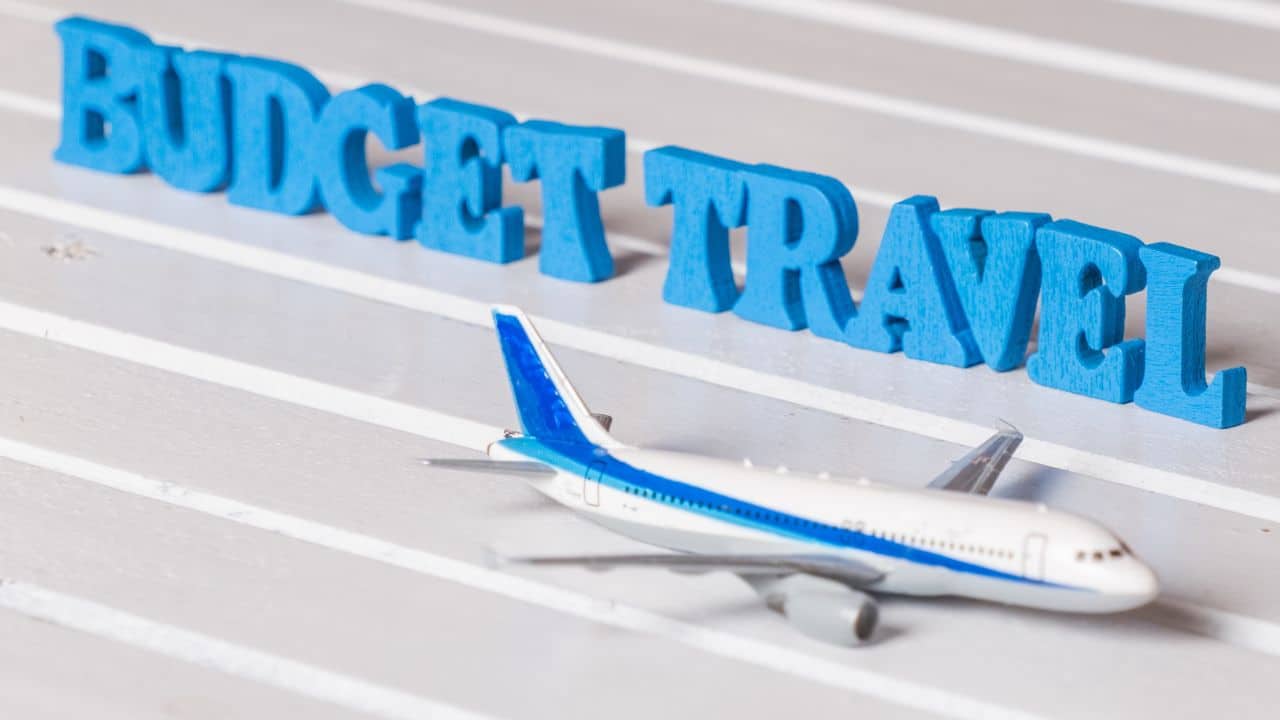
Traveling the world is a dream many of us cherish. But the pervasive myth that globetrotting is only for the wealthy often holds people back. The truth is, with some smart planning and a few clever hacks, exploring the globe on a shoestring budget is entirely possible.
Let’s look at 15 strategies for budget-conscious explorers who yearn to satisfy their wanderlust, have fun, and make lasting memories without breaking the bank. Use these tips to make sure your adventures are both economical and extraordinary.

1. Embrace Off-Season Travel
Traveling during the off-season can significantly reduce costs. Airfare and accommodation prices drop in less popular months, offering the same experiences at a fraction of the cost. Plus, you’ll enjoy destinations without the crowds. Research the best off-season times for your desired destinations and plan accordingly.

2. Opt for Budget Accommodations
Instead of pricey hotels, consider hostels, budget guesthouses, or renting a room through platforms like Airbnb. These options not only save money but also offer a more authentic experience of local life. Many hostels also provide free amenities like Wi-Fi and breakfast, adding value to your stay.

3. Use Public Transportation
Public transportation is not only cheaper than taxis or car rentals, but it also offers a slice of everyday local life. Buses, trains, and metros are cost-effective ways to explore a city. For longer distances, overnight buses or trains can save a day’s accommodation cost.

4. Cook Your Own Meals
Eating out can quickly drain your budget. Opt for accommodations with kitchen facilities and cook your own meals. Shop at local markets for fresh and affordable ingredients. This not only saves money but also lets you explore local cuisines and cooking methods.

5. Travel Light
Avoid extra baggage fees by traveling light. Stick to carry-on luggage if possible. This not only saves money but also makes moving around easier and faster. Plus, it’s a great way to learn the art of packing efficiently.

6. Look for Free Activities
Many destinations offer plenty of free activities. Explore public parks, free museums, historic sites, and local markets. Do some research before your trip to find out about free walking tours, outdoor concerts, or cultural events happening in the area.

7. Use Travel Apps and Websites
Leverage technology to find the best deals. Use travel apps and websites for cheap flights, accommodations, and local experiences. Platforms like Skyscanner, Hostelworld, and Couchsurfing can be invaluable tools for budget travelers.
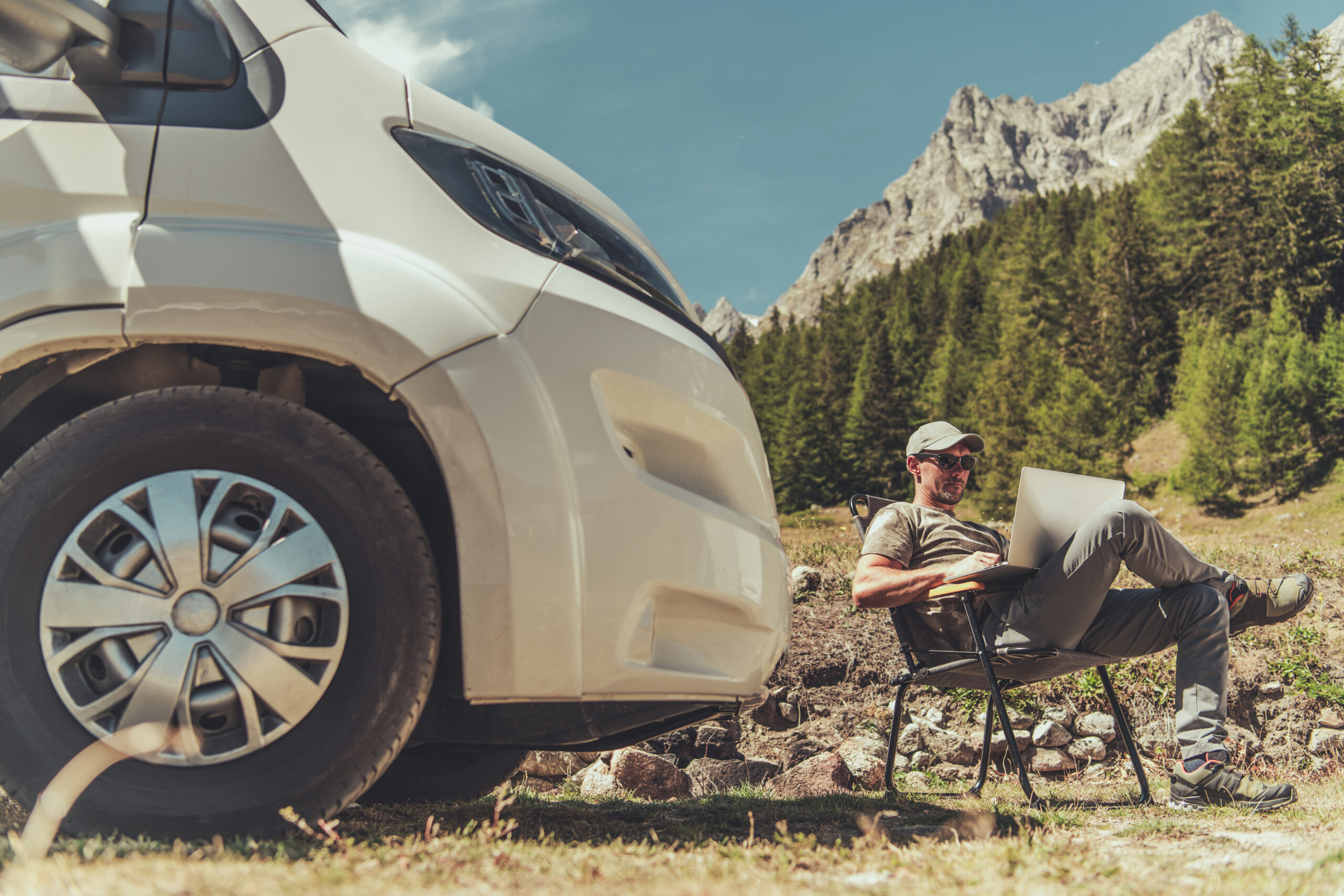
8. Earn While You Travel
Consider opportunities to work or volunteer abroad. This can offset travel costs and extend your trip. Teaching English, working in hostels, or WWOOFing (World Wide Opportunities on Organic Farms) are popular options that also offer immersive cultural experiences.

9. Travel Slowly
Spending more time in fewer places can save money. Slow travel allows you to discover hidden gems and enjoy experiences that you might miss if you’re constantly on the move. It also reduces transportation costs and offers opportunities for discounts on longer stays.

10. Use Local Currency
Avoid extra fees by paying in local currency. Using your credit card abroad can incur additional charges, and currency exchange booths often have unfavorable rates. Withdraw cash from ATMs and be mindful of transaction fees.
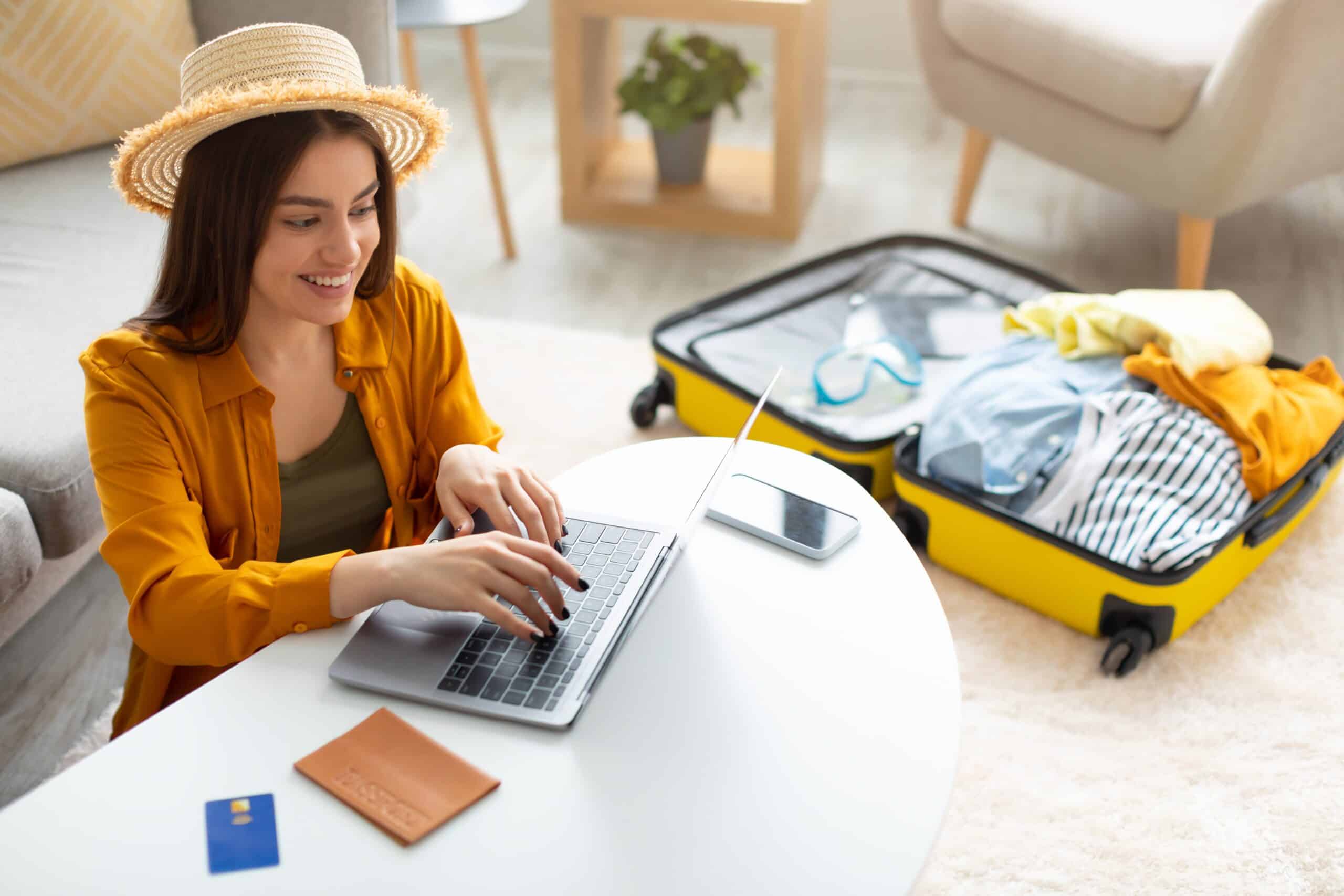
11. Be Flexible with Your Plans
Flexibility can lead to significant savings. Be open to last-minute deals and flexible with your travel dates and destinations. Sometimes, a change in plans can lead to unexpected adventures and even better deals.

12. Join Loyalty Programs
Sign up for airline and hotel loyalty programs. Accumulating points can lead to free flights, upgrades, and stays. Even if you don’t travel frequently, these points can add up over time and lead to substantial savings.

13. Pack a Reusable Water Bottle
Carrying a reusable water bottle saves money and reduces plastic waste. In countries with safe drinking water, refill your bottle at public water fountains or taps. In other places, consider a bottle with a built-in filter.

14. Avoid Tourist Traps
Stay away from touristy areas where prices are often inflated. Instead, explore local neighborhoods and eateries. Not only is this cheaper, but it also offers a more authentic experience of the destination’s culture and lifestyle.
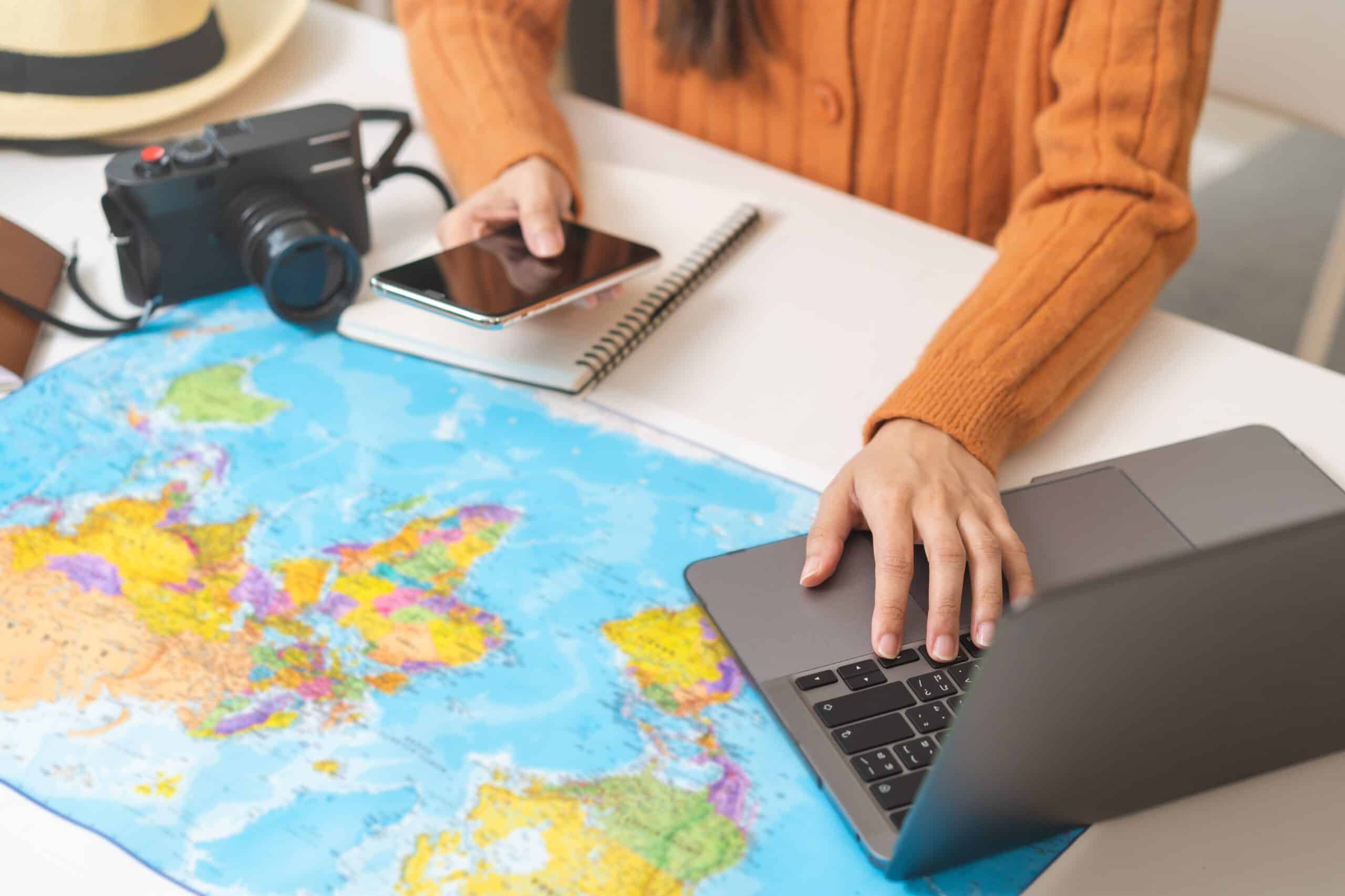
15. Plan and Research Thoroughly
Good planning is key to budget travel. Research your destination thoroughly to find the best deals and hidden gems. Read travel blogs, join online forums, and connect with other travelers to gather valuable insights and tips.
More for You
Trump Suing N.Y. Judge Just One Week Before Hush Money Trial, Report Says
9-1-1 actor condemns homophobic backlash to character’s gay kiss
Say Goodbye To Popcorn Ceilings Without Removing Them Thanks To This DIY
18 Old-School Dinners That We Want to Bring Back
The Best Place To Store Your Canned Tuna Isn't In The Pantry
Gladiator 2's Official Logo Revealed
Paramount Wins ‘Top Gun' Copyright Lawsuit
New York Yankees' Rules Appear to Be Getting to Alex Verdugo
Container ship loses propulsion and comes to halt close to New York bridge – two weeks after Baltimore tragedy
Why Don't Trucks Have Dual Gas Tanks Anymore?
This Healthy Substitute For Breadcrumbs Is Unexpectedly Tasty
Pink Mold in Your Shower? What It Is and How to Get Rid of It
Here’s How Long You Should Walk Every Day to Keep Your Heart Healthy
NATO helicopters are shooting down and eliminating enemy drones in a rarer kind of Red Sea battle
8 Places You Should Never Charge Your Phone
This Mads Mikkelsen Movie Is One of the Best Modern Westerns
Maps show where trillions of cicadas will emerge in the U.S. this spring
The Common Household Ingredient That Can Unclog Slow-Draining Sinks And Tubs
Kari Lake Dealt Supreme Court Blow
The Best And Worst Breakfast Biscuits From 8 Fast Food Chains

Travel Hacks

7 travel safety hacks to make your adventure a little less stressful
I have been travelling solo for the past 7 years all over the world from the Philippines to Mexico and everywhere in between. During this … Read more
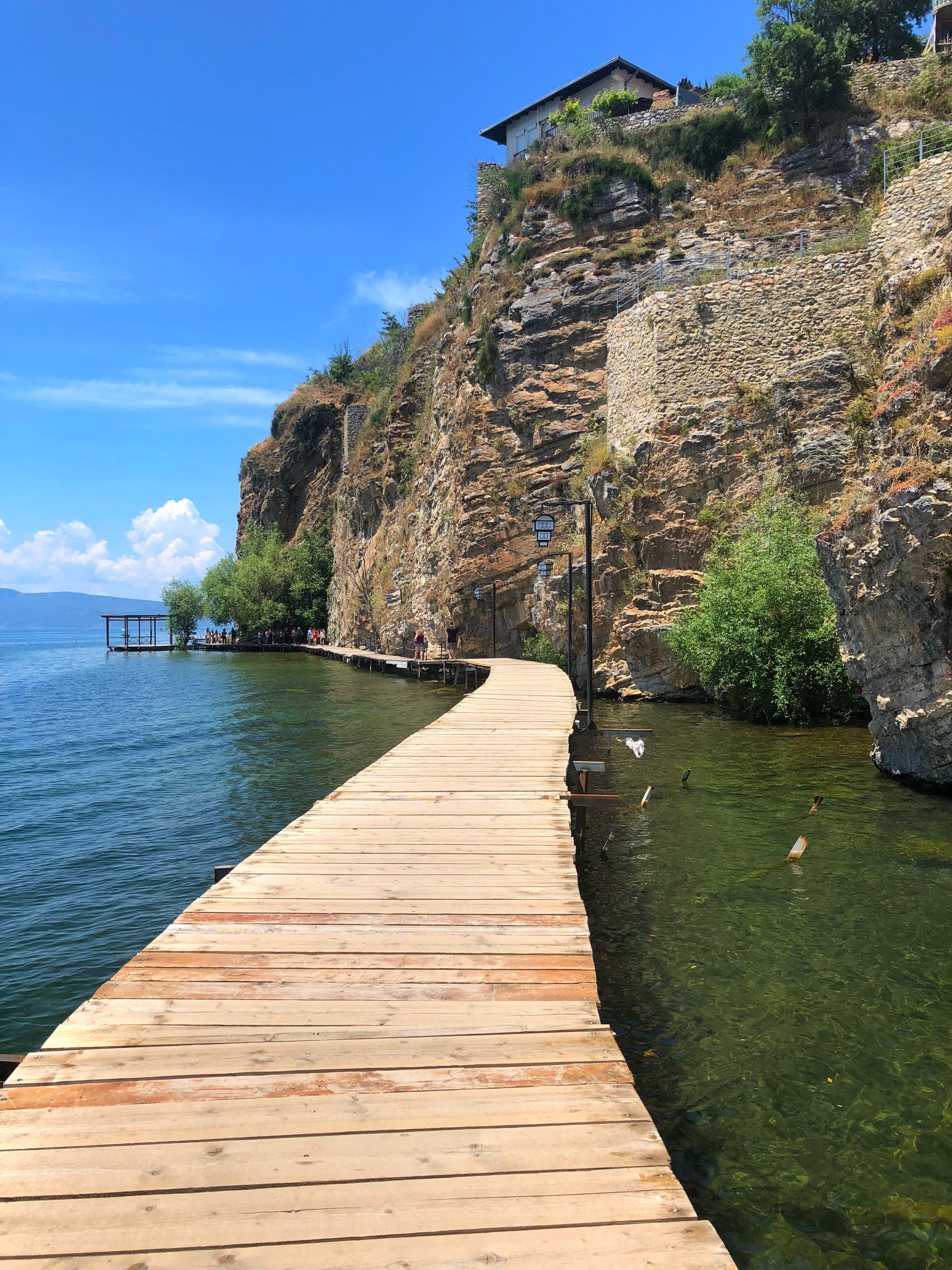
8 Lessons I Learnt From 11 Weeks Of Solo Travelling.
I was unsure of where I was headed, still am unsure, but I embraced a path like this in Ohrid, Madedonia and shed all my … Read more
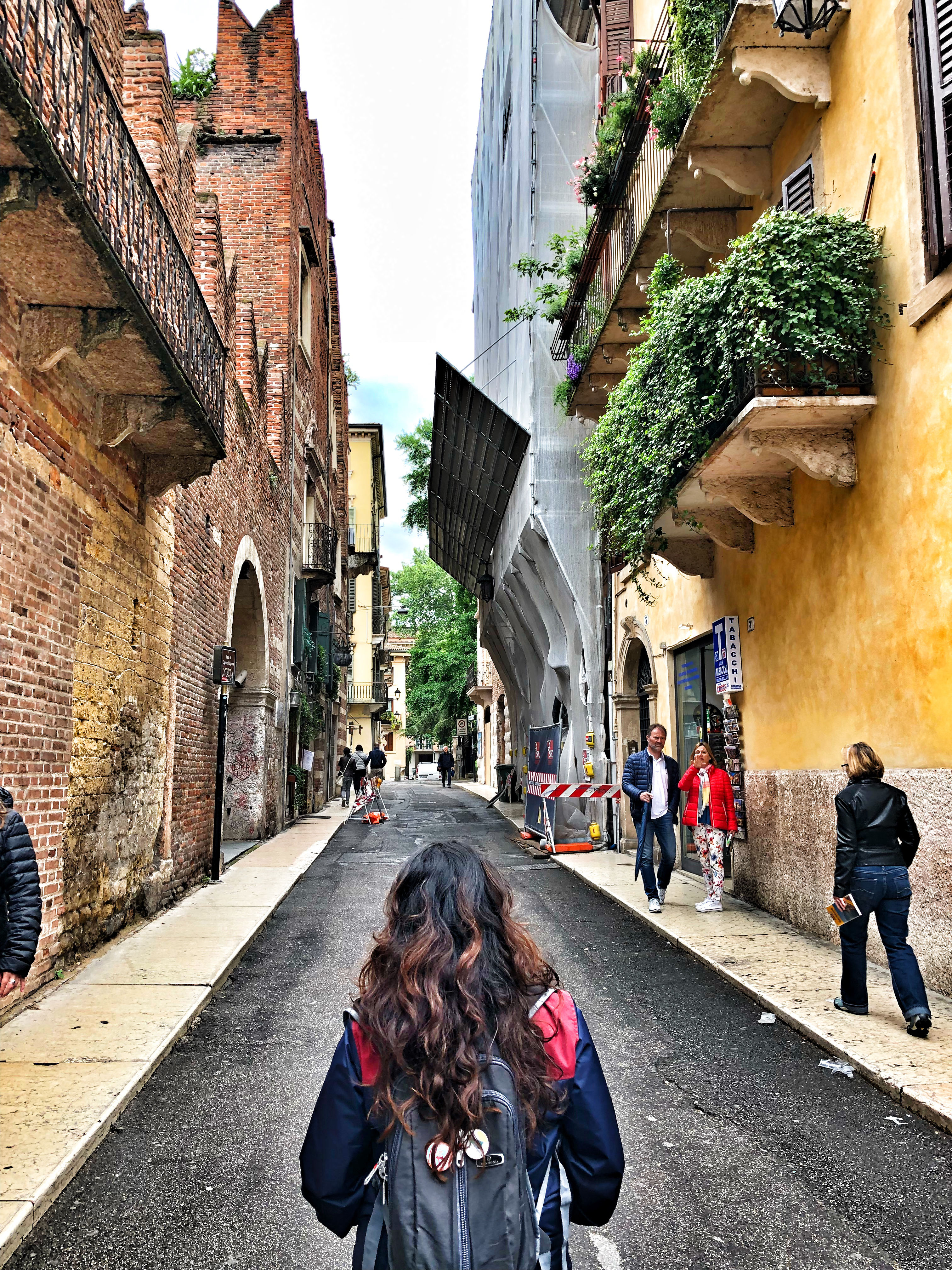
How to be a Budget Traveller (Part 1) : 9 tips on saving money while travelling the world.
So one thing that I am asked consistently is whether I am super rich since I have managed to travel to so many countries. Well, … Read more
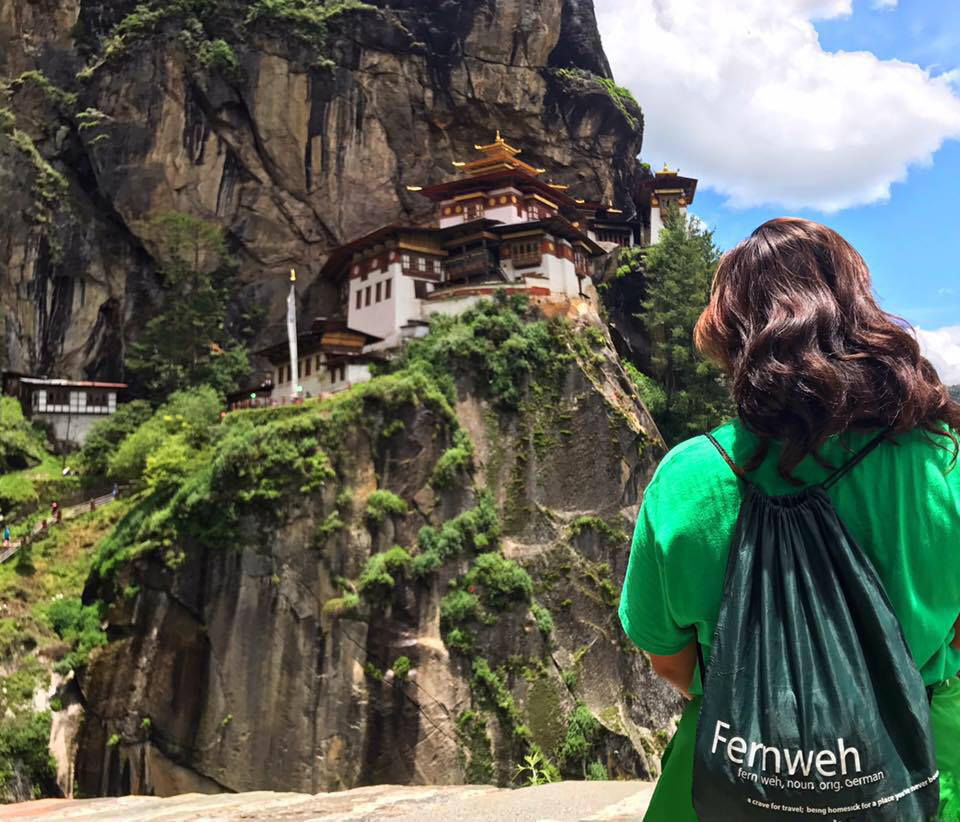
8 Visa Hacks For Third World Travellers.
As i write this post, i am sitting in a cafe in Genova, Italy, feeling absolute exhausted having been subjected to some passport related harassment … Read more
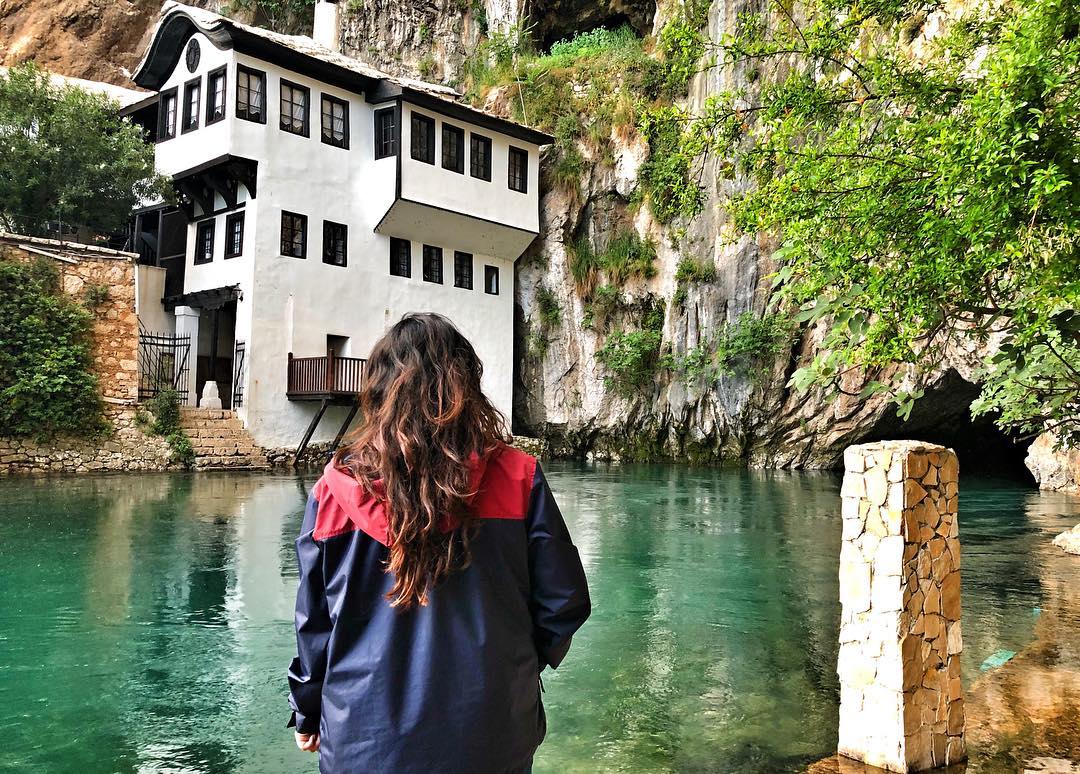
Travelling while female: 8 travel hacks I live by.
I have been meaning to write a more detailed post about travelling while female, but I honestly believe, my experiences are coloured by my race, … Read more

7 tips on travelling while being a young, semi broke, 3rd world citizen.
Ok, before I start this post, I want to make something extremely clear: travelling is a privilege that not many can afford. As I write … Read more

Solo Travel Photography: 5 Tips on Photographing While Travelling Alone.
Something I have been asked a lot recently is how I get these seemingly difficult shots while travelling alone. I am asked who is taking … Read more
- Search Please fill out this field.
- Manage Your Subscription
- Give a Gift Subscription
- Sweepstakes
This New Luxury Travel Company Features Carbon-neutral Trips to the Dolomites, Victoria Falls, Amazon, and More
The 30 itineraries — all tested by the founders — include adventures in the Seychelles, Rwanda, Dolomites, Yellowstone, and Slovenia.
:max_bytes(150000):strip_icc():format(webp)/rachel-chang-36aff37f3d95496b8a40a59781ef89c2.jpg)
Katie Katz/Courtesy of Few & Far
Brit Sarah Dusek and her American husband Jacob Dusek have always viewed the world through a lens of possibilities. The couple met in Taipei, Taiwan, nearly two decades ago and started out raising their two sons in Montana — all while they launched what has become one of the preeminent glamping companies in the country, Under Canvas . It disrupted the old standards of rustic camping and replaced it with chic, eco-friendly safari-style tents against the background of some of the most iconic U.S. destinations.
Now they’ve taken that same mindful model of meaningful outdoor experiences into the luxury travel space, debuting a new brand last month: Few & Far . It's a sustainable company dedicated to carbon-neutral exploration. “The heart of all of it is the magical connection there is when people connect with nature in extraordinary ways,” Sarah Dusek told Travel + Leisure.
Each of the 30 itineraries available on the site right now are ones that someone from the Dusek family has experienced first-hand, providing a personal level of curation and paired with a focus on putting sustainability first.
Among her favorite trips offered are the Rwanda Gorilla Trek and Masai Mara Wildlife Adventure , a 12-day itinerary with visits to Kigali and Volcanoes National Park in Rwanda, Masai Mara in Kenya, and Zanzibar in Tanzania. She took a group of female CEOs on the journey last October, saying that “it was absolutely mind-blowing and extraordinary” and that “every single woman on the trip said it was by far the most incredible trip she’s been on.”
Another highlight is the five-day San Juan Islands Tented Camp Experience , a tailored group trip with accommodations set up specifically for each group. On Sarah Dusek’s own visit, she took about eight female CEOs there for a “boutique, five-star tented experience under the stars on a farm,” where they arrived by seaplane and then sea kayaked, hiked, and enjoyed outdoor farm-to-table dinners. The best part: every person could rest assured that their stay used 70 percent less water consumption than staying at an average hotel.
Her own family traveled last Christmas inspired the Enchanting Southern Africa itinerary, a 12-day getaway from Cape Town up to Victoria Falls in Zimbabwe, before heading to a houseboat on the Chobe River in Botswana. “It was so special because you could be right on the water watching the wildlife morning, noon, and night,” she said. “The boys could fish and we could traverse up and down the Zambezi, experiencing a different view each day.”
After that, the trip boards the luxurious Rovos Rail through Hwange National Park in Bulawayo to Pretoria, before ending in Johannesburg.
Having test-driven every single one of the itineraries on her own is what makes Few & Far’s curation so special. “All of these are very personal to us,” Sarah Dusek said. “They're an expression of who we are — and we love to share them.”
Launching a new travel company was never the intention, with the Duseks selling off Under Canvas in 2019 and moving their family to Cape Town, where they worked as venture capitalists helping empower and fund female entrepreneurs. But they continued to be avid travelers, committed to exposing their sons, now 12 and 15, to as many cultures and perspectives as possible.
During a trip to the Forgotten Mountain’s remote region in northern South Africa’s Limpopo province along the Zimbabwe border, they knew they had stumbled upon something special in UNESCO’s Vhembe Biosphere Reserve . Soon, they had bought a 10,000-acre space, where they’re now set to debut as the 60-room Few & Far Luvhondo eco-lodge at the end of this year. Inspired by weaver bird nests, the site will include a solar-powered aerial experience with a cable car system featuring a 40-kilometer (about a 25-mile) track to provide a uniquely immersive way to explore the African bush and its wildlife.
“We hadn't planned on coming back to the commercial travel space again, but are still so passionate about travel and we still love curating extraordinary experiences,” Sarah Dusek said. “We kept thinking about the safari experience and how to reimagine it for our children and how we could incorporate conservation and travel.”
That forward-thinking eco-first philosophy is what drives all of the Duseks’ efforts. “Outdoor tourism can do so much good,” Sarah Dusek said. “There can be so much harmony with creating an economy, stimulating jobs, preserving wildlife, making sure that our habitats are protected, and that we don't lose biodiversity.”
In fact, through a combination of conservation efforts — largely from tree planting, as well as wetlands management, rewilding, and restoring — the eco-lodge should be on track to sequester as much as 100,000 more tons of carbon a year than it currently does. That’s especially meaningful since the 10,000 acres they own have more biodiversity than in all of Europe.
Additionally, she started looking at the possibilities of helping the rural people, many of whom live in poverty and are generating a revenue stream through tourism. “You start educating people about the difference of what happens when we conserve and protect the land and start investing in the people and then you start to ripple effects in so many levels," she said.
Ultimately, what drives Sarah Dusek is her own dedication to instilling these values in her kids. “I want to show my kids how extraordinary our planet is and I want them to fall in love with it,” she said. “When you're out in it, magic happens and the chances of falling in love with the planet are infinitely greater.”
All of those facets come together in each of the trips through Few & Far — and she hopes that every traveler will be taken by the impact of their adventures. “Travel changes us and has the power to change a belief pattern,” she said. “It shows us that the way we live is not the way everyone lives and maybe not the right way to live.”
In particular that happens the most when she’s out on the great outdoors. “The more time I have spent in the natural world, the more I learn about the people, behaviors, patterns, and cultures in our world,” she said. “That makes us richer and gives us all a chance to realize gosh, all the little things matter.”
For a full list of Few & Far’s trips, which range from $10,000 to $50,000 per trip, visit Few and Far's site .
Travel | The most spectacular new hotels in California,…
Share this:.
- Click to share on Facebook (Opens in new window)
- Click to share on Twitter (Opens in new window)
- Click to print (Opens in new window)
- Click to email a link to a friend (Opens in new window)
- Click to share on Reddit (Opens in new window)
Today's e-Edition
Things To Do
- Food & Drink
- Celebrities
- Pets & Animals
- Event Calendar
Breaking News
Travel | major-injury collision closes south san jose intersection near highway 101, subscriber only, travel | the most spectacular new hotels in california, hawaii and around the world, afar magazine’s list of top new hotels spans the globe, from the kalahari desert to santa barbara wine country.

San Francisco-based Afar magazine has just released its list of the 31 best new hotels around the world. It’s a rundown certain to inspire wanderlust, even if you weren’t planning to visit, say, Winston Churchill’s London digs or the highlands of Iceland anytime soon.
But if you were, Afar’s editors suggest Iceland’s Highland Base Kerlingarfjöll. The sleek Nordic retreat about three hours from Reykjavík is run by the same team behind the Retreat at Blue Lagoon. And the new Raffles London at the OWO nestles 120 guest rooms and suites inside the historic Edwardian building that once served as Winston Churchill’s Old War Office — that’s the OWO reference.
California gets a nod for The Inn at Mattei’s Tavern in Los Olivos, a 19th-century stagecoach stop and tavern that is now a luxurious 67-room Auberge Resort in the heart of Santa Barbara wine country.
And if you’re planning a Hawaii getaway, Afar’s list includes the post-tsunami reimagining of Kona Village, now a Rosewood Resort on the Kohala Coast of the Big Island of Hawai‘i with individual thatched-roof hales, a cultural center, swimming pools and four restaurants and bars spread across 81 acres of dramatic, volcanic landscape.

Here’s a peek at the North American hotels and resorts on the list. Find all 31, along with details and photos at www.afar.com and on newstands April 23.
Best New North American Hotels
The Inn at Mattei’s Tavern, Los Olivos
Kona Village, a Rosewood Resort, Island of Hawai‘i
Ambiente Sedona, Sedona, Arizona
ULUM Moab, Moab, Utah
Four Seasons Resort Tamarindo, Jalisco, Mexico
Maroma, a Belmond Hotel, Riviera Maya, Mexico
- Report an error
- Policies and Standards
More in Travel

Travel | 8 North Coast adventures from California’s Redwood Coast to Southern Oregon

Travel | Weekend getaway: California’s northern coast offers redwoods, rugged coastlines and more

Travel | Wish You Were Here: Northern Lights and glacier hopping in Alaska

Travel | Travel Troubleshooter: Why won’t Airbnb cover my hotel expenses? They promised!
- Mobile Site
- Staff Directory
- Advertise with Ars
Filter by topic
- Biz & IT
- Gaming & Culture
Front page layout
NIGHTMARE SUPPLY CHAIN ATTACK SCENARIO —
What we know about the xz utils backdoor that almost infected the world, malicious updates made to a ubiquitous tool were a few weeks away from going mainstream..
Dan Goodin - Apr 1, 2024 6:55 am UTC

On Friday, a lone Microsoft developer rocked the world when he revealed a backdoor had been intentionally planted in xz Utils, an open source data compression utility available on almost all installations of Linux and other Unix-like operating systems. The person or people behind this project likely spent years on it. They were likely very close to seeing the backdoor update merged into Debian and Red Hat, the two biggest distributions of Linux, when an eagle-eyed software developer spotted something fishy.
Further Reading
Researchers have spent the weekend gathering clues. Here's what we know so far.
What is xz Utils?
xz Utils is nearly ubiquitous in Linux. It provides lossless data compression on virtually all Unix-like operating systems, including Linux. xz Utils provides critical functions for compressing and decompressing data during all kinds of operations. xz Utils also supports the legacy .lzma format, making this component even more crucial.
What happened?
Andres Freund, a developer and engineer working on Microsoft’s PostgreSQL offerings, was recently troubleshooting performance problems a Debian system was experiencing with SSH, the most widely used protocol for remotely logging in to devices over the Internet. Specifically, SSH logins were consuming too many CPU cycles and were generating errors with valgrind , a utility for monitoring computer memory.
Through sheer luck and Freund’s careful eye, he eventually discovered the problems were the result of updates that had been made to xz Utils. On Friday, Freund took to the Open Source Security List to disclose the updates were the result of someone intentionally planting a backdoor in the compression software.
It's hard to overstate the complexity of the social engineering and the inner workings of the backdoor. Thomas Roccia, a researcher at Microsoft, published a graphic on Mastodon that helps visualize the sprawling extent of the nearly successful endeavor to spread a backdoor with a reach that would have dwarfed the SolarWinds event from 2020.

What does the backdoor do?
Malicious code added to xz Utils versions 5.6.0 and 5.6.1 modified the way the software functions. The backdoor manipulated sshd, the executable file used to make remote SSH connections. Anyone in possession of a predetermined encryption key could stash any code of their choice in an SSH login certificate, upload it, and execute it on the backdoored device. No one has actually seen code uploaded, so it's not known what code the attacker planned to run. In theory, the code could allow for just about anything, including stealing encryption keys or installing malware.
Wait, how can a compression utility manipulate a process as security sensitive as SSH?
Any library can tamper with the inner workings of any executable it is linked against. Often, the developer of the executable will establish a link to a library that's needed for it to work properly. OpenSSH, the most popular sshd implementation, doesn’t link the liblzma library, but Debian and many other Linux distributions add a patch to link sshd to systemd , a program that loads a variety of services during the system bootup. Systemd, in turn, links to liblzma, and this allows xz Utils to exert control over sshd.
How did this backdoor come to be?
It would appear that this backdoor was years in the making. In 2021, someone with the username JiaT75 made their first known commit to an open source project. In retrospect, the change to the libarchive project is suspicious, because it replaced the safe_fprint funcion with a variant that has long been recognized as less secure. No one noticed at the time.
The following year, JiaT75 submitted a patch over the xz Utils mailing list, and, almost immediately, a never-before-seen participant named Jigar Kumar joined the discussion and argued that Lasse Collin, the longtime maintainer of xz Utils, hadn’t been updating the software often or fast enough. Kumar, with the support of Dennis Ens and several other people who had never had a presence on the list, pressured Collin to bring on an additional developer to maintain the project.
In January 2023, JiaT75 made their first commit to xz Utils. In the months following, JiaT75, who used the name Jia Tan, became increasingly involved in xz Utils affairs. For instance, Tan replaced Collins' contact information with their own on oss-fuzz, a project that scans open source software for vulnerabilities that can be exploited. Tan also requested that oss-fuzz disable the ifunc function during testing, a change that prevented it from detecting the malicious changes Tan would soon make to xz Utils.
In February of this year, Tan issued commits for versions 5.6.0 and 5.6.1 of xz Utils. The updates implemented the backdoor. In the following weeks, Tan or others appealed to developers of Ubuntu, Red Hat, and Debian to merge the updates into their OSes. Eventually, one of the two updates made its way into the following releases, according to security firm Tenable:
There’s more about Tan and the timeline here .
reader comments
Promoted comments.
It should be noted that the attack only works because Debian and Redhat added functionality to sshd that is not present in it as distributed by its developers. The extra functionality adds systemd interaction, which requires libsystemd which requires liblzma, a component of the (compromised) xz package. One should be wary of distributions adding functionality. Often it increases the attack surface, not only because of the modifications/additions themselves, but also by adding dependencies.
So a prime reason this became potentially exploitable is libsystemd in OpenSSH. Need I say more.
The prime reason is a very well funded and capable attacker looked for a way in. if not xz or systemd then they would have attacked via the next candidate weak point.
"This developer persona has touched dozens of other pieces of open-source software in the past few years.". Well, I guess the Opensource community have some codes to review. Maybe the xz incident is only the tips of the iceberg.
Channel Ars Technica

IMAGES
COMMENTS
13. Enroll in the hotel's frequent traveler program (even if you're not one) This is one of the easiest hotel room hacks . If your hotel is part of a chain, make sure to enroll in the chain's frequent traveler program before booking your room, even if you don't travel often.
Bookmark this and read up before you travel anywhere…. 1. Invest in a good suitcase. Top packing hacks to help you master the art of a perfectly packed suitcase, by travel blogger and photographer Edwina Hart. Nothing will make the task of packing easier than finding a suitcase with all the right features.
Food Travel Hacks To Save Money. 33. Cook your own food. One of the best ways to travel around the world for cheap is to limit the amount you spend of food. Now don't get me wrong I am a complete foodie and believe one of the best things about travelling is experiencing new types of cuisine.
1. To save time, only pack a carry-on; no more waiting at baggage claim! 2. If you decide to check a bag in, throw an Airtag into your suitcase, so you can always track where it is and ensure it's reached your destination. 3. For the best possible travel deals, be flexible on your destination and dates.
20. Plan your trip during shoulder season. One of the most underrated travel hacks is doing your traveling during the shoulder season. Also known as the off-season, traveling to certain places when other tourists are not is a terrific way to save money on airfare, hotel accommodations, and even tours.
This hack also allows you to travel in between two amazing cities and still get home/to the main destination! #41 The right credit card makes or breaks your holiday budget. Choose it wisely. When picking a credit card for travel purposes, pick one that has generous offers.
Travelers from around the world are constantly sharing online their tips and tricks for traveling smarter, safer, and wandering the world more affordably.But with so much noise and so many travel creators out there, it can be hard to sift through all the information and suggestions to find the hacks that really help.
45 genius travel hacks for a stress-free holiday. These travel tips will save you money, time, and space! Check them out today! ... but a single bar could take you around the world in 80 washes, which is the equivalent of 3 shampoo bottles of 250ml. And you can go solid with conditioner, sunscreen, and insect repellent too! Perfect for travel ...
Conserve energy. Conserve energy by turning air conditioning off or down when you're out, switching off lights when you leave and turning off the tap while you brush your teeth. "This could be ...
We've been traveling the world for the last 6 years while paying (lots!) of student loans at the same time. We don't come from wealthy families and we didn't win the lottery. This has forced us to get creative and learn the best hacks for traveling around the world on a super tight budget! Don't let your finances (or lack thereof) hold ...
Iceland: Money-Saving Tips for Traveling Iceland on a Budget. Japan: Travel Budget for One Week in Japan. 5. Pick the right travel season. Even for cheap countries to travel in, you need to think about the time of year you'll be visiting because that can really affect your budget.
1. Book In The Afternoon. Though it's well known that flight prices are likely to fluctuate during the week, not many people know that they also change during the day. To save some money, book in the afternoon as prices tend to be higher in the morning when business travelers book most of their flights. 2.
The application for Global Entry costs $100, and your membership is valid for five years. Here's where the travel credit cards come in: they'll reimburse you for the full cost of Global Entry. Just pay for your Global Entry application with one of these cards, and you'll get a $100 statement credit.
12 Life-Saving Travel Hacks for Your Next Trip Park in Same Area at the Hotel At some point most travelers have stumbled out of a hotel foyer, looked around the parking lot, and had no idea which ...
Before Emilia and Joel set out on their trip around the world, they carefully calculated how much of their €10,000 budget they wanted to spend on flights, accommodation, and everything else. With €2,800 allocated to flights, they used Nomad, an exclusive travel hack available on Kiwi.com, to find the best multi-city travel itinerary that ...
Twentysomethings Hannah and Chad Janis just quit their jobs to depart on an adventure around the world. They booked their 40-country, $62,000 trip with a classic travel hack — 'free' airline points.
Better yet, consider buying a folding toothbrush that will keep your toothbrush clean in your hotel room and in your backpack. Either way, you should always travel with clothespins because they can do a lot more than just hang up your t-shirts. 5. Hook- Up Your Laptop To The Hotel Room Television.
5. Free and Discounted Attractions. Image Credit: Pexels / Gianna P1. Many cities offer free or discounted admission to museums, galleries, and attractions on certain days or times. Some attractions are always free, providing budget travelers with ample opportunities to explore culture and history without the cost.
What's truly brilliant is that anybody can accumulate these points and become a pro at travel hacking. All you have to really do is get an airline card, a travel card, or a general rewards card like Chase Sapphire. Ensure that the cards offer a sign-up bonus of at least 50,000 points. The more the better.
What is Travel Hacking? Travel hacking is basically working around the existing rules set by airlines, credit cards, and hotels, and using them to your advantage to earn free travel - be it flights, stay or other upgrades. Travel hacking may sound complicated, like an art that needs to be mastered over time, but it's no rocket science and is ...
Travel hacking is all the rage. You can travel to countries around the world for next to nothing. There are a lot of people writing about the best hacks for travel, but few are doing it at scale. Here is my travel hacking 101 guide to help you get started. There are a lot of different definitions out there of what travel hacking truly means.
Option 1: Book the flight through Chase Ultimate Rewards Travel Portal. The flight costs $749, or 50,733 points (1.5 cents per point). You'll also earn 5 points for every dollar your spend (even when you pay in points), earning you 3,805 new points, somewhere between $38 and $50 of value.
Story by Katy Willis. • 3mo. 1 / 16. 15 Clever Hacks to Travel the World on a Shoestring Budget ©Provided by From Frugal to Free. Traveling the world is a dream many of us cherish. But the ...
7 travel safety hacks to make your adventure a little less stressful July 1, 2019 November 12, 2018 by Maliha Fairooz I have been travelling solo for the past 7 years all over the world from the Philippines to Mexico and everywhere in between.
This New Luxury Travel Company Features Carbon-neutral Trips to the Dolomites, Victoria Falls, Amazon, and More. The 30 itineraries — all tested by the founders — include adventures in the ...
San Francisco-based Afar magazine has just released its list of the 31 best new hotels around the world. It's a rundown certain to inspire wanderlust, even if you weren't planning to visit ...
Eclipses around the world Below are some other upcoming total solar eclipses traversing paths to inspire globe-trotters: July 22, 2028 : Australia and New Zealand
It will take 1 hour and 8 minutes for the moon's shadow to traverse the country from Texas to Maine, crossing parts of 15 states. The total eclipse darkened the skies in Kerrville, Texas, where ...
A total solar eclipse occurs when the moon passes between Earth and the sun, completely blocking the sun's face. Those within the path of totality will see a total solar eclipse. People outside ...
204. On Friday, a lone Microsoft developer rocked the world when he revealed a backdoor had been intentionally planted in xz Utils, an open source data compression utility available on almost all ...